Analysis of Healthcare Data using Big Data
VerifiedAdded on 2023/06/09
|66
|15045
|165
AI Summary
This paper discusses the significance of big data in healthcare, its applications, and the role of big data analytics in the healthcare industry. It also explores the instances for the utilization of big data in the telemedicine, healthcare, and public health practices. The study is based on a systematic review methodology for creating a categorization of the big data use into the healthcare.
Contribute Materials
Your contribution can guide someone’s learning journey. Share your
documents today.
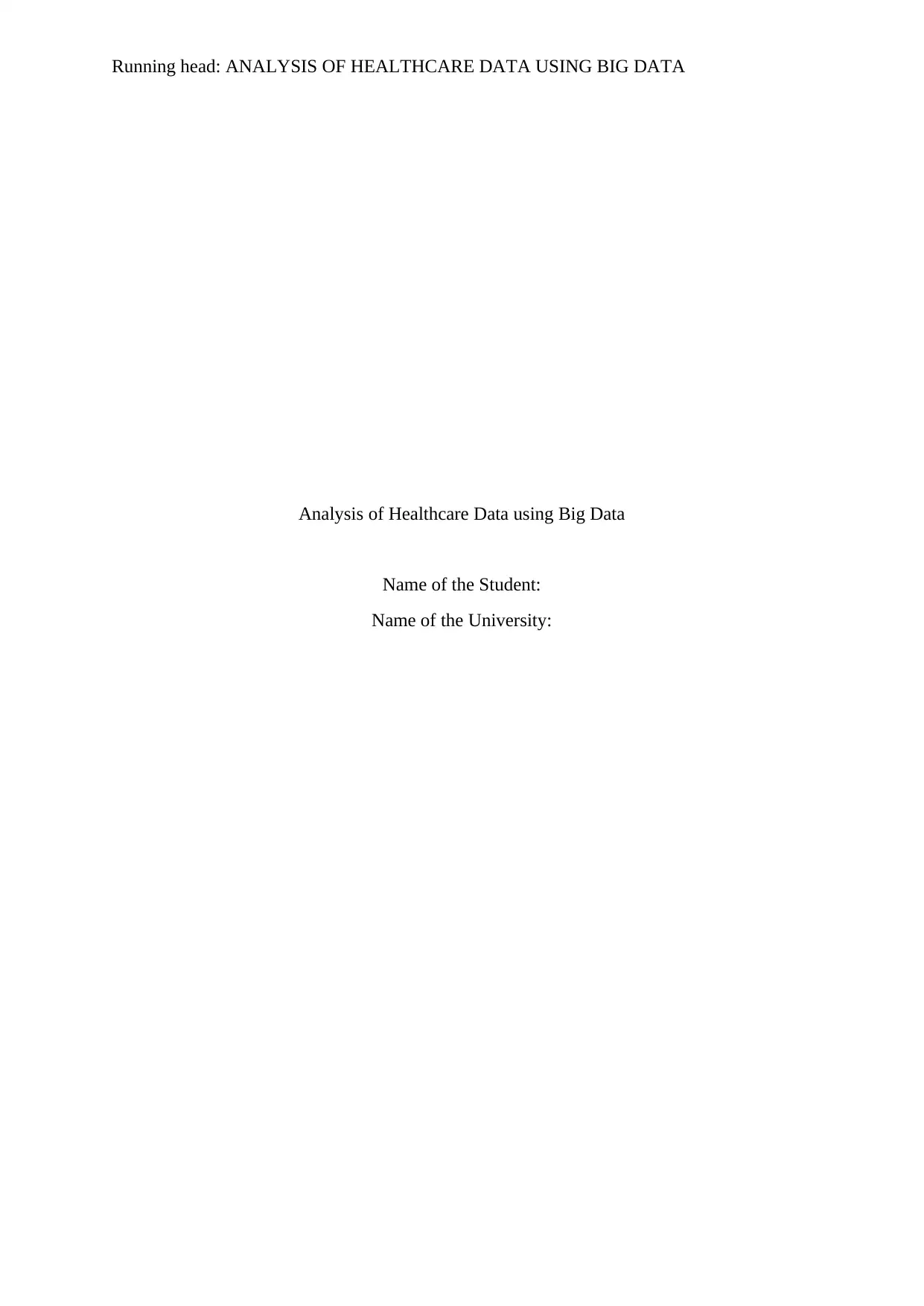
Running head: ANALYSIS OF HEALTHCARE DATA USING BIG DATA
Analysis of Healthcare Data using Big Data
Name of the Student:
Name of the University:
Analysis of Healthcare Data using Big Data
Name of the Student:
Name of the University:
Secure Best Marks with AI Grader
Need help grading? Try our AI Grader for instant feedback on your assignments.
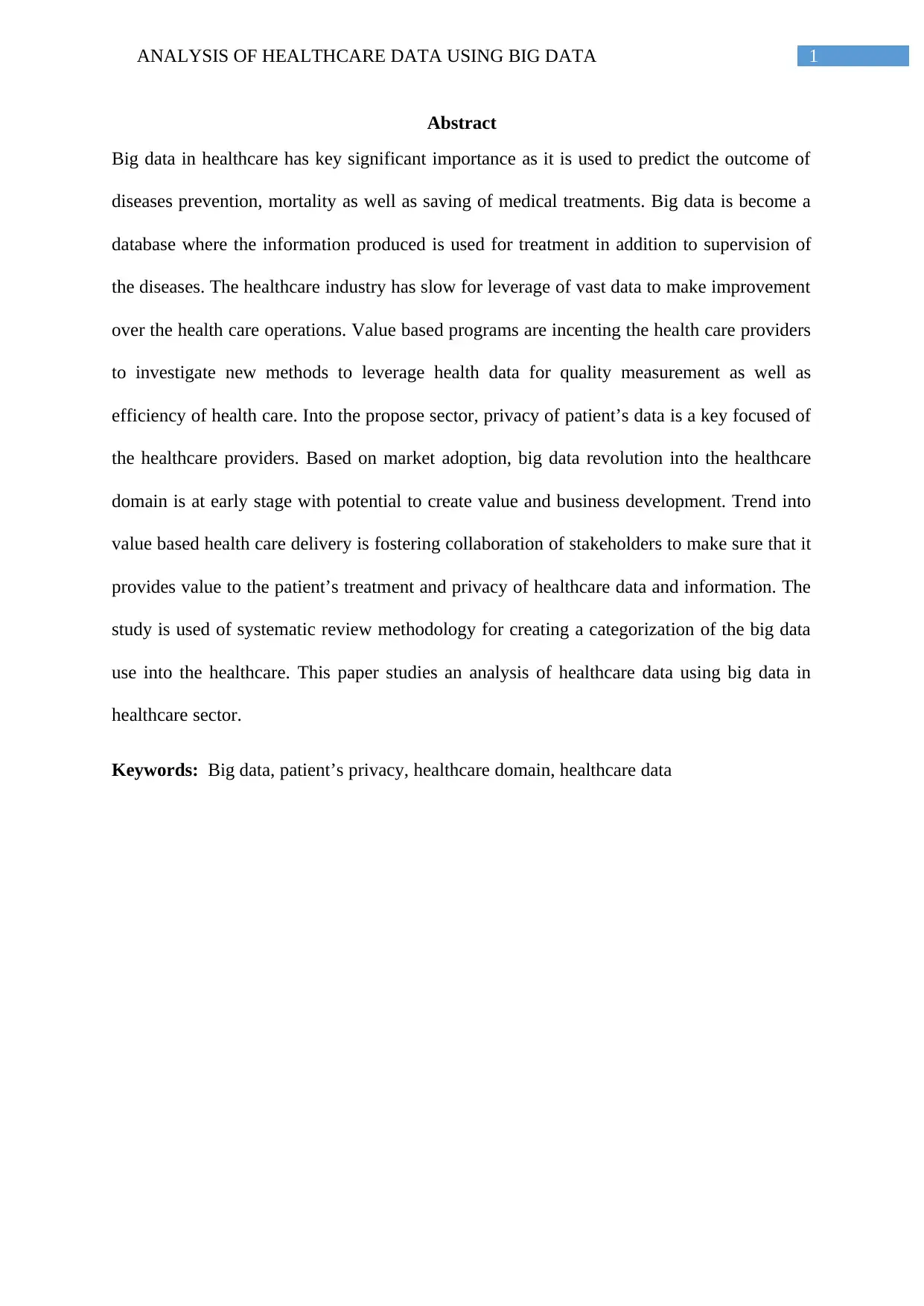
1ANALYSIS OF HEALTHCARE DATA USING BIG DATA
Abstract
Big data in healthcare has key significant importance as it is used to predict the outcome of
diseases prevention, mortality as well as saving of medical treatments. Big data is become a
database where the information produced is used for treatment in addition to supervision of
the diseases. The healthcare industry has slow for leverage of vast data to make improvement
over the health care operations. Value based programs are incenting the health care providers
to investigate new methods to leverage health data for quality measurement as well as
efficiency of health care. Into the propose sector, privacy of patient’s data is a key focused of
the healthcare providers. Based on market adoption, big data revolution into the healthcare
domain is at early stage with potential to create value and business development. Trend into
value based health care delivery is fostering collaboration of stakeholders to make sure that it
provides value to the patient’s treatment and privacy of healthcare data and information. The
study is used of systematic review methodology for creating a categorization of the big data
use into the healthcare. This paper studies an analysis of healthcare data using big data in
healthcare sector.
Keywords: Big data, patient’s privacy, healthcare domain, healthcare data
Abstract
Big data in healthcare has key significant importance as it is used to predict the outcome of
diseases prevention, mortality as well as saving of medical treatments. Big data is become a
database where the information produced is used for treatment in addition to supervision of
the diseases. The healthcare industry has slow for leverage of vast data to make improvement
over the health care operations. Value based programs are incenting the health care providers
to investigate new methods to leverage health data for quality measurement as well as
efficiency of health care. Into the propose sector, privacy of patient’s data is a key focused of
the healthcare providers. Based on market adoption, big data revolution into the healthcare
domain is at early stage with potential to create value and business development. Trend into
value based health care delivery is fostering collaboration of stakeholders to make sure that it
provides value to the patient’s treatment and privacy of healthcare data and information. The
study is used of systematic review methodology for creating a categorization of the big data
use into the healthcare. This paper studies an analysis of healthcare data using big data in
healthcare sector.
Keywords: Big data, patient’s privacy, healthcare domain, healthcare data
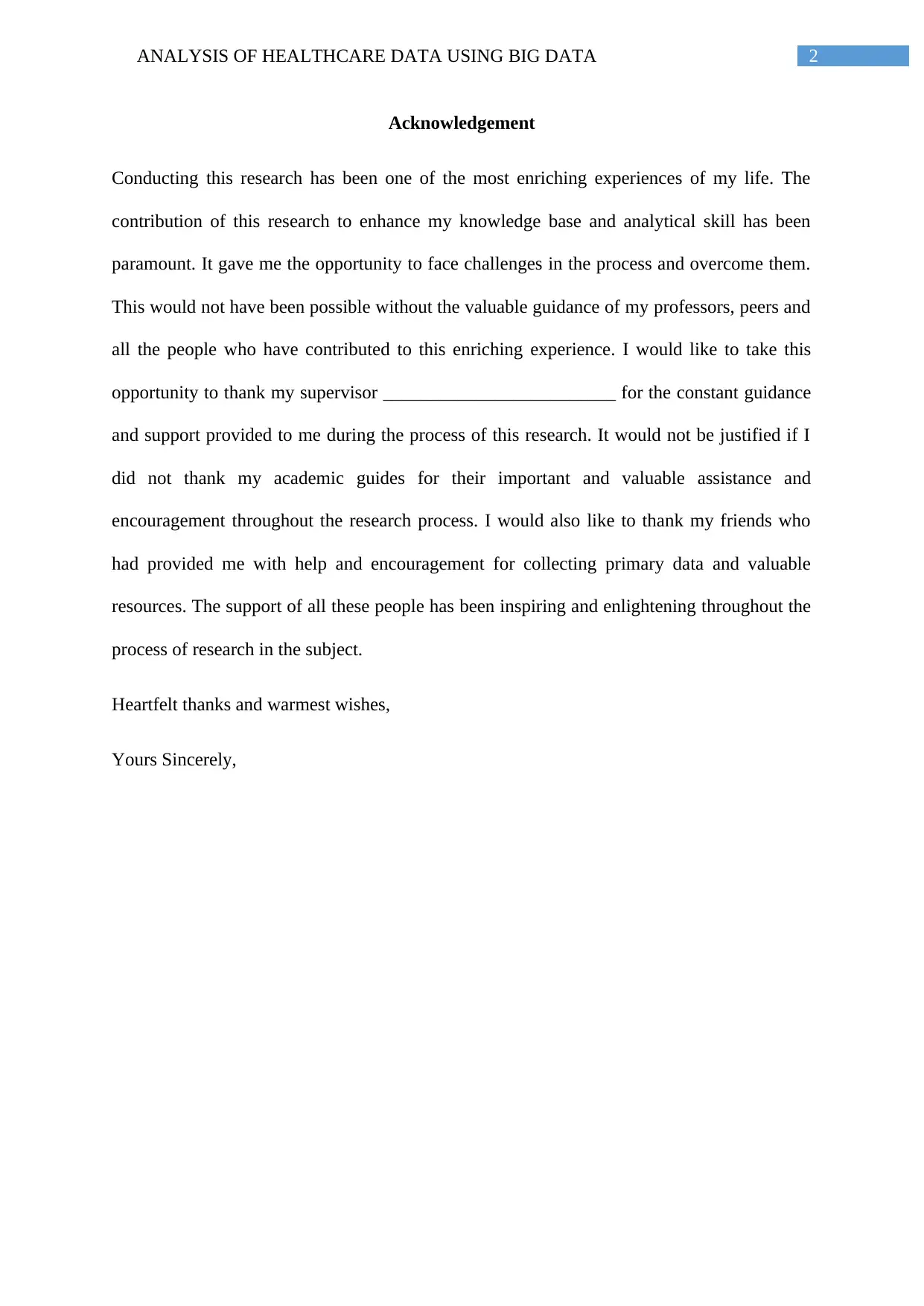
2ANALYSIS OF HEALTHCARE DATA USING BIG DATA
Acknowledgement
Conducting this research has been one of the most enriching experiences of my life. The
contribution of this research to enhance my knowledge base and analytical skill has been
paramount. It gave me the opportunity to face challenges in the process and overcome them.
This would not have been possible without the valuable guidance of my professors, peers and
all the people who have contributed to this enriching experience. I would like to take this
opportunity to thank my supervisor _________________________ for the constant guidance
and support provided to me during the process of this research. It would not be justified if I
did not thank my academic guides for their important and valuable assistance and
encouragement throughout the research process. I would also like to thank my friends who
had provided me with help and encouragement for collecting primary data and valuable
resources. The support of all these people has been inspiring and enlightening throughout the
process of research in the subject.
Heartfelt thanks and warmest wishes,
Yours Sincerely,
Acknowledgement
Conducting this research has been one of the most enriching experiences of my life. The
contribution of this research to enhance my knowledge base and analytical skill has been
paramount. It gave me the opportunity to face challenges in the process and overcome them.
This would not have been possible without the valuable guidance of my professors, peers and
all the people who have contributed to this enriching experience. I would like to take this
opportunity to thank my supervisor _________________________ for the constant guidance
and support provided to me during the process of this research. It would not be justified if I
did not thank my academic guides for their important and valuable assistance and
encouragement throughout the research process. I would also like to thank my friends who
had provided me with help and encouragement for collecting primary data and valuable
resources. The support of all these people has been inspiring and enlightening throughout the
process of research in the subject.
Heartfelt thanks and warmest wishes,
Yours Sincerely,
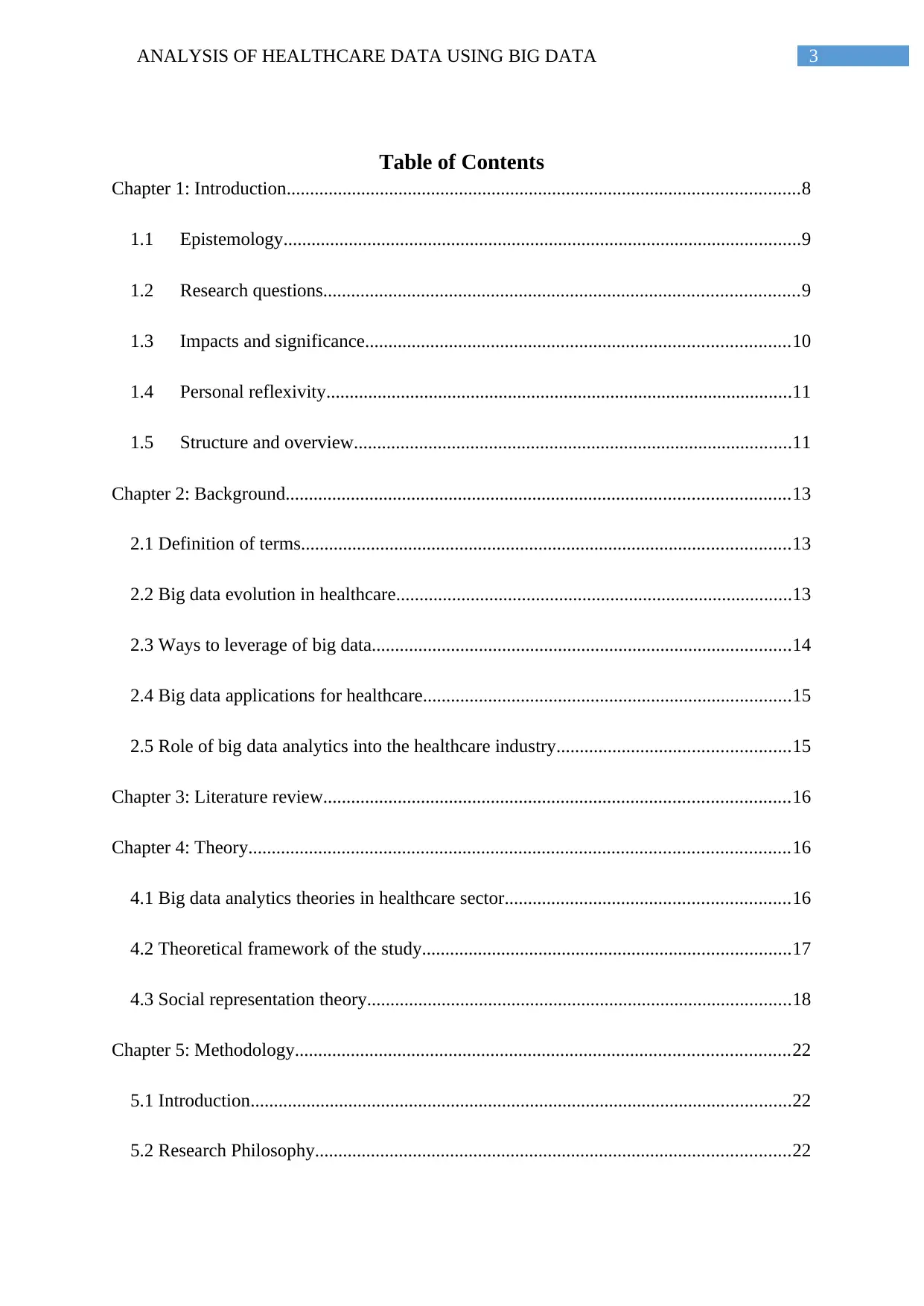
3ANALYSIS OF HEALTHCARE DATA USING BIG DATA
Table of Contents
Chapter 1: Introduction..............................................................................................................8
1.1 Epistemology...............................................................................................................9
1.2 Research questions......................................................................................................9
1.3 Impacts and significance...........................................................................................10
1.4 Personal reflexivity....................................................................................................11
1.5 Structure and overview..............................................................................................11
Chapter 2: Background............................................................................................................13
2.1 Definition of terms.........................................................................................................13
2.2 Big data evolution in healthcare.....................................................................................13
2.3 Ways to leverage of big data..........................................................................................14
2.4 Big data applications for healthcare...............................................................................15
2.5 Role of big data analytics into the healthcare industry..................................................15
Chapter 3: Literature review....................................................................................................16
Chapter 4: Theory....................................................................................................................16
4.1 Big data analytics theories in healthcare sector.............................................................16
4.2 Theoretical framework of the study...............................................................................17
4.3 Social representation theory...........................................................................................18
Chapter 5: Methodology..........................................................................................................22
5.1 Introduction....................................................................................................................22
5.2 Research Philosophy......................................................................................................22
Table of Contents
Chapter 1: Introduction..............................................................................................................8
1.1 Epistemology...............................................................................................................9
1.2 Research questions......................................................................................................9
1.3 Impacts and significance...........................................................................................10
1.4 Personal reflexivity....................................................................................................11
1.5 Structure and overview..............................................................................................11
Chapter 2: Background............................................................................................................13
2.1 Definition of terms.........................................................................................................13
2.2 Big data evolution in healthcare.....................................................................................13
2.3 Ways to leverage of big data..........................................................................................14
2.4 Big data applications for healthcare...............................................................................15
2.5 Role of big data analytics into the healthcare industry..................................................15
Chapter 3: Literature review....................................................................................................16
Chapter 4: Theory....................................................................................................................16
4.1 Big data analytics theories in healthcare sector.............................................................16
4.2 Theoretical framework of the study...............................................................................17
4.3 Social representation theory...........................................................................................18
Chapter 5: Methodology..........................................................................................................22
5.1 Introduction....................................................................................................................22
5.2 Research Philosophy......................................................................................................22
Secure Best Marks with AI Grader
Need help grading? Try our AI Grader for instant feedback on your assignments.
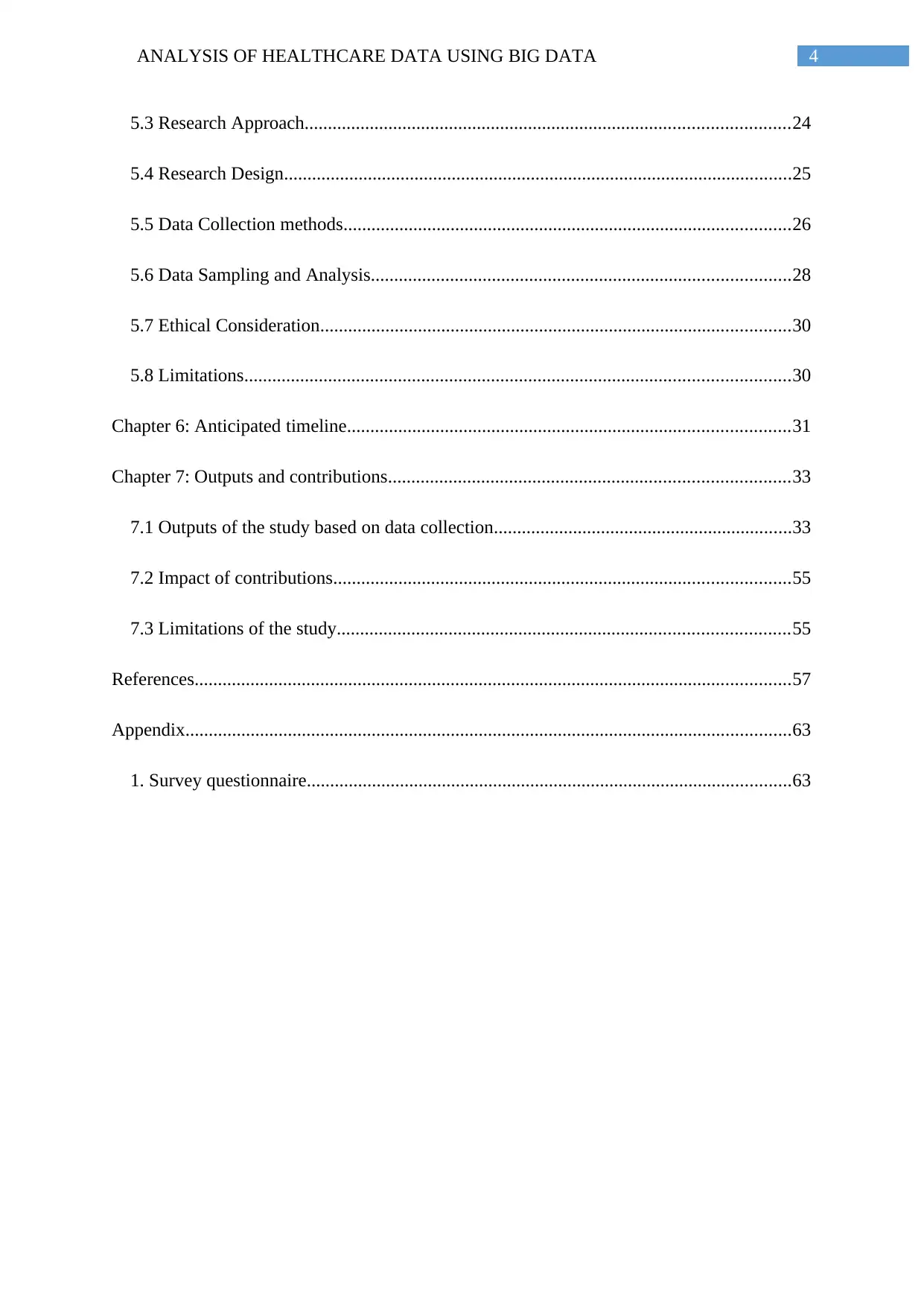
4ANALYSIS OF HEALTHCARE DATA USING BIG DATA
5.3 Research Approach........................................................................................................24
5.4 Research Design.............................................................................................................25
5.5 Data Collection methods................................................................................................26
5.6 Data Sampling and Analysis..........................................................................................28
5.7 Ethical Consideration.....................................................................................................30
5.8 Limitations.....................................................................................................................30
Chapter 6: Anticipated timeline...............................................................................................31
Chapter 7: Outputs and contributions......................................................................................33
7.1 Outputs of the study based on data collection................................................................33
7.2 Impact of contributions..................................................................................................55
7.3 Limitations of the study.................................................................................................55
References................................................................................................................................57
Appendix..................................................................................................................................63
1. Survey questionnaire........................................................................................................63
5.3 Research Approach........................................................................................................24
5.4 Research Design.............................................................................................................25
5.5 Data Collection methods................................................................................................26
5.6 Data Sampling and Analysis..........................................................................................28
5.7 Ethical Consideration.....................................................................................................30
5.8 Limitations.....................................................................................................................30
Chapter 6: Anticipated timeline...............................................................................................31
Chapter 7: Outputs and contributions......................................................................................33
7.1 Outputs of the study based on data collection................................................................33
7.2 Impact of contributions..................................................................................................55
7.3 Limitations of the study.................................................................................................55
References................................................................................................................................57
Appendix..................................................................................................................................63
1. Survey questionnaire........................................................................................................63
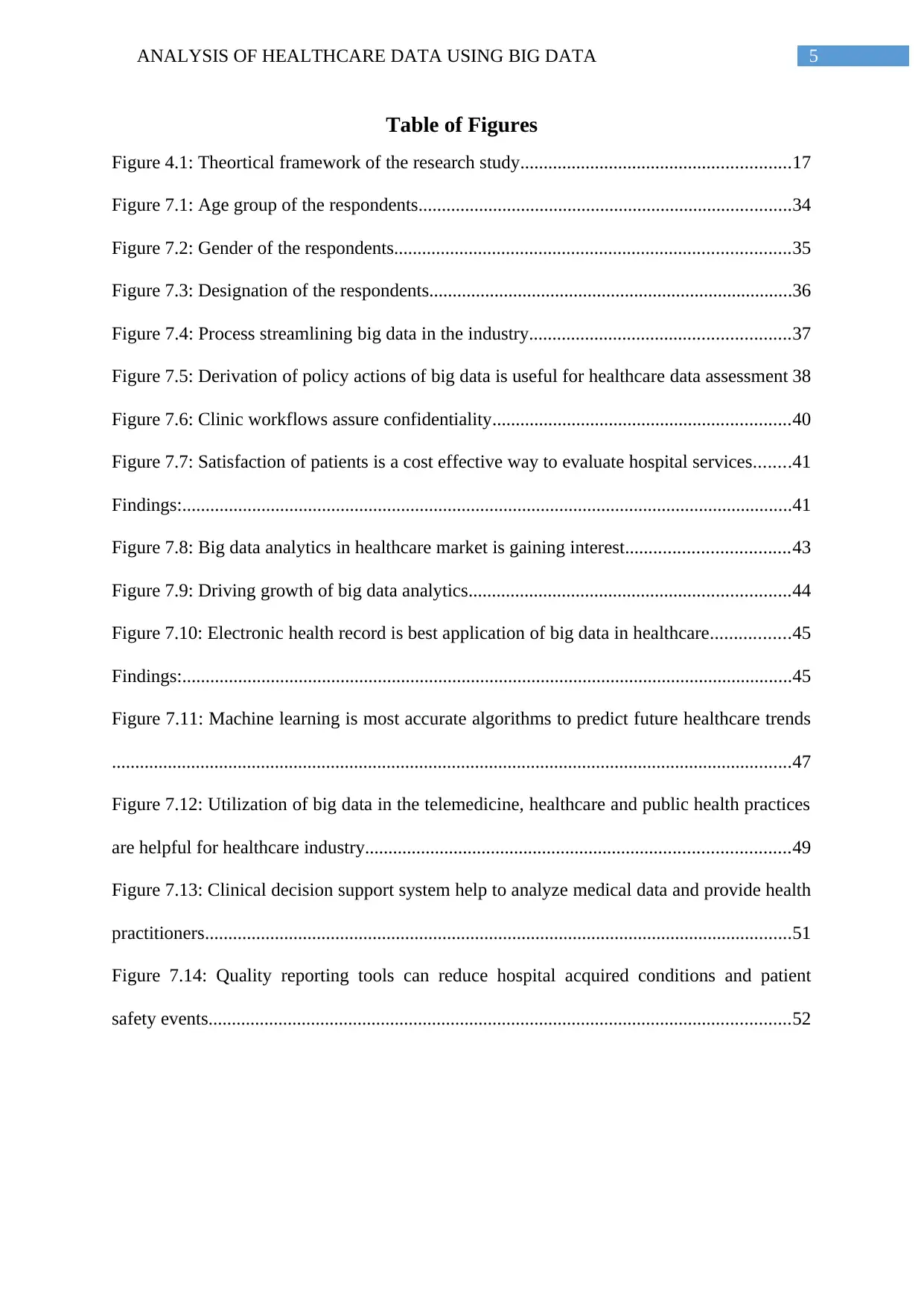
5ANALYSIS OF HEALTHCARE DATA USING BIG DATA
Table of Figures
Figure 4.1: Theortical framework of the research study..........................................................17
Figure 7.1: Age group of the respondents................................................................................34
Figure 7.2: Gender of the respondents.....................................................................................35
Figure 7.3: Designation of the respondents..............................................................................36
Figure 7.4: Process streamlining big data in the industry........................................................37
Figure 7.5: Derivation of policy actions of big data is useful for healthcare data assessment 38
Figure 7.6: Clinic workflows assure confidentiality................................................................40
Figure 7.7: Satisfaction of patients is a cost effective way to evaluate hospital services........41
Findings:...................................................................................................................................41
Figure 7.8: Big data analytics in healthcare market is gaining interest...................................43
Figure 7.9: Driving growth of big data analytics.....................................................................44
Figure 7.10: Electronic health record is best application of big data in healthcare.................45
Findings:...................................................................................................................................45
Figure 7.11: Machine learning is most accurate algorithms to predict future healthcare trends
..................................................................................................................................................47
Figure 7.12: Utilization of big data in the telemedicine, healthcare and public health practices
are helpful for healthcare industry...........................................................................................49
Figure 7.13: Clinical decision support system help to analyze medical data and provide health
practitioners..............................................................................................................................51
Figure 7.14: Quality reporting tools can reduce hospital acquired conditions and patient
safety events.............................................................................................................................52
Table of Figures
Figure 4.1: Theortical framework of the research study..........................................................17
Figure 7.1: Age group of the respondents................................................................................34
Figure 7.2: Gender of the respondents.....................................................................................35
Figure 7.3: Designation of the respondents..............................................................................36
Figure 7.4: Process streamlining big data in the industry........................................................37
Figure 7.5: Derivation of policy actions of big data is useful for healthcare data assessment 38
Figure 7.6: Clinic workflows assure confidentiality................................................................40
Figure 7.7: Satisfaction of patients is a cost effective way to evaluate hospital services........41
Findings:...................................................................................................................................41
Figure 7.8: Big data analytics in healthcare market is gaining interest...................................43
Figure 7.9: Driving growth of big data analytics.....................................................................44
Figure 7.10: Electronic health record is best application of big data in healthcare.................45
Findings:...................................................................................................................................45
Figure 7.11: Machine learning is most accurate algorithms to predict future healthcare trends
..................................................................................................................................................47
Figure 7.12: Utilization of big data in the telemedicine, healthcare and public health practices
are helpful for healthcare industry...........................................................................................49
Figure 7.13: Clinical decision support system help to analyze medical data and provide health
practitioners..............................................................................................................................51
Figure 7.14: Quality reporting tools can reduce hospital acquired conditions and patient
safety events.............................................................................................................................52
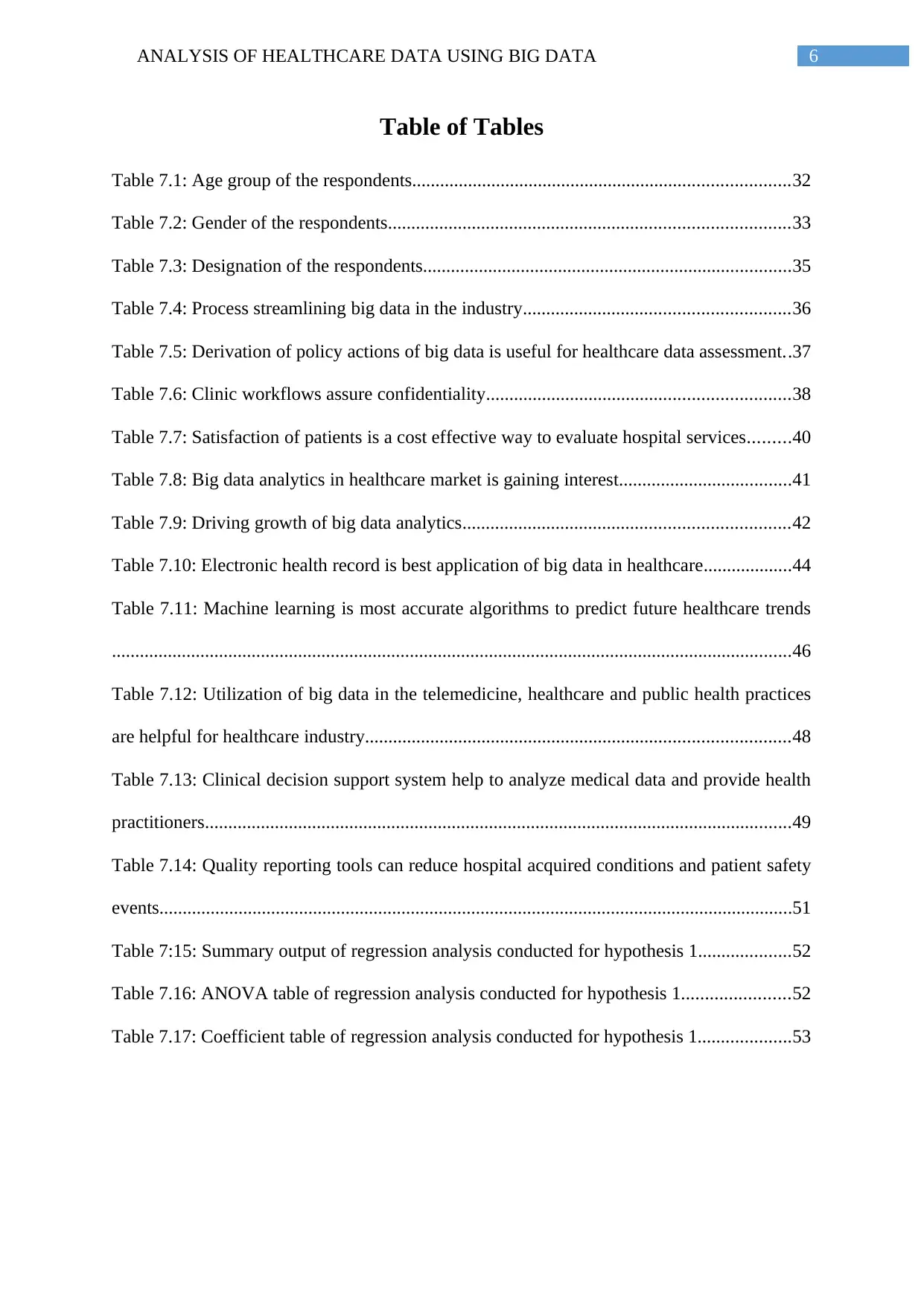
6ANALYSIS OF HEALTHCARE DATA USING BIG DATA
Table of Tables
Table 7.1: Age group of the respondents.................................................................................32
Table 7.2: Gender of the respondents......................................................................................33
Table 7.3: Designation of the respondents...............................................................................35
Table 7.4: Process streamlining big data in the industry.........................................................36
Table 7.5: Derivation of policy actions of big data is useful for healthcare data assessment..37
Table 7.6: Clinic workflows assure confidentiality.................................................................38
Table 7.7: Satisfaction of patients is a cost effective way to evaluate hospital services.........40
Table 7.8: Big data analytics in healthcare market is gaining interest.....................................41
Table 7.9: Driving growth of big data analytics......................................................................42
Table 7.10: Electronic health record is best application of big data in healthcare...................44
Table 7.11: Machine learning is most accurate algorithms to predict future healthcare trends
..................................................................................................................................................46
Table 7.12: Utilization of big data in the telemedicine, healthcare and public health practices
are helpful for healthcare industry...........................................................................................48
Table 7.13: Clinical decision support system help to analyze medical data and provide health
practitioners..............................................................................................................................49
Table 7.14: Quality reporting tools can reduce hospital acquired conditions and patient safety
events........................................................................................................................................51
Table 7:15: Summary output of regression analysis conducted for hypothesis 1....................52
Table 7.16: ANOVA table of regression analysis conducted for hypothesis 1.......................52
Table 7.17: Coefficient table of regression analysis conducted for hypothesis 1....................53
Table of Tables
Table 7.1: Age group of the respondents.................................................................................32
Table 7.2: Gender of the respondents......................................................................................33
Table 7.3: Designation of the respondents...............................................................................35
Table 7.4: Process streamlining big data in the industry.........................................................36
Table 7.5: Derivation of policy actions of big data is useful for healthcare data assessment..37
Table 7.6: Clinic workflows assure confidentiality.................................................................38
Table 7.7: Satisfaction of patients is a cost effective way to evaluate hospital services.........40
Table 7.8: Big data analytics in healthcare market is gaining interest.....................................41
Table 7.9: Driving growth of big data analytics......................................................................42
Table 7.10: Electronic health record is best application of big data in healthcare...................44
Table 7.11: Machine learning is most accurate algorithms to predict future healthcare trends
..................................................................................................................................................46
Table 7.12: Utilization of big data in the telemedicine, healthcare and public health practices
are helpful for healthcare industry...........................................................................................48
Table 7.13: Clinical decision support system help to analyze medical data and provide health
practitioners..............................................................................................................................49
Table 7.14: Quality reporting tools can reduce hospital acquired conditions and patient safety
events........................................................................................................................................51
Table 7:15: Summary output of regression analysis conducted for hypothesis 1....................52
Table 7.16: ANOVA table of regression analysis conducted for hypothesis 1.......................52
Table 7.17: Coefficient table of regression analysis conducted for hypothesis 1....................53
Paraphrase This Document
Need a fresh take? Get an instant paraphrase of this document with our AI Paraphraser
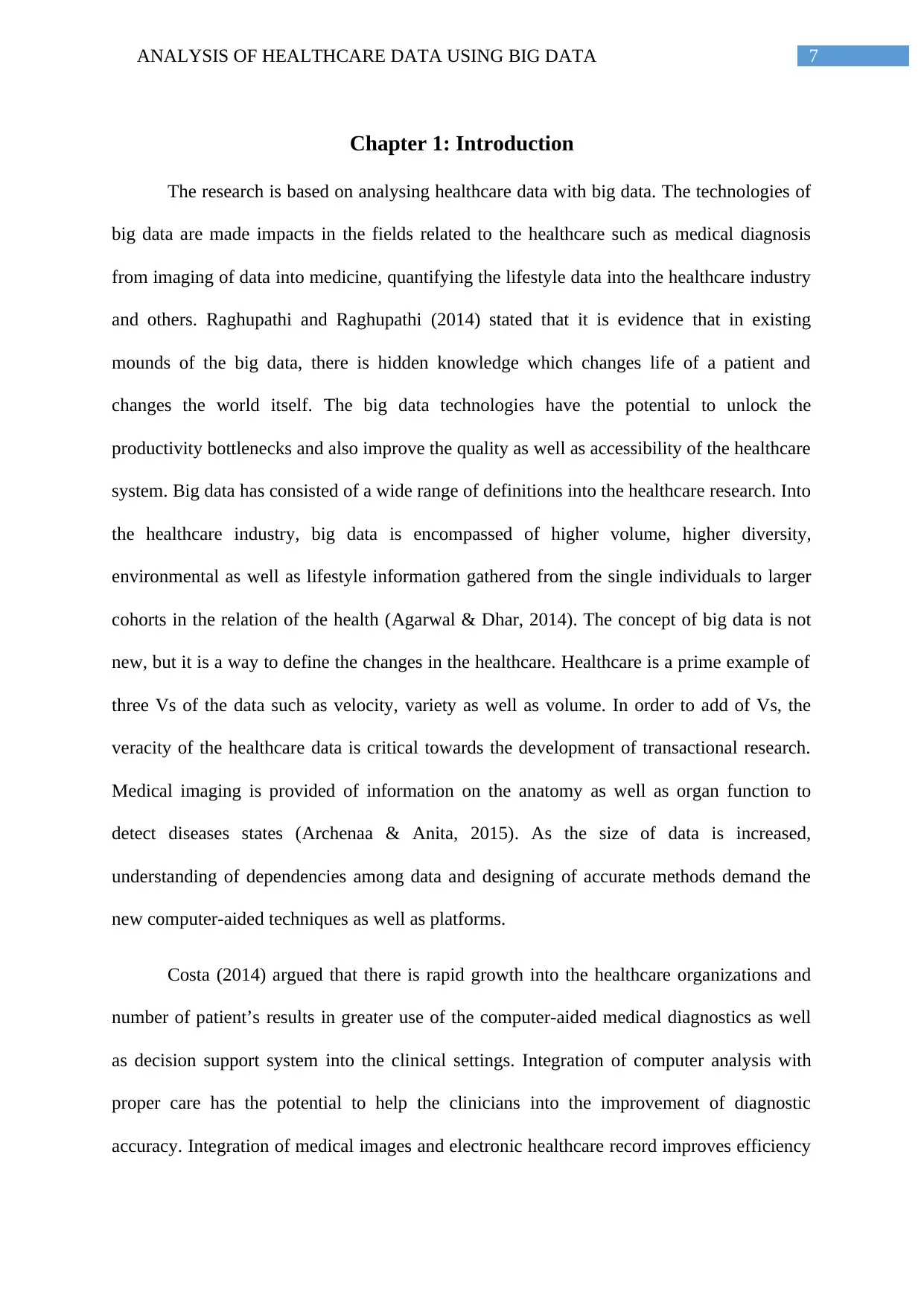
7ANALYSIS OF HEALTHCARE DATA USING BIG DATA
Chapter 1: Introduction
The research is based on analysing healthcare data with big data. The technologies of
big data are made impacts in the fields related to the healthcare such as medical diagnosis
from imaging of data into medicine, quantifying the lifestyle data into the healthcare industry
and others. Raghupathi and Raghupathi (2014) stated that it is evidence that in existing
mounds of the big data, there is hidden knowledge which changes life of a patient and
changes the world itself. The big data technologies have the potential to unlock the
productivity bottlenecks and also improve the quality as well as accessibility of the healthcare
system. Big data has consisted of a wide range of definitions into the healthcare research. Into
the healthcare industry, big data is encompassed of higher volume, higher diversity,
environmental as well as lifestyle information gathered from the single individuals to larger
cohorts in the relation of the health (Agarwal & Dhar, 2014). The concept of big data is not
new, but it is a way to define the changes in the healthcare. Healthcare is a prime example of
three Vs of the data such as velocity, variety as well as volume. In order to add of Vs, the
veracity of the healthcare data is critical towards the development of transactional research.
Medical imaging is provided of information on the anatomy as well as organ function to
detect diseases states (Archenaa & Anita, 2015). As the size of data is increased,
understanding of dependencies among data and designing of accurate methods demand the
new computer-aided techniques as well as platforms.
Costa (2014) argued that there is rapid growth into the healthcare organizations and
number of patient’s results in greater use of the computer-aided medical diagnostics as well
as decision support system into the clinical settings. Integration of computer analysis with
proper care has the potential to help the clinicians into the improvement of diagnostic
accuracy. Integration of medical images and electronic healthcare record improves efficiency
Chapter 1: Introduction
The research is based on analysing healthcare data with big data. The technologies of
big data are made impacts in the fields related to the healthcare such as medical diagnosis
from imaging of data into medicine, quantifying the lifestyle data into the healthcare industry
and others. Raghupathi and Raghupathi (2014) stated that it is evidence that in existing
mounds of the big data, there is hidden knowledge which changes life of a patient and
changes the world itself. The big data technologies have the potential to unlock the
productivity bottlenecks and also improve the quality as well as accessibility of the healthcare
system. Big data has consisted of a wide range of definitions into the healthcare research. Into
the healthcare industry, big data is encompassed of higher volume, higher diversity,
environmental as well as lifestyle information gathered from the single individuals to larger
cohorts in the relation of the health (Agarwal & Dhar, 2014). The concept of big data is not
new, but it is a way to define the changes in the healthcare. Healthcare is a prime example of
three Vs of the data such as velocity, variety as well as volume. In order to add of Vs, the
veracity of the healthcare data is critical towards the development of transactional research.
Medical imaging is provided of information on the anatomy as well as organ function to
detect diseases states (Archenaa & Anita, 2015). As the size of data is increased,
understanding of dependencies among data and designing of accurate methods demand the
new computer-aided techniques as well as platforms.
Costa (2014) argued that there is rapid growth into the healthcare organizations and
number of patient’s results in greater use of the computer-aided medical diagnostics as well
as decision support system into the clinical settings. Integration of computer analysis with
proper care has the potential to help the clinicians into the improvement of diagnostic
accuracy. Integration of medical images and electronic healthcare record improves efficiency
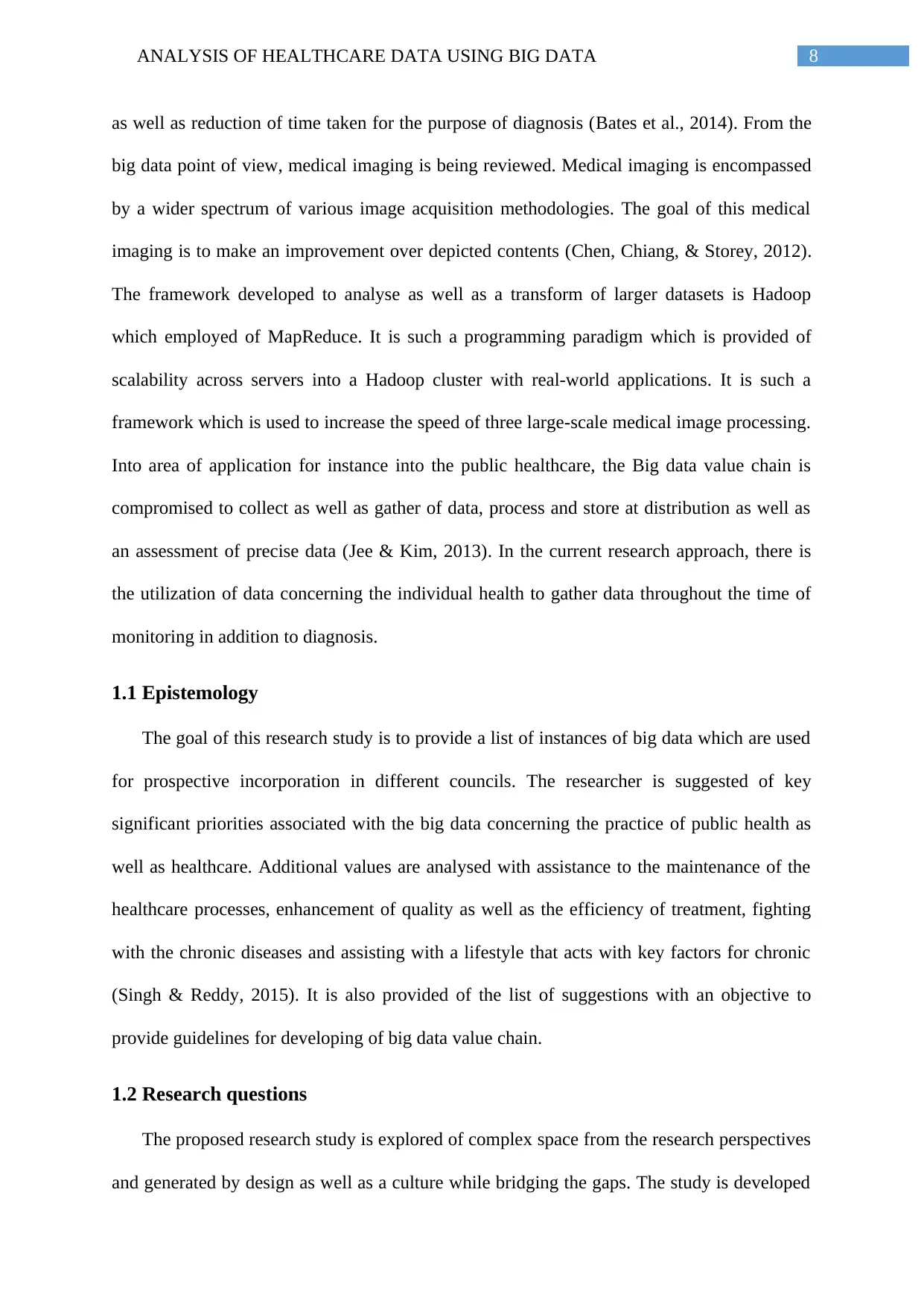
8ANALYSIS OF HEALTHCARE DATA USING BIG DATA
as well as reduction of time taken for the purpose of diagnosis (Bates et al., 2014). From the
big data point of view, medical imaging is being reviewed. Medical imaging is encompassed
by a wider spectrum of various image acquisition methodologies. The goal of this medical
imaging is to make an improvement over depicted contents (Chen, Chiang, & Storey, 2012).
The framework developed to analyse as well as a transform of larger datasets is Hadoop
which employed of MapReduce. It is such a programming paradigm which is provided of
scalability across servers into a Hadoop cluster with real-world applications. It is such a
framework which is used to increase the speed of three large-scale medical image processing.
Into area of application for instance into the public healthcare, the Big data value chain is
compromised to collect as well as gather of data, process and store at distribution as well as
an assessment of precise data (Jee & Kim, 2013). In the current research approach, there is
the utilization of data concerning the individual health to gather data throughout the time of
monitoring in addition to diagnosis.
1.1 Epistemology
The goal of this research study is to provide a list of instances of big data which are used
for prospective incorporation in different councils. The researcher is suggested of key
significant priorities associated with the big data concerning the practice of public health as
well as healthcare. Additional values are analysed with assistance to the maintenance of the
healthcare processes, enhancement of quality as well as the efficiency of treatment, fighting
with the chronic diseases and assisting with a lifestyle that acts with key factors for chronic
(Singh & Reddy, 2015). It is also provided of the list of suggestions with an objective to
provide guidelines for developing of big data value chain.
1.2 Research questions
The proposed research study is explored of complex space from the research perspectives
and generated by design as well as a culture while bridging the gaps. The study is developed
as well as reduction of time taken for the purpose of diagnosis (Bates et al., 2014). From the
big data point of view, medical imaging is being reviewed. Medical imaging is encompassed
by a wider spectrum of various image acquisition methodologies. The goal of this medical
imaging is to make an improvement over depicted contents (Chen, Chiang, & Storey, 2012).
The framework developed to analyse as well as a transform of larger datasets is Hadoop
which employed of MapReduce. It is such a programming paradigm which is provided of
scalability across servers into a Hadoop cluster with real-world applications. It is such a
framework which is used to increase the speed of three large-scale medical image processing.
Into area of application for instance into the public healthcare, the Big data value chain is
compromised to collect as well as gather of data, process and store at distribution as well as
an assessment of precise data (Jee & Kim, 2013). In the current research approach, there is
the utilization of data concerning the individual health to gather data throughout the time of
monitoring in addition to diagnosis.
1.1 Epistemology
The goal of this research study is to provide a list of instances of big data which are used
for prospective incorporation in different councils. The researcher is suggested of key
significant priorities associated with the big data concerning the practice of public health as
well as healthcare. Additional values are analysed with assistance to the maintenance of the
healthcare processes, enhancement of quality as well as the efficiency of treatment, fighting
with the chronic diseases and assisting with a lifestyle that acts with key factors for chronic
(Singh & Reddy, 2015). It is also provided of the list of suggestions with an objective to
provide guidelines for developing of big data value chain.
1.2 Research questions
The proposed research study is explored of complex space from the research perspectives
and generated by design as well as a culture while bridging the gaps. The study is developed
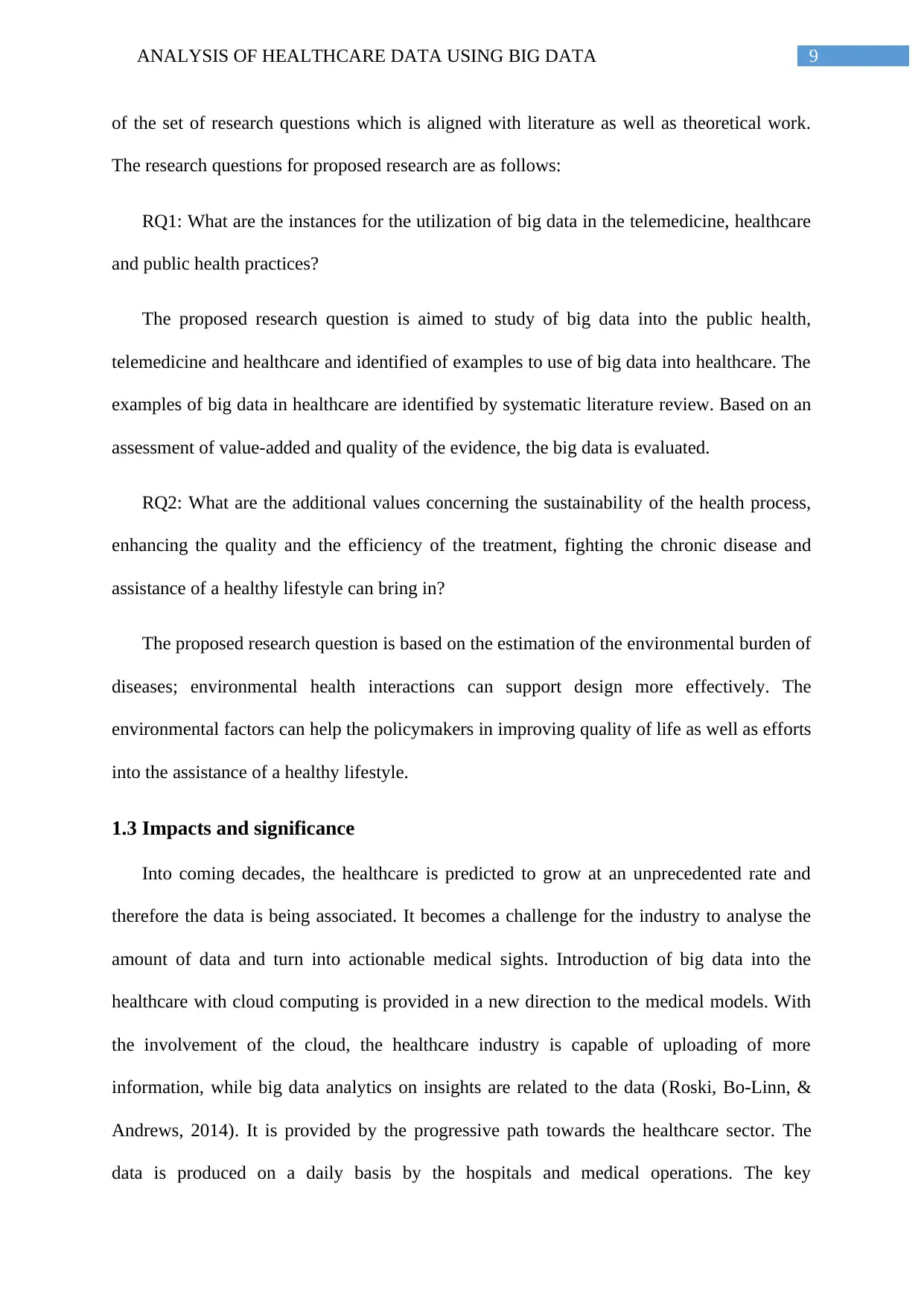
9ANALYSIS OF HEALTHCARE DATA USING BIG DATA
of the set of research questions which is aligned with literature as well as theoretical work.
The research questions for proposed research are as follows:
RQ1: What are the instances for the utilization of big data in the telemedicine, healthcare
and public health practices?
The proposed research question is aimed to study of big data into the public health,
telemedicine and healthcare and identified of examples to use of big data into healthcare. The
examples of big data in healthcare are identified by systematic literature review. Based on an
assessment of value-added and quality of the evidence, the big data is evaluated.
RQ2: What are the additional values concerning the sustainability of the health process,
enhancing the quality and the efficiency of the treatment, fighting the chronic disease and
assistance of a healthy lifestyle can bring in?
The proposed research question is based on the estimation of the environmental burden of
diseases; environmental health interactions can support design more effectively. The
environmental factors can help the policymakers in improving quality of life as well as efforts
into the assistance of a healthy lifestyle.
1.3 Impacts and significance
Into coming decades, the healthcare is predicted to grow at an unprecedented rate and
therefore the data is being associated. It becomes a challenge for the industry to analyse the
amount of data and turn into actionable medical sights. Introduction of big data into the
healthcare with cloud computing is provided in a new direction to the medical models. With
the involvement of the cloud, the healthcare industry is capable of uploading of more
information, while big data analytics on insights are related to the data (Roski, Bo-Linn, &
Andrews, 2014). It is provided by the progressive path towards the healthcare sector. The
data is produced on a daily basis by the hospitals and medical operations. The key
of the set of research questions which is aligned with literature as well as theoretical work.
The research questions for proposed research are as follows:
RQ1: What are the instances for the utilization of big data in the telemedicine, healthcare
and public health practices?
The proposed research question is aimed to study of big data into the public health,
telemedicine and healthcare and identified of examples to use of big data into healthcare. The
examples of big data in healthcare are identified by systematic literature review. Based on an
assessment of value-added and quality of the evidence, the big data is evaluated.
RQ2: What are the additional values concerning the sustainability of the health process,
enhancing the quality and the efficiency of the treatment, fighting the chronic disease and
assistance of a healthy lifestyle can bring in?
The proposed research question is based on the estimation of the environmental burden of
diseases; environmental health interactions can support design more effectively. The
environmental factors can help the policymakers in improving quality of life as well as efforts
into the assistance of a healthy lifestyle.
1.3 Impacts and significance
Into coming decades, the healthcare is predicted to grow at an unprecedented rate and
therefore the data is being associated. It becomes a challenge for the industry to analyse the
amount of data and turn into actionable medical sights. Introduction of big data into the
healthcare with cloud computing is provided in a new direction to the medical models. With
the involvement of the cloud, the healthcare industry is capable of uploading of more
information, while big data analytics on insights are related to the data (Roski, Bo-Linn, &
Andrews, 2014). It is provided by the progressive path towards the healthcare sector. The
data is produced on a daily basis by the hospitals and medical operations. The key
Secure Best Marks with AI Grader
Need help grading? Try our AI Grader for instant feedback on your assignments.

10ANALYSIS OF HEALTHCARE DATA USING BIG DATA
significance of big data is brought up sophisticated methods to consolidate information from
the sources. The focus of this study is to provide relevant as well as updated information to
the doctors in real time while it is consulted with the patients. The cloud based big data is
stored and analyzed of data from resources (Wang, Kung, & Byrd, 2018). The medical data
of patients are personal and required to protect as well as security against losses. With
improved computing technology, big data into the healthcare sector and its privacy are at the
highest priority.
1.4 Personal reflexivity
With reflexivity into part of the investigator is well established as a tool into the
qualitative research, it is a key significant requirement because of interdisciplinary nature of
this study. Due to convergence nature of this study, I have addressed the goals and research
questions. I have examined that there is fast expanding field into the big data analytics is
started to play a role in the evolution of the healthcare practices (Chen et al., 2017). It is also
provided of tools for managing and analysing larger volumes for unstructured data by the
healthcare system. I have applied big data analytics to aid process towards delivery
exploration. Potential areas of research in this field can provide an impact on the healthcare.
Medical imaging is encompassed by a wider spectrum of various image acquisition
methodologies used for the clinical applications (Lo’ai et al., 2017). I have estimated that
volume, as well as a variety of the medical data, is analyzing the big challenge. It is advanced
into medical imaging make individualized care practical and provided of qualitative
information in various medical applications. Huge space is required for storage of data in
addition to analysis, findings with map along with dependencies among various data.
1.5 Structure and overview
The proposed outline of this research study is based on addressing the research questions
and analysing the healthcare data with big data. There are some sections of this study such as:
significance of big data is brought up sophisticated methods to consolidate information from
the sources. The focus of this study is to provide relevant as well as updated information to
the doctors in real time while it is consulted with the patients. The cloud based big data is
stored and analyzed of data from resources (Wang, Kung, & Byrd, 2018). The medical data
of patients are personal and required to protect as well as security against losses. With
improved computing technology, big data into the healthcare sector and its privacy are at the
highest priority.
1.4 Personal reflexivity
With reflexivity into part of the investigator is well established as a tool into the
qualitative research, it is a key significant requirement because of interdisciplinary nature of
this study. Due to convergence nature of this study, I have addressed the goals and research
questions. I have examined that there is fast expanding field into the big data analytics is
started to play a role in the evolution of the healthcare practices (Chen et al., 2017). It is also
provided of tools for managing and analysing larger volumes for unstructured data by the
healthcare system. I have applied big data analytics to aid process towards delivery
exploration. Potential areas of research in this field can provide an impact on the healthcare.
Medical imaging is encompassed by a wider spectrum of various image acquisition
methodologies used for the clinical applications (Lo’ai et al., 2017). I have estimated that
volume, as well as a variety of the medical data, is analyzing the big challenge. It is advanced
into medical imaging make individualized care practical and provided of qualitative
information in various medical applications. Huge space is required for storage of data in
addition to analysis, findings with map along with dependencies among various data.
1.5 Structure and overview
The proposed outline of this research study is based on addressing the research questions
and analysing the healthcare data with big data. There are some sections of this study such as:
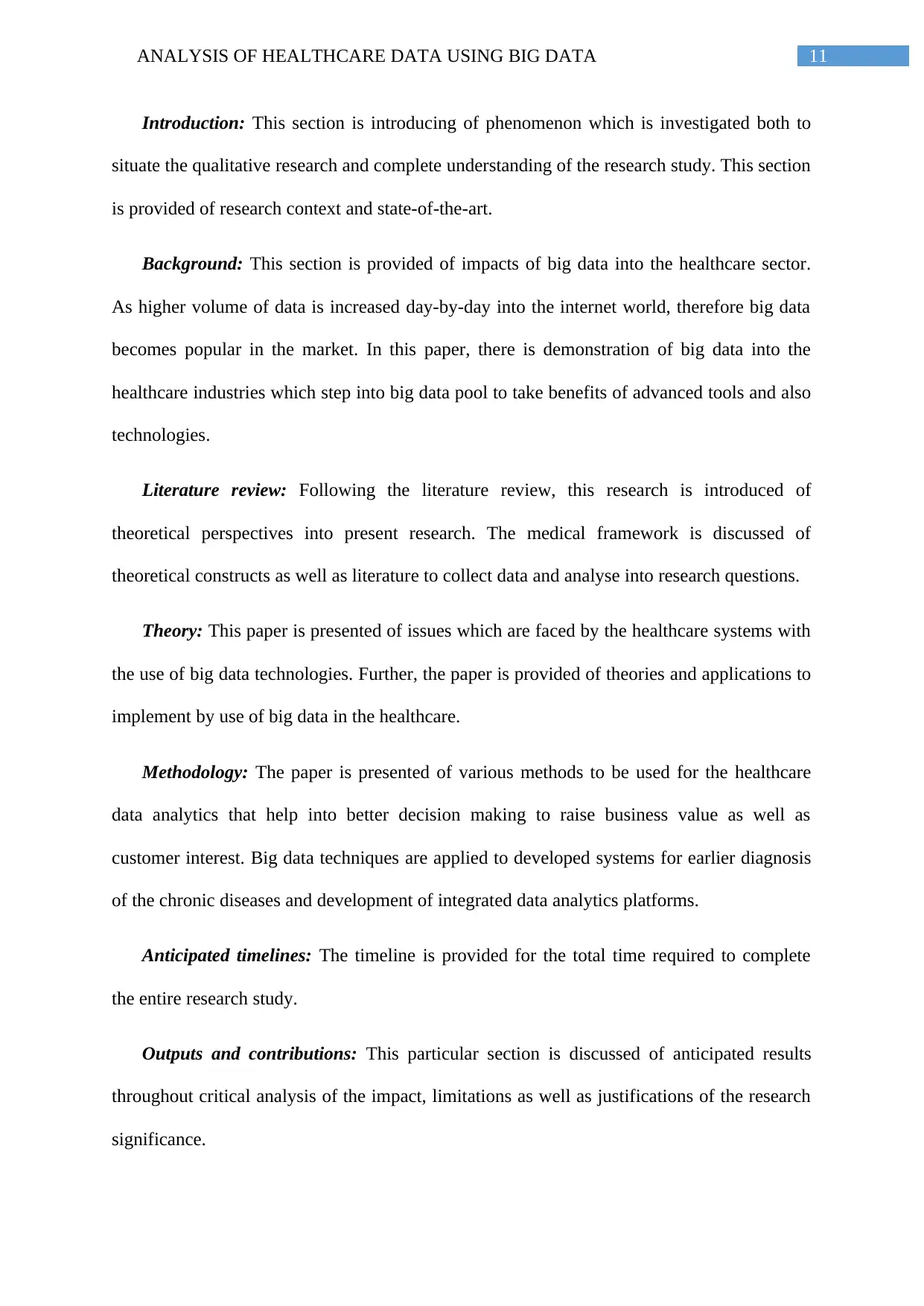
11ANALYSIS OF HEALTHCARE DATA USING BIG DATA
Introduction: This section is introducing of phenomenon which is investigated both to
situate the qualitative research and complete understanding of the research study. This section
is provided of research context and state-of-the-art.
Background: This section is provided of impacts of big data into the healthcare sector.
As higher volume of data is increased day-by-day into the internet world, therefore big data
becomes popular in the market. In this paper, there is demonstration of big data into the
healthcare industries which step into big data pool to take benefits of advanced tools and also
technologies.
Literature review: Following the literature review, this research is introduced of
theoretical perspectives into present research. The medical framework is discussed of
theoretical constructs as well as literature to collect data and analyse into research questions.
Theory: This paper is presented of issues which are faced by the healthcare systems with
the use of big data technologies. Further, the paper is provided of theories and applications to
implement by use of big data in the healthcare.
Methodology: The paper is presented of various methods to be used for the healthcare
data analytics that help into better decision making to raise business value as well as
customer interest. Big data techniques are applied to developed systems for earlier diagnosis
of the chronic diseases and development of integrated data analytics platforms.
Anticipated timelines: The timeline is provided for the total time required to complete
the entire research study.
Outputs and contributions: This particular section is discussed of anticipated results
throughout critical analysis of the impact, limitations as well as justifications of the research
significance.
Introduction: This section is introducing of phenomenon which is investigated both to
situate the qualitative research and complete understanding of the research study. This section
is provided of research context and state-of-the-art.
Background: This section is provided of impacts of big data into the healthcare sector.
As higher volume of data is increased day-by-day into the internet world, therefore big data
becomes popular in the market. In this paper, there is demonstration of big data into the
healthcare industries which step into big data pool to take benefits of advanced tools and also
technologies.
Literature review: Following the literature review, this research is introduced of
theoretical perspectives into present research. The medical framework is discussed of
theoretical constructs as well as literature to collect data and analyse into research questions.
Theory: This paper is presented of issues which are faced by the healthcare systems with
the use of big data technologies. Further, the paper is provided of theories and applications to
implement by use of big data in the healthcare.
Methodology: The paper is presented of various methods to be used for the healthcare
data analytics that help into better decision making to raise business value as well as
customer interest. Big data techniques are applied to developed systems for earlier diagnosis
of the chronic diseases and development of integrated data analytics platforms.
Anticipated timelines: The timeline is provided for the total time required to complete
the entire research study.
Outputs and contributions: This particular section is discussed of anticipated results
throughout critical analysis of the impact, limitations as well as justifications of the research
significance.
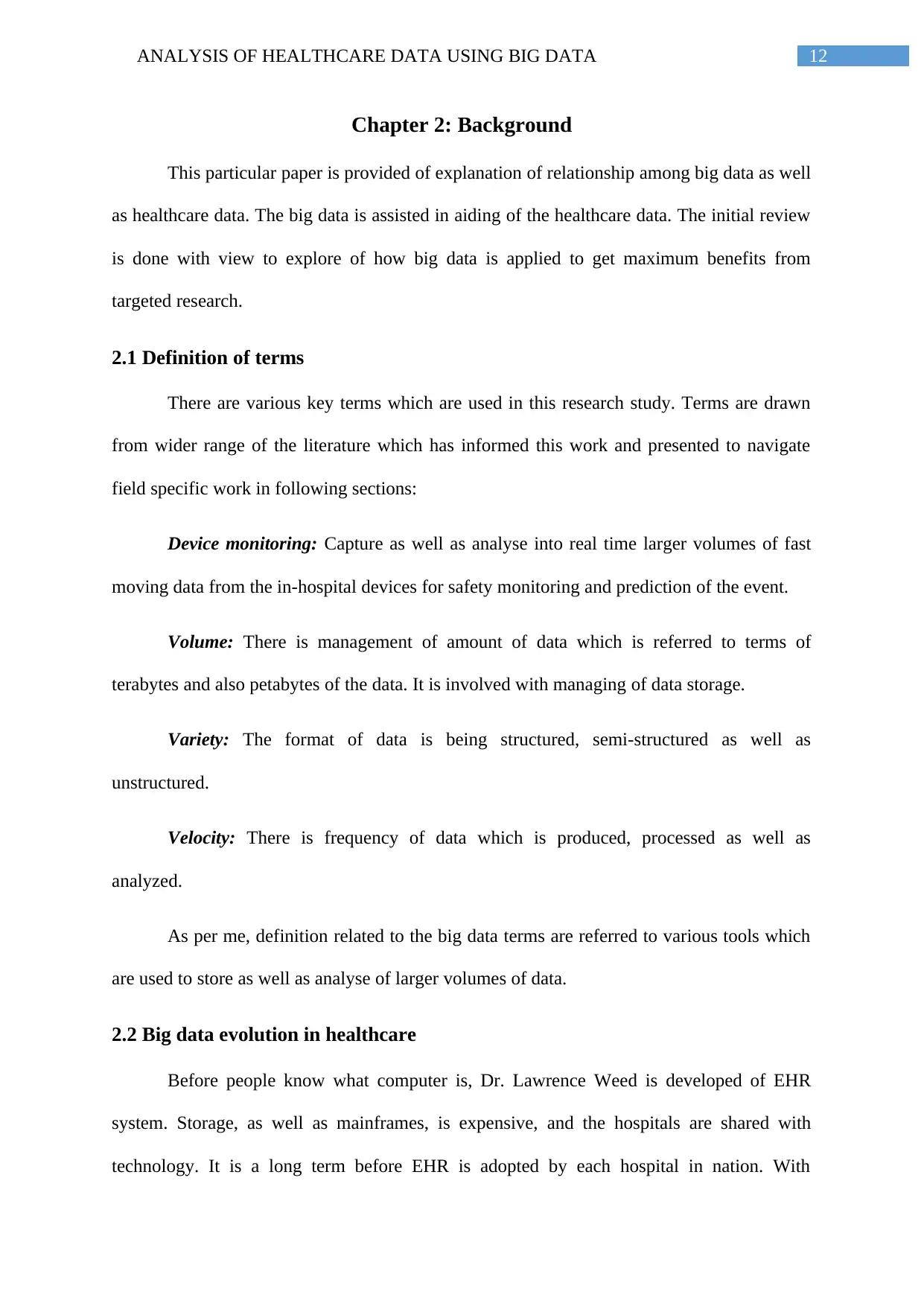
12ANALYSIS OF HEALTHCARE DATA USING BIG DATA
Chapter 2: Background
This particular paper is provided of explanation of relationship among big data as well
as healthcare data. The big data is assisted in aiding of the healthcare data. The initial review
is done with view to explore of how big data is applied to get maximum benefits from
targeted research.
2.1 Definition of terms
There are various key terms which are used in this research study. Terms are drawn
from wider range of the literature which has informed this work and presented to navigate
field specific work in following sections:
Device monitoring: Capture as well as analyse into real time larger volumes of fast
moving data from the in-hospital devices for safety monitoring and prediction of the event.
Volume: There is management of amount of data which is referred to terms of
terabytes and also petabytes of the data. It is involved with managing of data storage.
Variety: The format of data is being structured, semi-structured as well as
unstructured.
Velocity: There is frequency of data which is produced, processed as well as
analyzed.
As per me, definition related to the big data terms are referred to various tools which
are used to store as well as analyse of larger volumes of data.
2.2 Big data evolution in healthcare
Before people know what computer is, Dr. Lawrence Weed is developed of EHR
system. Storage, as well as mainframes, is expensive, and the hospitals are shared with
technology. It is a long term before EHR is adopted by each hospital in nation. With
Chapter 2: Background
This particular paper is provided of explanation of relationship among big data as well
as healthcare data. The big data is assisted in aiding of the healthcare data. The initial review
is done with view to explore of how big data is applied to get maximum benefits from
targeted research.
2.1 Definition of terms
There are various key terms which are used in this research study. Terms are drawn
from wider range of the literature which has informed this work and presented to navigate
field specific work in following sections:
Device monitoring: Capture as well as analyse into real time larger volumes of fast
moving data from the in-hospital devices for safety monitoring and prediction of the event.
Volume: There is management of amount of data which is referred to terms of
terabytes and also petabytes of the data. It is involved with managing of data storage.
Variety: The format of data is being structured, semi-structured as well as
unstructured.
Velocity: There is frequency of data which is produced, processed as well as
analyzed.
As per me, definition related to the big data terms are referred to various tools which
are used to store as well as analyse of larger volumes of data.
2.2 Big data evolution in healthcare
Before people know what computer is, Dr. Lawrence Weed is developed of EHR
system. Storage, as well as mainframes, is expensive, and the hospitals are shared with
technology. It is a long term before EHR is adopted by each hospital in nation. With
Paraphrase This Document
Need a fresh take? Get an instant paraphrase of this document with our AI Paraphraser
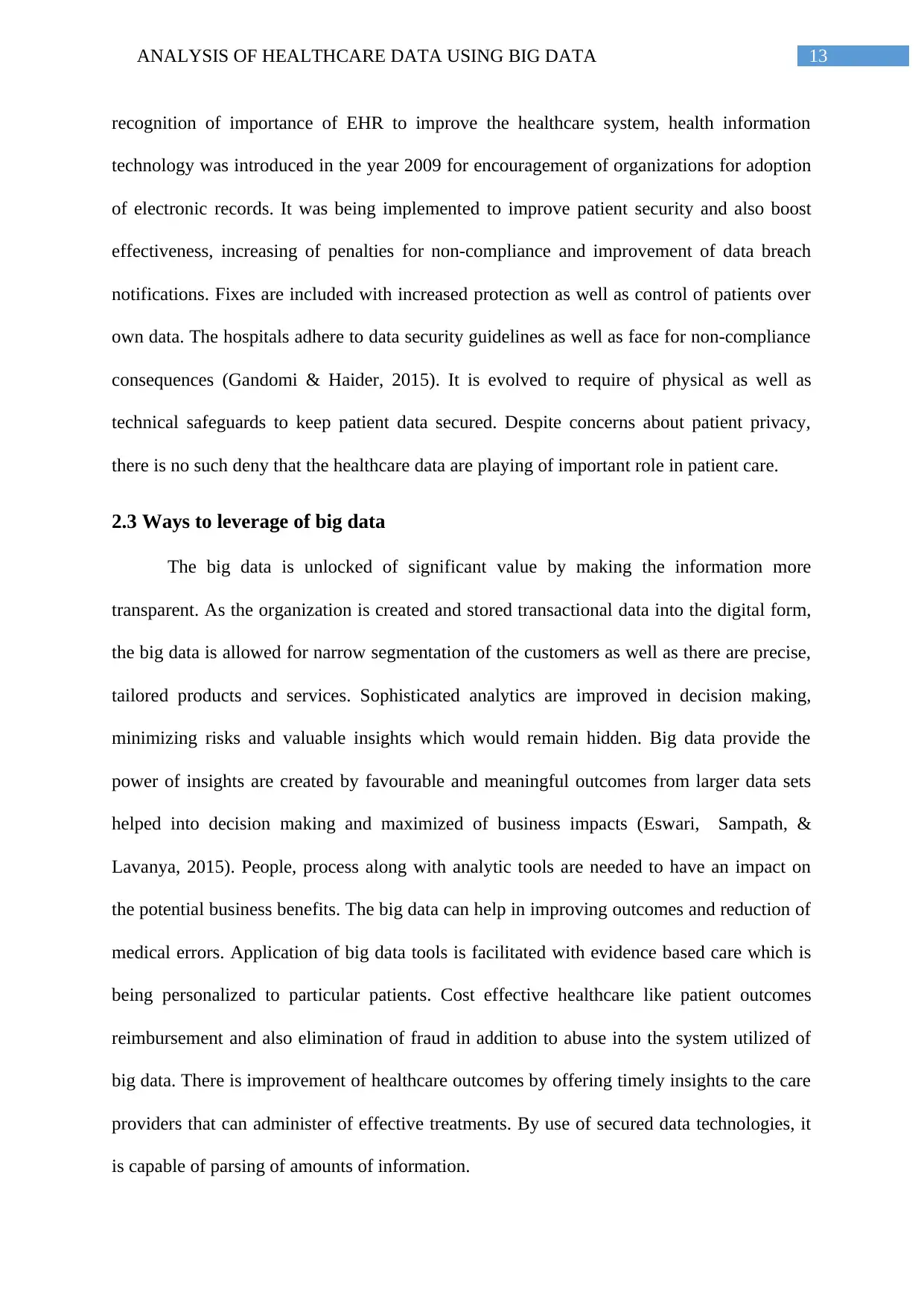
13ANALYSIS OF HEALTHCARE DATA USING BIG DATA
recognition of importance of EHR to improve the healthcare system, health information
technology was introduced in the year 2009 for encouragement of organizations for adoption
of electronic records. It was being implemented to improve patient security and also boost
effectiveness, increasing of penalties for non-compliance and improvement of data breach
notifications. Fixes are included with increased protection as well as control of patients over
own data. The hospitals adhere to data security guidelines as well as face for non-compliance
consequences (Gandomi & Haider, 2015). It is evolved to require of physical as well as
technical safeguards to keep patient data secured. Despite concerns about patient privacy,
there is no such deny that the healthcare data are playing of important role in patient care.
2.3 Ways to leverage of big data
The big data is unlocked of significant value by making the information more
transparent. As the organization is created and stored transactional data into the digital form,
the big data is allowed for narrow segmentation of the customers as well as there are precise,
tailored products and services. Sophisticated analytics are improved in decision making,
minimizing risks and valuable insights which would remain hidden. Big data provide the
power of insights are created by favourable and meaningful outcomes from larger data sets
helped into decision making and maximized of business impacts (Eswari, Sampath, &
Lavanya, 2015). People, process along with analytic tools are needed to have an impact on
the potential business benefits. The big data can help in improving outcomes and reduction of
medical errors. Application of big data tools is facilitated with evidence based care which is
being personalized to particular patients. Cost effective healthcare like patient outcomes
reimbursement and also elimination of fraud in addition to abuse into the system utilized of
big data. There is improvement of healthcare outcomes by offering timely insights to the care
providers that can administer of effective treatments. By use of secured data technologies, it
is capable of parsing of amounts of information.
recognition of importance of EHR to improve the healthcare system, health information
technology was introduced in the year 2009 for encouragement of organizations for adoption
of electronic records. It was being implemented to improve patient security and also boost
effectiveness, increasing of penalties for non-compliance and improvement of data breach
notifications. Fixes are included with increased protection as well as control of patients over
own data. The hospitals adhere to data security guidelines as well as face for non-compliance
consequences (Gandomi & Haider, 2015). It is evolved to require of physical as well as
technical safeguards to keep patient data secured. Despite concerns about patient privacy,
there is no such deny that the healthcare data are playing of important role in patient care.
2.3 Ways to leverage of big data
The big data is unlocked of significant value by making the information more
transparent. As the organization is created and stored transactional data into the digital form,
the big data is allowed for narrow segmentation of the customers as well as there are precise,
tailored products and services. Sophisticated analytics are improved in decision making,
minimizing risks and valuable insights which would remain hidden. Big data provide the
power of insights are created by favourable and meaningful outcomes from larger data sets
helped into decision making and maximized of business impacts (Eswari, Sampath, &
Lavanya, 2015). People, process along with analytic tools are needed to have an impact on
the potential business benefits. The big data can help in improving outcomes and reduction of
medical errors. Application of big data tools is facilitated with evidence based care which is
being personalized to particular patients. Cost effective healthcare like patient outcomes
reimbursement and also elimination of fraud in addition to abuse into the system utilized of
big data. There is improvement of healthcare outcomes by offering timely insights to the care
providers that can administer of effective treatments. By use of secured data technologies, it
is capable of parsing of amounts of information.
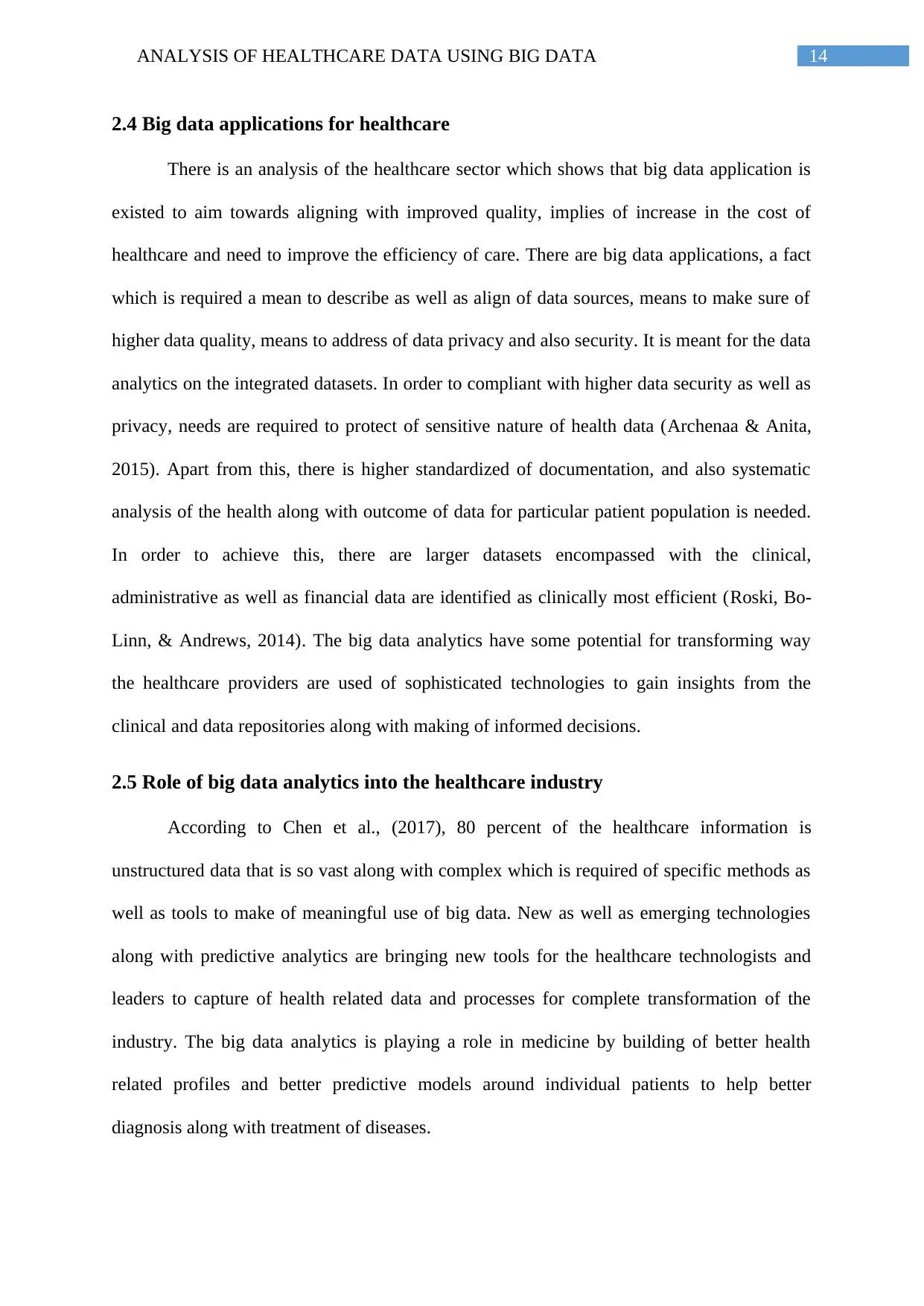
14ANALYSIS OF HEALTHCARE DATA USING BIG DATA
2.4 Big data applications for healthcare
There is an analysis of the healthcare sector which shows that big data application is
existed to aim towards aligning with improved quality, implies of increase in the cost of
healthcare and need to improve the efficiency of care. There are big data applications, a fact
which is required a mean to describe as well as align of data sources, means to make sure of
higher data quality, means to address of data privacy and also security. It is meant for the data
analytics on the integrated datasets. In order to compliant with higher data security as well as
privacy, needs are required to protect of sensitive nature of health data (Archenaa & Anita,
2015). Apart from this, there is higher standardized of documentation, and also systematic
analysis of the health along with outcome of data for particular patient population is needed.
In order to achieve this, there are larger datasets encompassed with the clinical,
administrative as well as financial data are identified as clinically most efficient (Roski, Bo-
Linn, & Andrews, 2014). The big data analytics have some potential for transforming way
the healthcare providers are used of sophisticated technologies to gain insights from the
clinical and data repositories along with making of informed decisions.
2.5 Role of big data analytics into the healthcare industry
According to Chen et al., (2017), 80 percent of the healthcare information is
unstructured data that is so vast along with complex which is required of specific methods as
well as tools to make of meaningful use of big data. New as well as emerging technologies
along with predictive analytics are bringing new tools for the healthcare technologists and
leaders to capture of health related data and processes for complete transformation of the
industry. The big data analytics is playing a role in medicine by building of better health
related profiles and better predictive models around individual patients to help better
diagnosis along with treatment of diseases.
2.4 Big data applications for healthcare
There is an analysis of the healthcare sector which shows that big data application is
existed to aim towards aligning with improved quality, implies of increase in the cost of
healthcare and need to improve the efficiency of care. There are big data applications, a fact
which is required a mean to describe as well as align of data sources, means to make sure of
higher data quality, means to address of data privacy and also security. It is meant for the data
analytics on the integrated datasets. In order to compliant with higher data security as well as
privacy, needs are required to protect of sensitive nature of health data (Archenaa & Anita,
2015). Apart from this, there is higher standardized of documentation, and also systematic
analysis of the health along with outcome of data for particular patient population is needed.
In order to achieve this, there are larger datasets encompassed with the clinical,
administrative as well as financial data are identified as clinically most efficient (Roski, Bo-
Linn, & Andrews, 2014). The big data analytics have some potential for transforming way
the healthcare providers are used of sophisticated technologies to gain insights from the
clinical and data repositories along with making of informed decisions.
2.5 Role of big data analytics into the healthcare industry
According to Chen et al., (2017), 80 percent of the healthcare information is
unstructured data that is so vast along with complex which is required of specific methods as
well as tools to make of meaningful use of big data. New as well as emerging technologies
along with predictive analytics are bringing new tools for the healthcare technologists and
leaders to capture of health related data and processes for complete transformation of the
industry. The big data analytics is playing a role in medicine by building of better health
related profiles and better predictive models around individual patients to help better
diagnosis along with treatment of diseases.
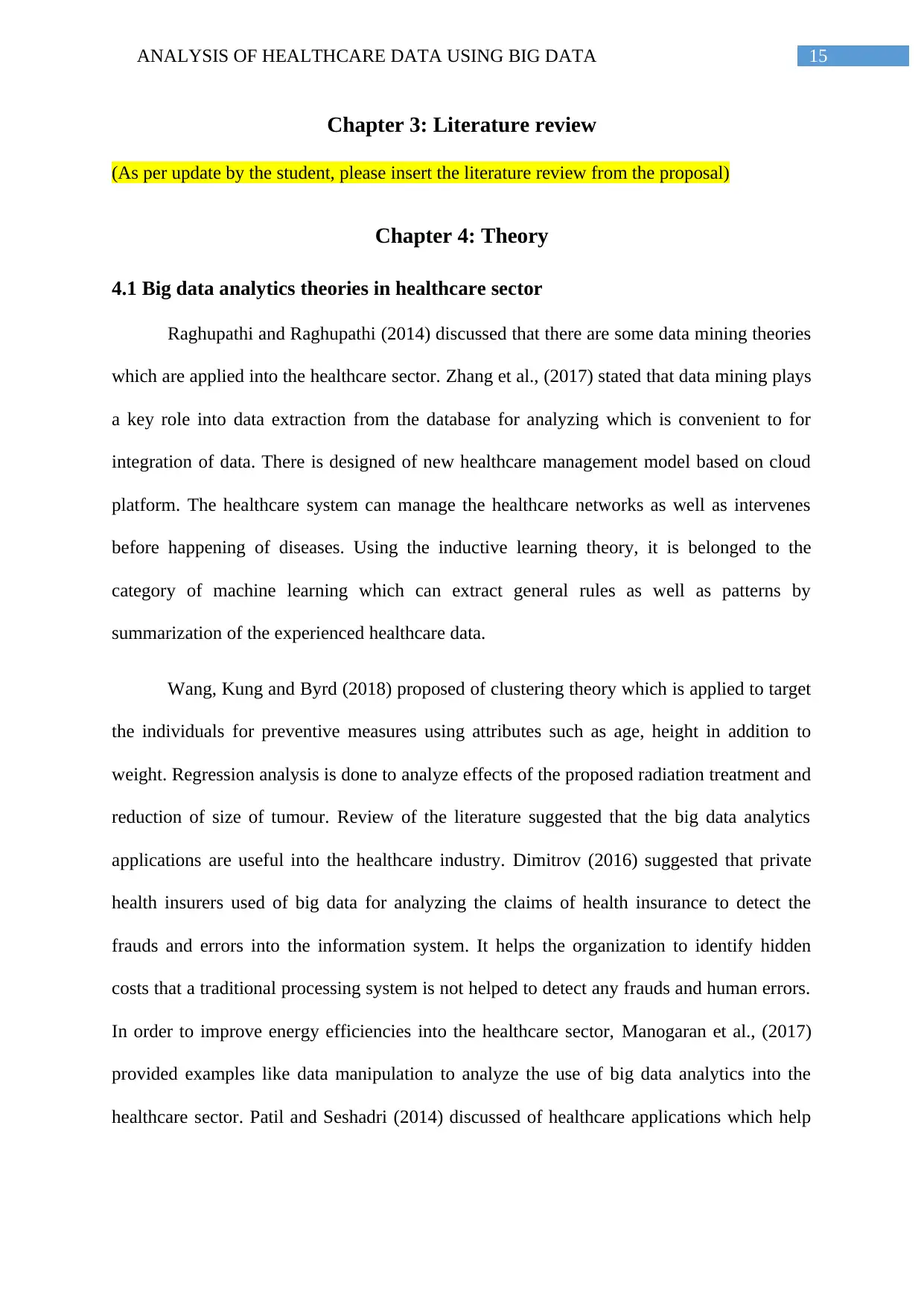
15ANALYSIS OF HEALTHCARE DATA USING BIG DATA
Chapter 3: Literature review
(As per update by the student, please insert the literature review from the proposal)
Chapter 4: Theory
4.1 Big data analytics theories in healthcare sector
Raghupathi and Raghupathi (2014) discussed that there are some data mining theories
which are applied into the healthcare sector. Zhang et al., (2017) stated that data mining plays
a key role into data extraction from the database for analyzing which is convenient to for
integration of data. There is designed of new healthcare management model based on cloud
platform. The healthcare system can manage the healthcare networks as well as intervenes
before happening of diseases. Using the inductive learning theory, it is belonged to the
category of machine learning which can extract general rules as well as patterns by
summarization of the experienced healthcare data.
Wang, Kung and Byrd (2018) proposed of clustering theory which is applied to target
the individuals for preventive measures using attributes such as age, height in addition to
weight. Regression analysis is done to analyze effects of the proposed radiation treatment and
reduction of size of tumour. Review of the literature suggested that the big data analytics
applications are useful into the healthcare industry. Dimitrov (2016) suggested that private
health insurers used of big data for analyzing the claims of health insurance to detect the
frauds and errors into the information system. It helps the organization to identify hidden
costs that a traditional processing system is not helped to detect any frauds and human errors.
In order to improve energy efficiencies into the healthcare sector, Manogaran et al., (2017)
provided examples like data manipulation to analyze the use of big data analytics into the
healthcare sector. Patil and Seshadri (2014) discussed of healthcare applications which help
Chapter 3: Literature review
(As per update by the student, please insert the literature review from the proposal)
Chapter 4: Theory
4.1 Big data analytics theories in healthcare sector
Raghupathi and Raghupathi (2014) discussed that there are some data mining theories
which are applied into the healthcare sector. Zhang et al., (2017) stated that data mining plays
a key role into data extraction from the database for analyzing which is convenient to for
integration of data. There is designed of new healthcare management model based on cloud
platform. The healthcare system can manage the healthcare networks as well as intervenes
before happening of diseases. Using the inductive learning theory, it is belonged to the
category of machine learning which can extract general rules as well as patterns by
summarization of the experienced healthcare data.
Wang, Kung and Byrd (2018) proposed of clustering theory which is applied to target
the individuals for preventive measures using attributes such as age, height in addition to
weight. Regression analysis is done to analyze effects of the proposed radiation treatment and
reduction of size of tumour. Review of the literature suggested that the big data analytics
applications are useful into the healthcare industry. Dimitrov (2016) suggested that private
health insurers used of big data for analyzing the claims of health insurance to detect the
frauds and errors into the information system. It helps the organization to identify hidden
costs that a traditional processing system is not helped to detect any frauds and human errors.
In order to improve energy efficiencies into the healthcare sector, Manogaran et al., (2017)
provided examples like data manipulation to analyze the use of big data analytics into the
healthcare sector. Patil and Seshadri (2014) discussed of healthcare applications which help
Secure Best Marks with AI Grader
Need help grading? Try our AI Grader for instant feedback on your assignments.

16ANALYSIS OF HEALTHCARE DATA USING BIG DATA
Healthcare
Data
Derivation of policy
actions for Big Data
in Health
Big Data analytics in
Healthcare
Performance of big data
application
Big data
transformation
in segmentation in addition to predictive modelling to profiles of patients help in precautions
process.
4.2 Theoretical framework of the study
The theoretical framework of this study is explaining the variables which are taken to
understand the concepts of big data and its assistance to the healthcare data. The variables are
explained into the below figure which have been explained in the literature review in order to
provide extensive idea about Big Data.
Figure 4.1: Theortical framework of the research study
(Source: Created by author)
From the above figure, it is seen that healthcare data is an independent variable, bi
data transformation is meditating variable. There are three dependent variables as per the
theoretical framework such as added value of big data in health practices, derivation of policy
actions for big data in health and big data in healthcare. As the healthcare industry is larger,
Healthcare
Data
Derivation of policy
actions for Big Data
in Health
Big Data analytics in
Healthcare
Performance of big data
application
Big data
transformation
in segmentation in addition to predictive modelling to profiles of patients help in precautions
process.
4.2 Theoretical framework of the study
The theoretical framework of this study is explaining the variables which are taken to
understand the concepts of big data and its assistance to the healthcare data. The variables are
explained into the below figure which have been explained in the literature review in order to
provide extensive idea about Big Data.
Figure 4.1: Theortical framework of the research study
(Source: Created by author)
From the above figure, it is seen that healthcare data is an independent variable, bi
data transformation is meditating variable. There are three dependent variables as per the
theoretical framework such as added value of big data in health practices, derivation of policy
actions for big data in health and big data in healthcare. As the healthcare industry is larger,

17ANALYSIS OF HEALTHCARE DATA USING BIG DATA
therefore combination of healthcare data and big data is also large; therefore it becomes
difficult for the company to manage the data. Hadoop data approach is one of the key choices
that can go along in the current trends. This data processing is encouraged to provide
mathematical processes (Wang et al., 2018). The data sources aids to process in addition to
assess end outcomes of data with various features.
The hypothesis of this particular paper is looked to explain the conjectures that are
accepted as well as rejected with help of answers discovered with help of the selected
research hypothesis. The research hypothesis is as following:
H0: Big Data is not useful for the assessment of the healthcare data
H1: Big Data is useful for the assessment of the healthcare data
4.3 Social representation theory
Bhatt, Dey and Ashour (2017) stated that there is use of social representation theory
(SRT) as the method which guides development of the theoretical framework. SRT allows the
study of the social dynamics but it is informed that the structure of theoretical framework is
based on the research requirements. This paper is mainly discussed on development of
theoretical framework for studying the influence of the big data on the business IT alignment
based on the United States healthcare sector. The process to develop such a theoretical
framework is applied into the healthcare systems in US. Such a framework is used as basis
for the empirical studies that aim to develop the theory (Riggins & Wamba, 2015). The
literature study is consisted of big data, healthcare data, highlighting identified gaps, while
SRT is being discussed. There is description of healthcare system which is provided into the
research study. The aim of this paper is to analyze the framework in literature that is explored
influence of big data into the healthcare sector.
therefore combination of healthcare data and big data is also large; therefore it becomes
difficult for the company to manage the data. Hadoop data approach is one of the key choices
that can go along in the current trends. This data processing is encouraged to provide
mathematical processes (Wang et al., 2018). The data sources aids to process in addition to
assess end outcomes of data with various features.
The hypothesis of this particular paper is looked to explain the conjectures that are
accepted as well as rejected with help of answers discovered with help of the selected
research hypothesis. The research hypothesis is as following:
H0: Big Data is not useful for the assessment of the healthcare data
H1: Big Data is useful for the assessment of the healthcare data
4.3 Social representation theory
Bhatt, Dey and Ashour (2017) stated that there is use of social representation theory
(SRT) as the method which guides development of the theoretical framework. SRT allows the
study of the social dynamics but it is informed that the structure of theoretical framework is
based on the research requirements. This paper is mainly discussed on development of
theoretical framework for studying the influence of the big data on the business IT alignment
based on the United States healthcare sector. The process to develop such a theoretical
framework is applied into the healthcare systems in US. Such a framework is used as basis
for the empirical studies that aim to develop the theory (Riggins & Wamba, 2015). The
literature study is consisted of big data, healthcare data, highlighting identified gaps, while
SRT is being discussed. There is description of healthcare system which is provided into the
research study. The aim of this paper is to analyze the framework in literature that is explored
influence of big data into the healthcare sector.
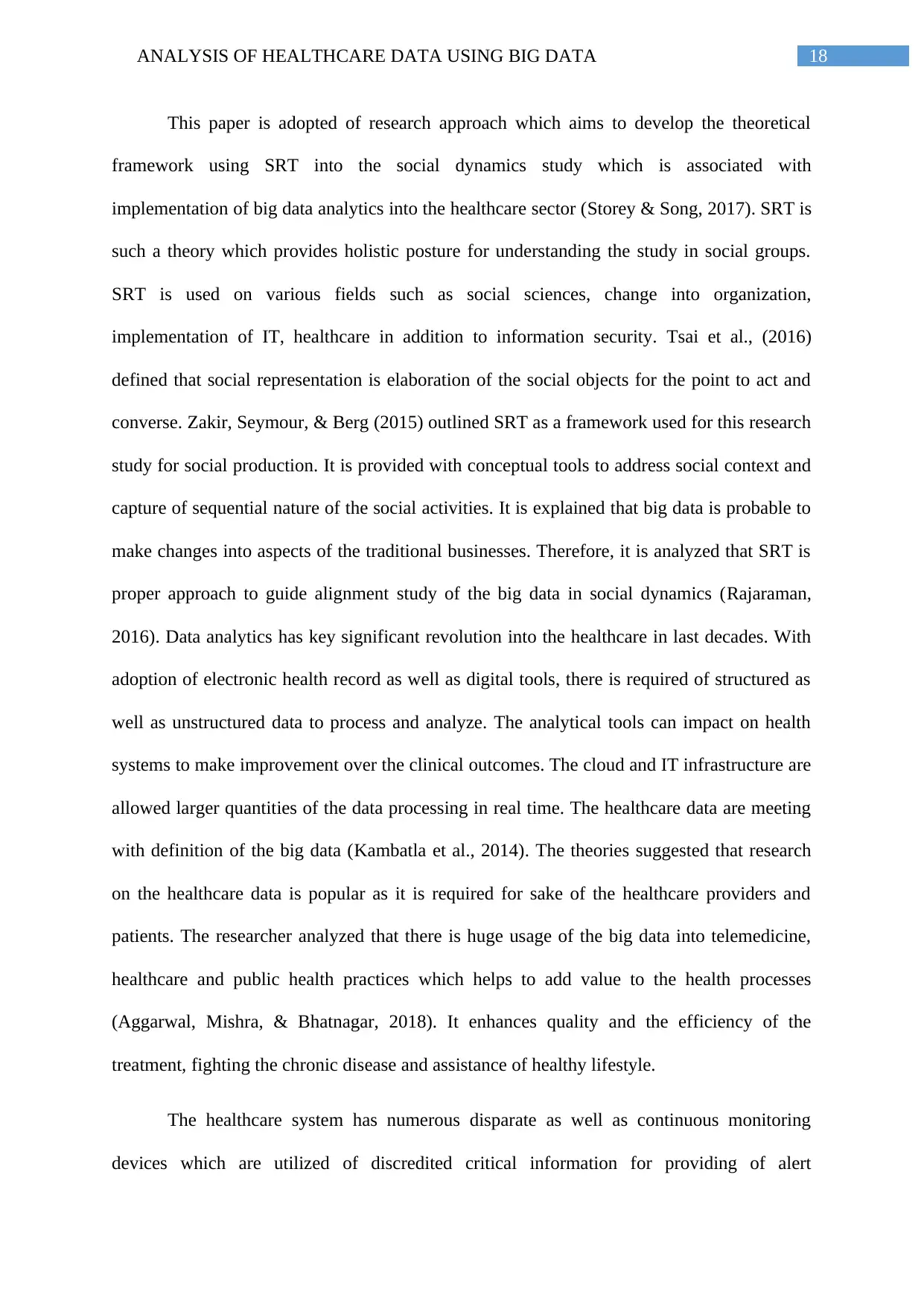
18ANALYSIS OF HEALTHCARE DATA USING BIG DATA
This paper is adopted of research approach which aims to develop the theoretical
framework using SRT into the social dynamics study which is associated with
implementation of big data analytics into the healthcare sector (Storey & Song, 2017). SRT is
such a theory which provides holistic posture for understanding the study in social groups.
SRT is used on various fields such as social sciences, change into organization,
implementation of IT, healthcare in addition to information security. Tsai et al., (2016)
defined that social representation is elaboration of the social objects for the point to act and
converse. Zakir, Seymour, & Berg (2015) outlined SRT as a framework used for this research
study for social production. It is provided with conceptual tools to address social context and
capture of sequential nature of the social activities. It is explained that big data is probable to
make changes into aspects of the traditional businesses. Therefore, it is analyzed that SRT is
proper approach to guide alignment study of the big data in social dynamics (Rajaraman,
2016). Data analytics has key significant revolution into the healthcare in last decades. With
adoption of electronic health record as well as digital tools, there is required of structured as
well as unstructured data to process and analyze. The analytical tools can impact on health
systems to make improvement over the clinical outcomes. The cloud and IT infrastructure are
allowed larger quantities of the data processing in real time. The healthcare data are meeting
with definition of the big data (Kambatla et al., 2014). The theories suggested that research
on the healthcare data is popular as it is required for sake of the healthcare providers and
patients. The researcher analyzed that there is huge usage of the big data into telemedicine,
healthcare and public health practices which helps to add value to the health processes
(Aggarwal, Mishra, & Bhatnagar, 2018). It enhances quality and the efficiency of the
treatment, fighting the chronic disease and assistance of healthy lifestyle.
The healthcare system has numerous disparate as well as continuous monitoring
devices which are utilized of discredited critical information for providing of alert
This paper is adopted of research approach which aims to develop the theoretical
framework using SRT into the social dynamics study which is associated with
implementation of big data analytics into the healthcare sector (Storey & Song, 2017). SRT is
such a theory which provides holistic posture for understanding the study in social groups.
SRT is used on various fields such as social sciences, change into organization,
implementation of IT, healthcare in addition to information security. Tsai et al., (2016)
defined that social representation is elaboration of the social objects for the point to act and
converse. Zakir, Seymour, & Berg (2015) outlined SRT as a framework used for this research
study for social production. It is provided with conceptual tools to address social context and
capture of sequential nature of the social activities. It is explained that big data is probable to
make changes into aspects of the traditional businesses. Therefore, it is analyzed that SRT is
proper approach to guide alignment study of the big data in social dynamics (Rajaraman,
2016). Data analytics has key significant revolution into the healthcare in last decades. With
adoption of electronic health record as well as digital tools, there is required of structured as
well as unstructured data to process and analyze. The analytical tools can impact on health
systems to make improvement over the clinical outcomes. The cloud and IT infrastructure are
allowed larger quantities of the data processing in real time. The healthcare data are meeting
with definition of the big data (Kambatla et al., 2014). The theories suggested that research
on the healthcare data is popular as it is required for sake of the healthcare providers and
patients. The researcher analyzed that there is huge usage of the big data into telemedicine,
healthcare and public health practices which helps to add value to the health processes
(Aggarwal, Mishra, & Bhatnagar, 2018). It enhances quality and the efficiency of the
treatment, fighting the chronic disease and assistance of healthy lifestyle.
The healthcare system has numerous disparate as well as continuous monitoring
devices which are utilized of discredited critical information for providing of alert
Paraphrase This Document
Need a fresh take? Get an instant paraphrase of this document with our AI Paraphraser
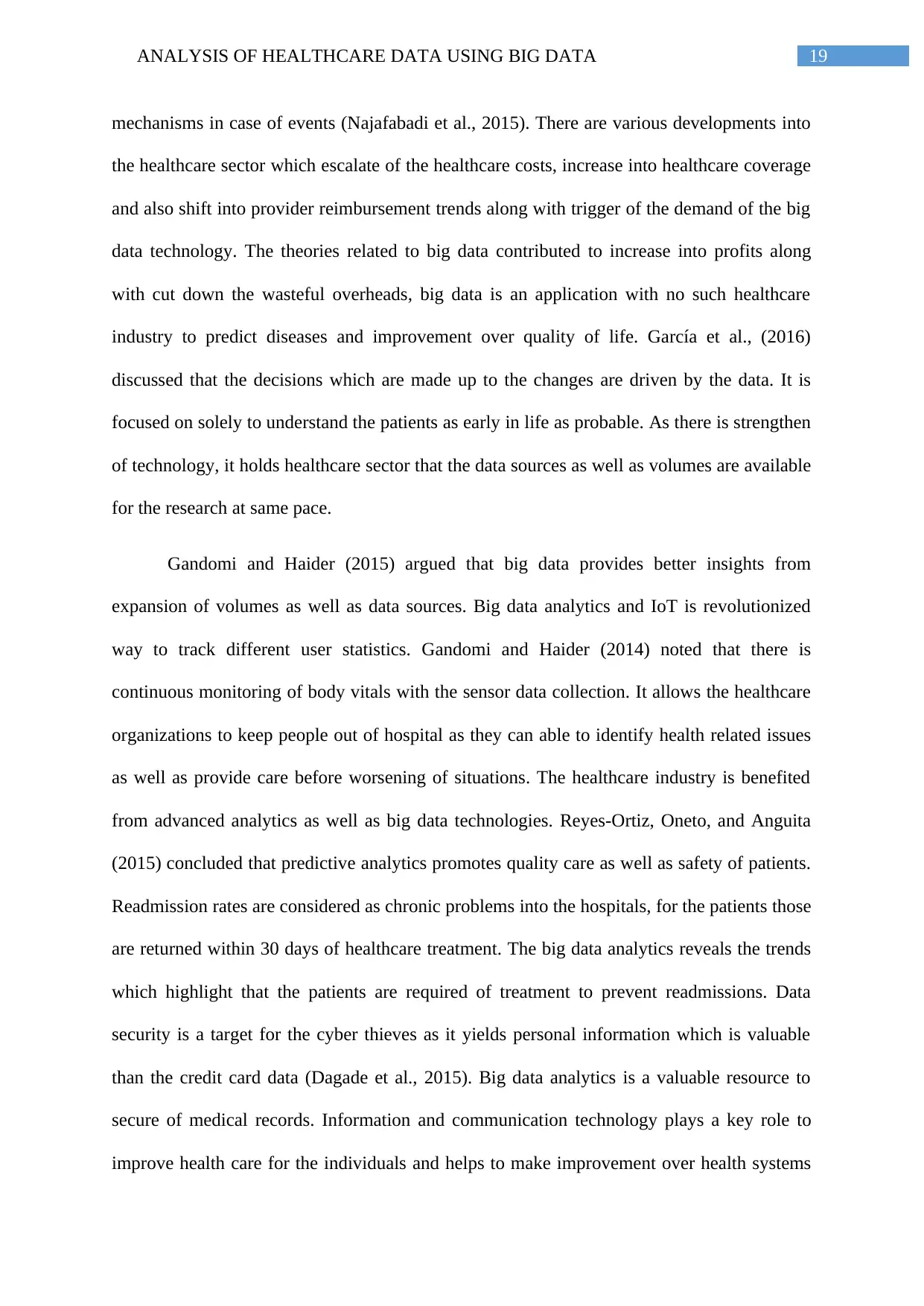
19ANALYSIS OF HEALTHCARE DATA USING BIG DATA
mechanisms in case of events (Najafabadi et al., 2015). There are various developments into
the healthcare sector which escalate of the healthcare costs, increase into healthcare coverage
and also shift into provider reimbursement trends along with trigger of the demand of the big
data technology. The theories related to big data contributed to increase into profits along
with cut down the wasteful overheads, big data is an application with no such healthcare
industry to predict diseases and improvement over quality of life. García et al., (2016)
discussed that the decisions which are made up to the changes are driven by the data. It is
focused on solely to understand the patients as early in life as probable. As there is strengthen
of technology, it holds healthcare sector that the data sources as well as volumes are available
for the research at same pace.
Gandomi and Haider (2015) argued that big data provides better insights from
expansion of volumes as well as data sources. Big data analytics and IoT is revolutionized
way to track different user statistics. Gandomi and Haider (2014) noted that there is
continuous monitoring of body vitals with the sensor data collection. It allows the healthcare
organizations to keep people out of hospital as they can able to identify health related issues
as well as provide care before worsening of situations. The healthcare industry is benefited
from advanced analytics as well as big data technologies. Reyes-Ortiz, Oneto, and Anguita
(2015) concluded that predictive analytics promotes quality care as well as safety of patients.
Readmission rates are considered as chronic problems into the hospitals, for the patients those
are returned within 30 days of healthcare treatment. The big data analytics reveals the trends
which highlight that the patients are required of treatment to prevent readmissions. Data
security is a target for the cyber thieves as it yields personal information which is valuable
than the credit card data (Dagade et al., 2015). Big data analytics is a valuable resource to
secure of medical records. Information and communication technology plays a key role to
improve health care for the individuals and helps to make improvement over health systems
mechanisms in case of events (Najafabadi et al., 2015). There are various developments into
the healthcare sector which escalate of the healthcare costs, increase into healthcare coverage
and also shift into provider reimbursement trends along with trigger of the demand of the big
data technology. The theories related to big data contributed to increase into profits along
with cut down the wasteful overheads, big data is an application with no such healthcare
industry to predict diseases and improvement over quality of life. García et al., (2016)
discussed that the decisions which are made up to the changes are driven by the data. It is
focused on solely to understand the patients as early in life as probable. As there is strengthen
of technology, it holds healthcare sector that the data sources as well as volumes are available
for the research at same pace.
Gandomi and Haider (2015) argued that big data provides better insights from
expansion of volumes as well as data sources. Big data analytics and IoT is revolutionized
way to track different user statistics. Gandomi and Haider (2014) noted that there is
continuous monitoring of body vitals with the sensor data collection. It allows the healthcare
organizations to keep people out of hospital as they can able to identify health related issues
as well as provide care before worsening of situations. The healthcare industry is benefited
from advanced analytics as well as big data technologies. Reyes-Ortiz, Oneto, and Anguita
(2015) concluded that predictive analytics promotes quality care as well as safety of patients.
Readmission rates are considered as chronic problems into the hospitals, for the patients those
are returned within 30 days of healthcare treatment. The big data analytics reveals the trends
which highlight that the patients are required of treatment to prevent readmissions. Data
security is a target for the cyber thieves as it yields personal information which is valuable
than the credit card data (Dagade et al., 2015). Big data analytics is a valuable resource to
secure of medical records. Information and communication technology plays a key role to
improve health care for the individuals and helps to make improvement over health systems
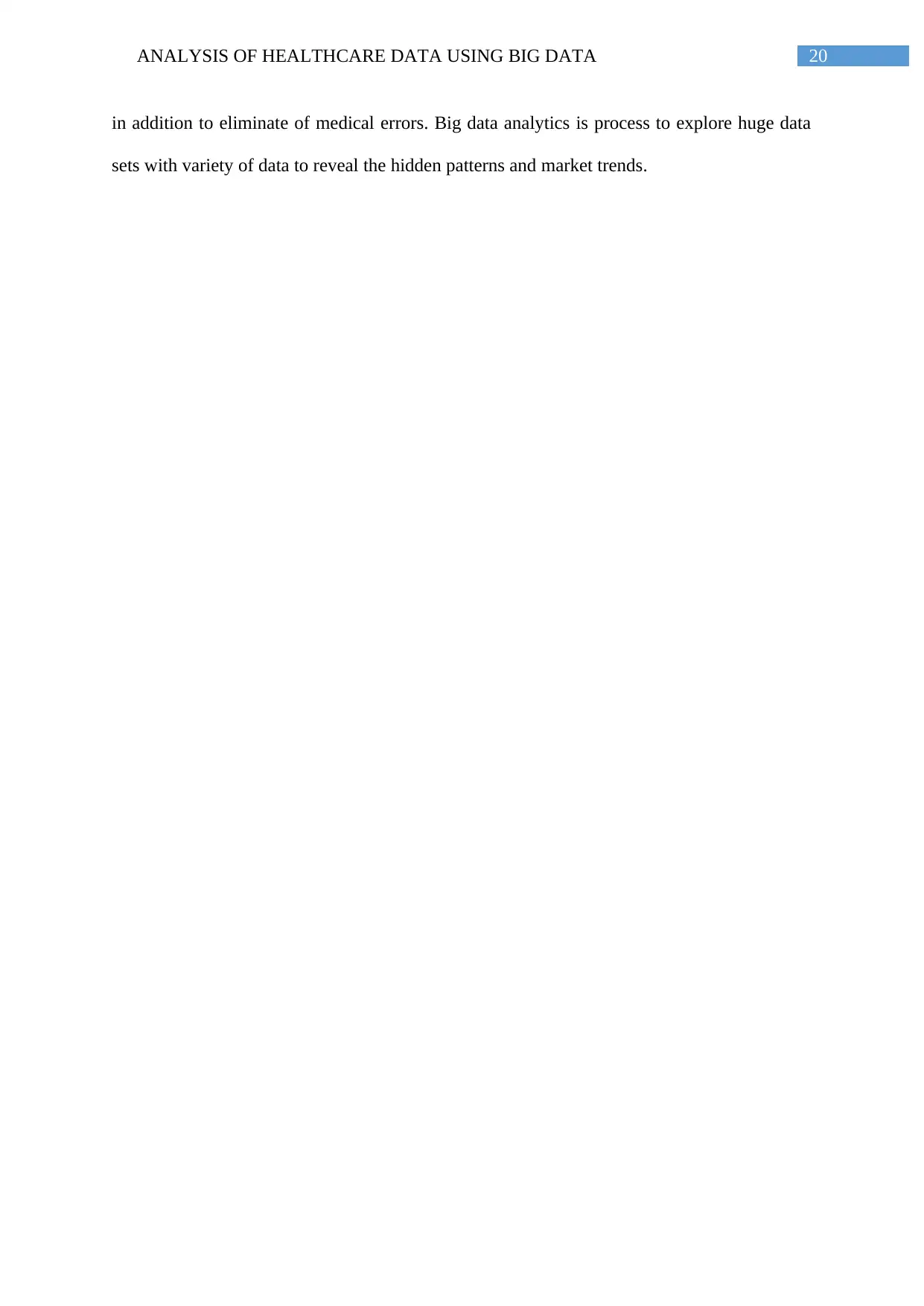
20ANALYSIS OF HEALTHCARE DATA USING BIG DATA
in addition to eliminate of medical errors. Big data analytics is process to explore huge data
sets with variety of data to reveal the hidden patterns and market trends.
in addition to eliminate of medical errors. Big data analytics is process to explore huge data
sets with variety of data to reveal the hidden patterns and market trends.
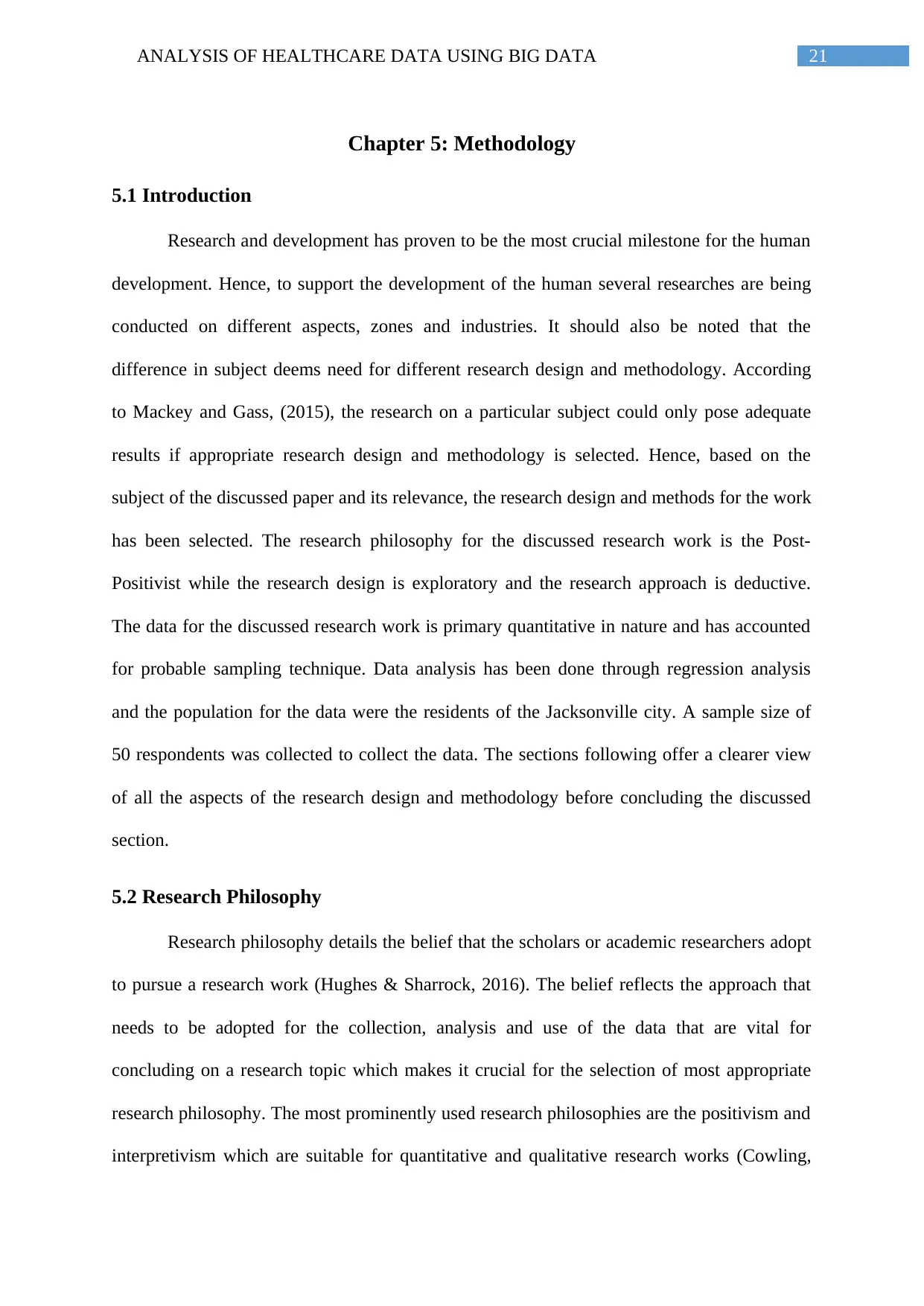
21ANALYSIS OF HEALTHCARE DATA USING BIG DATA
Chapter 5: Methodology
5.1 Introduction
Research and development has proven to be the most crucial milestone for the human
development. Hence, to support the development of the human several researches are being
conducted on different aspects, zones and industries. It should also be noted that the
difference in subject deems need for different research design and methodology. According
to Mackey and Gass, (2015), the research on a particular subject could only pose adequate
results if appropriate research design and methodology is selected. Hence, based on the
subject of the discussed paper and its relevance, the research design and methods for the work
has been selected. The research philosophy for the discussed research work is the Post-
Positivist while the research design is exploratory and the research approach is deductive.
The data for the discussed research work is primary quantitative in nature and has accounted
for probable sampling technique. Data analysis has been done through regression analysis
and the population for the data were the residents of the Jacksonville city. A sample size of
50 respondents was collected to collect the data. The sections following offer a clearer view
of all the aspects of the research design and methodology before concluding the discussed
section.
5.2 Research Philosophy
Research philosophy details the belief that the scholars or academic researchers adopt
to pursue a research work (Hughes & Sharrock, 2016). The belief reflects the approach that
needs to be adopted for the collection, analysis and use of the data that are vital for
concluding on a research topic which makes it crucial for the selection of most appropriate
research philosophy. The most prominently used research philosophies are the positivism and
interpretivism which are suitable for quantitative and qualitative research works (Cowling,
Chapter 5: Methodology
5.1 Introduction
Research and development has proven to be the most crucial milestone for the human
development. Hence, to support the development of the human several researches are being
conducted on different aspects, zones and industries. It should also be noted that the
difference in subject deems need for different research design and methodology. According
to Mackey and Gass, (2015), the research on a particular subject could only pose adequate
results if appropriate research design and methodology is selected. Hence, based on the
subject of the discussed paper and its relevance, the research design and methods for the work
has been selected. The research philosophy for the discussed research work is the Post-
Positivist while the research design is exploratory and the research approach is deductive.
The data for the discussed research work is primary quantitative in nature and has accounted
for probable sampling technique. Data analysis has been done through regression analysis
and the population for the data were the residents of the Jacksonville city. A sample size of
50 respondents was collected to collect the data. The sections following offer a clearer view
of all the aspects of the research design and methodology before concluding the discussed
section.
5.2 Research Philosophy
Research philosophy details the belief that the scholars or academic researchers adopt
to pursue a research work (Hughes & Sharrock, 2016). The belief reflects the approach that
needs to be adopted for the collection, analysis and use of the data that are vital for
concluding on a research topic which makes it crucial for the selection of most appropriate
research philosophy. The most prominently used research philosophies are the positivism and
interpretivism which are suitable for quantitative and qualitative research works (Cowling,
Secure Best Marks with AI Grader
Need help grading? Try our AI Grader for instant feedback on your assignments.
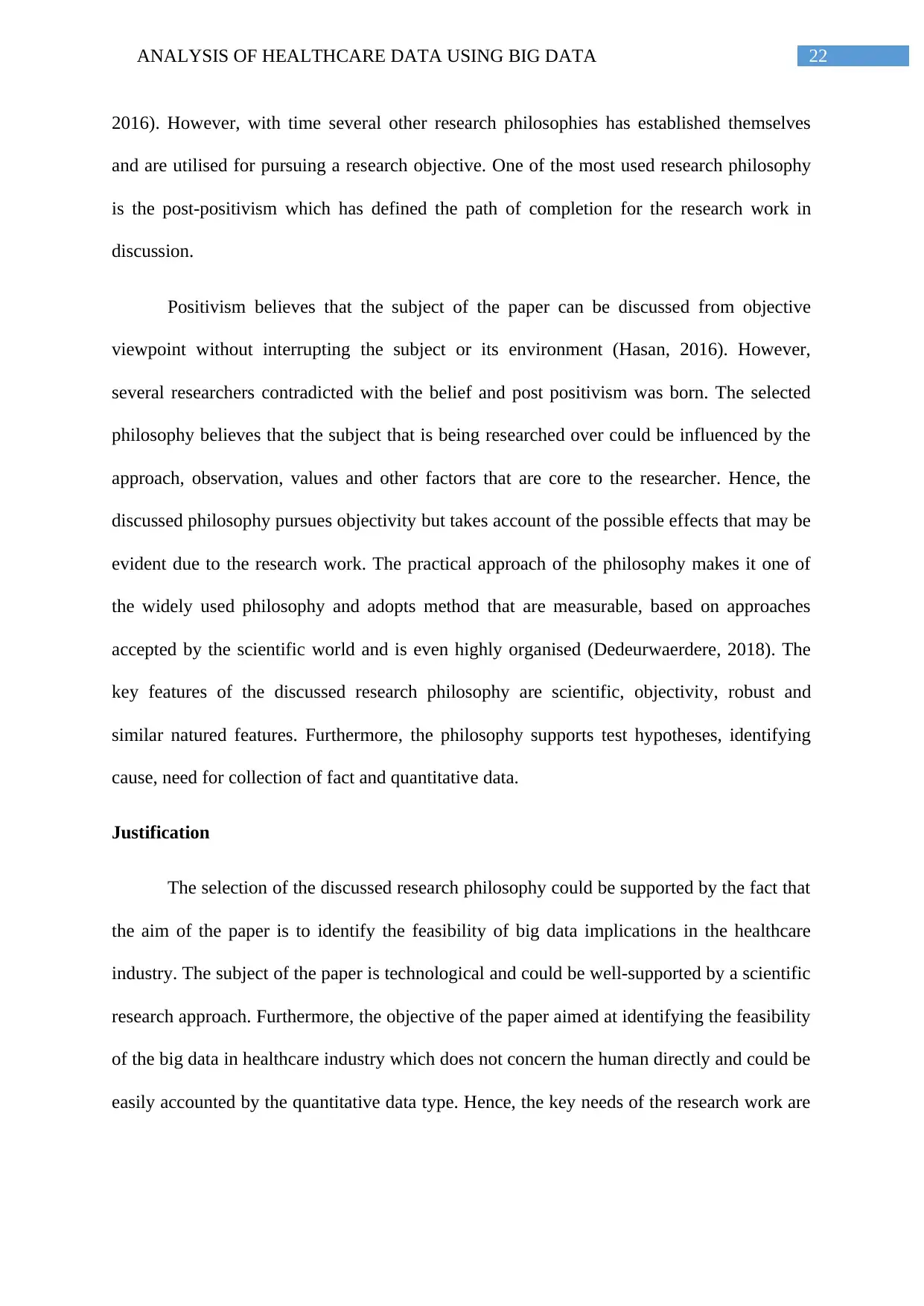
22ANALYSIS OF HEALTHCARE DATA USING BIG DATA
2016). However, with time several other research philosophies has established themselves
and are utilised for pursuing a research objective. One of the most used research philosophy
is the post-positivism which has defined the path of completion for the research work in
discussion.
Positivism believes that the subject of the paper can be discussed from objective
viewpoint without interrupting the subject or its environment (Hasan, 2016). However,
several researchers contradicted with the belief and post positivism was born. The selected
philosophy believes that the subject that is being researched over could be influenced by the
approach, observation, values and other factors that are core to the researcher. Hence, the
discussed philosophy pursues objectivity but takes account of the possible effects that may be
evident due to the research work. The practical approach of the philosophy makes it one of
the widely used philosophy and adopts method that are measurable, based on approaches
accepted by the scientific world and is even highly organised (Dedeurwaerdere, 2018). The
key features of the discussed research philosophy are scientific, objectivity, robust and
similar natured features. Furthermore, the philosophy supports test hypotheses, identifying
cause, need for collection of fact and quantitative data.
Justification
The selection of the discussed research philosophy could be supported by the fact that
the aim of the paper is to identify the feasibility of big data implications in the healthcare
industry. The subject of the paper is technological and could be well-supported by a scientific
research approach. Furthermore, the objective of the paper aimed at identifying the feasibility
of the big data in healthcare industry which does not concern the human directly and could be
easily accounted by the quantitative data type. Hence, the key needs of the research work are
2016). However, with time several other research philosophies has established themselves
and are utilised for pursuing a research objective. One of the most used research philosophy
is the post-positivism which has defined the path of completion for the research work in
discussion.
Positivism believes that the subject of the paper can be discussed from objective
viewpoint without interrupting the subject or its environment (Hasan, 2016). However,
several researchers contradicted with the belief and post positivism was born. The selected
philosophy believes that the subject that is being researched over could be influenced by the
approach, observation, values and other factors that are core to the researcher. Hence, the
discussed philosophy pursues objectivity but takes account of the possible effects that may be
evident due to the research work. The practical approach of the philosophy makes it one of
the widely used philosophy and adopts method that are measurable, based on approaches
accepted by the scientific world and is even highly organised (Dedeurwaerdere, 2018). The
key features of the discussed research philosophy are scientific, objectivity, robust and
similar natured features. Furthermore, the philosophy supports test hypotheses, identifying
cause, need for collection of fact and quantitative data.
Justification
The selection of the discussed research philosophy could be supported by the fact that
the aim of the paper is to identify the feasibility of big data implications in the healthcare
industry. The subject of the paper is technological and could be well-supported by a scientific
research approach. Furthermore, the objective of the paper aimed at identifying the feasibility
of the big data in healthcare industry which does not concern the human directly and could be
easily accounted by the quantitative data type. Hence, the key needs of the research work are
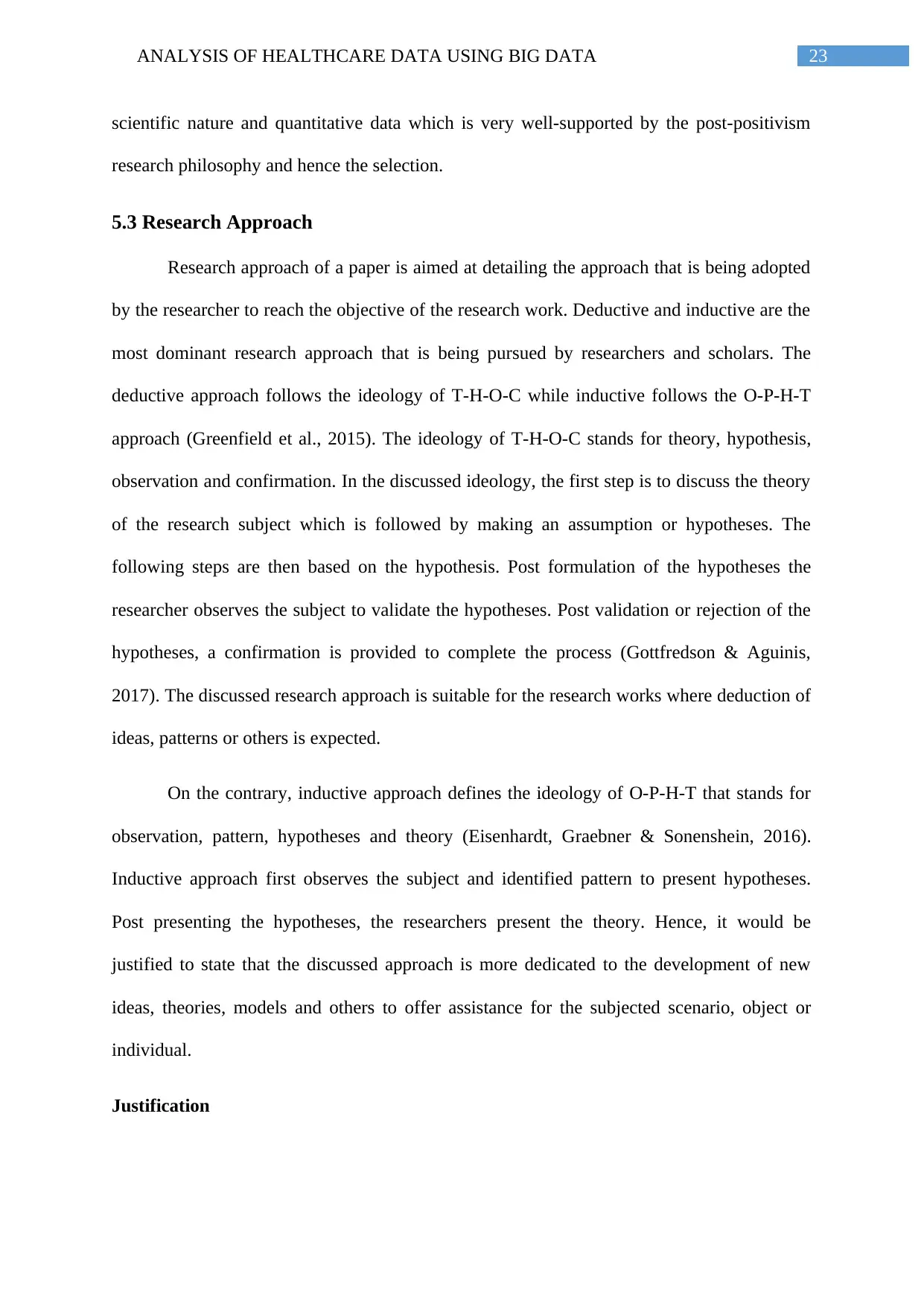
23ANALYSIS OF HEALTHCARE DATA USING BIG DATA
scientific nature and quantitative data which is very well-supported by the post-positivism
research philosophy and hence the selection.
5.3 Research Approach
Research approach of a paper is aimed at detailing the approach that is being adopted
by the researcher to reach the objective of the research work. Deductive and inductive are the
most dominant research approach that is being pursued by researchers and scholars. The
deductive approach follows the ideology of T-H-O-C while inductive follows the O-P-H-T
approach (Greenfield et al., 2015). The ideology of T-H-O-C stands for theory, hypothesis,
observation and confirmation. In the discussed ideology, the first step is to discuss the theory
of the research subject which is followed by making an assumption or hypotheses. The
following steps are then based on the hypothesis. Post formulation of the hypotheses the
researcher observes the subject to validate the hypotheses. Post validation or rejection of the
hypotheses, a confirmation is provided to complete the process (Gottfredson & Aguinis,
2017). The discussed research approach is suitable for the research works where deduction of
ideas, patterns or others is expected.
On the contrary, inductive approach defines the ideology of O-P-H-T that stands for
observation, pattern, hypotheses and theory (Eisenhardt, Graebner & Sonenshein, 2016).
Inductive approach first observes the subject and identified pattern to present hypotheses.
Post presenting the hypotheses, the researchers present the theory. Hence, it would be
justified to state that the discussed approach is more dedicated to the development of new
ideas, theories, models and others to offer assistance for the subjected scenario, object or
individual.
Justification
scientific nature and quantitative data which is very well-supported by the post-positivism
research philosophy and hence the selection.
5.3 Research Approach
Research approach of a paper is aimed at detailing the approach that is being adopted
by the researcher to reach the objective of the research work. Deductive and inductive are the
most dominant research approach that is being pursued by researchers and scholars. The
deductive approach follows the ideology of T-H-O-C while inductive follows the O-P-H-T
approach (Greenfield et al., 2015). The ideology of T-H-O-C stands for theory, hypothesis,
observation and confirmation. In the discussed ideology, the first step is to discuss the theory
of the research subject which is followed by making an assumption or hypotheses. The
following steps are then based on the hypothesis. Post formulation of the hypotheses the
researcher observes the subject to validate the hypotheses. Post validation or rejection of the
hypotheses, a confirmation is provided to complete the process (Gottfredson & Aguinis,
2017). The discussed research approach is suitable for the research works where deduction of
ideas, patterns or others is expected.
On the contrary, inductive approach defines the ideology of O-P-H-T that stands for
observation, pattern, hypotheses and theory (Eisenhardt, Graebner & Sonenshein, 2016).
Inductive approach first observes the subject and identified pattern to present hypotheses.
Post presenting the hypotheses, the researchers present the theory. Hence, it would be
justified to state that the discussed approach is more dedicated to the development of new
ideas, theories, models and others to offer assistance for the subjected scenario, object or
individual.
Justification
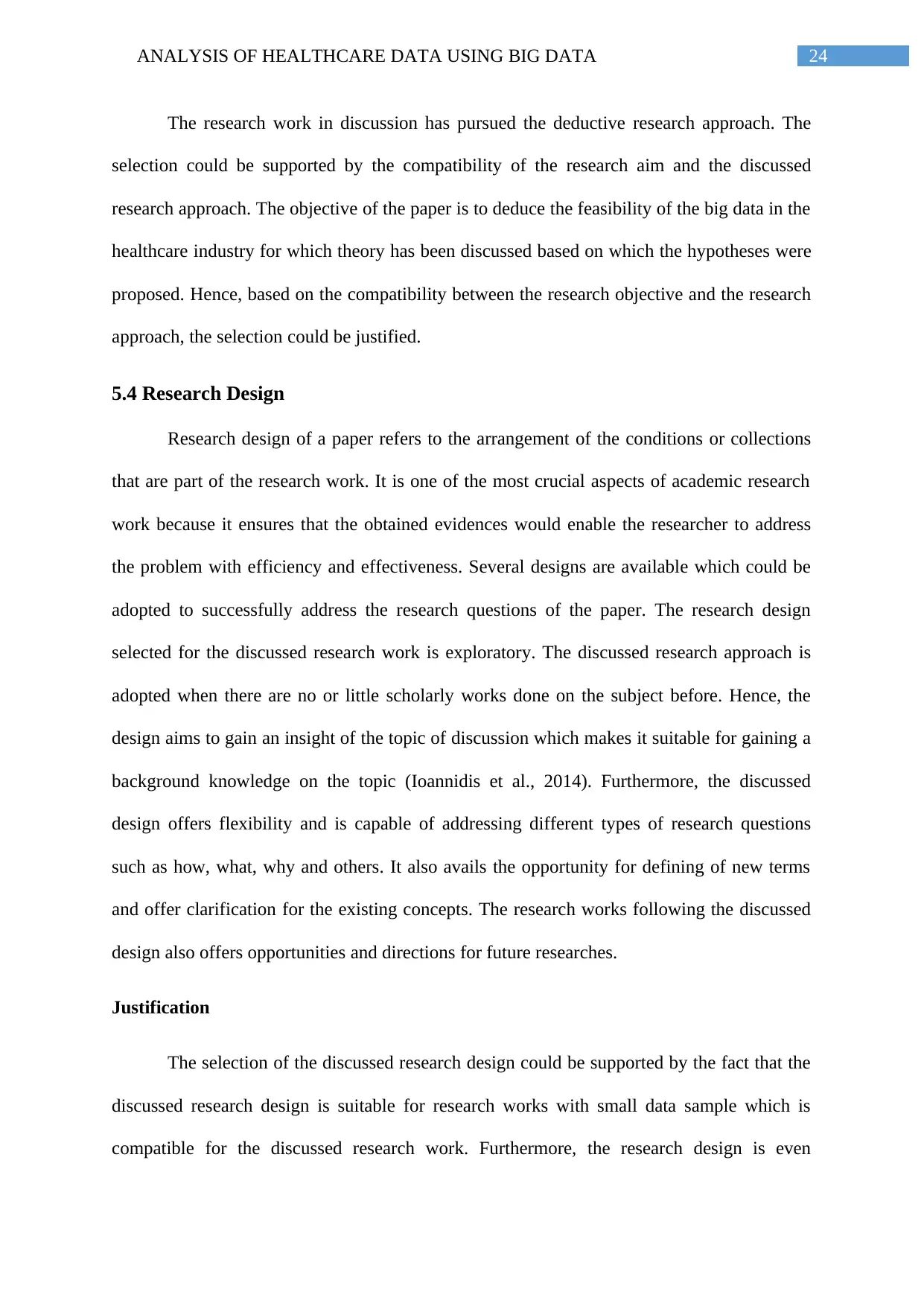
24ANALYSIS OF HEALTHCARE DATA USING BIG DATA
The research work in discussion has pursued the deductive research approach. The
selection could be supported by the compatibility of the research aim and the discussed
research approach. The objective of the paper is to deduce the feasibility of the big data in the
healthcare industry for which theory has been discussed based on which the hypotheses were
proposed. Hence, based on the compatibility between the research objective and the research
approach, the selection could be justified.
5.4 Research Design
Research design of a paper refers to the arrangement of the conditions or collections
that are part of the research work. It is one of the most crucial aspects of academic research
work because it ensures that the obtained evidences would enable the researcher to address
the problem with efficiency and effectiveness. Several designs are available which could be
adopted to successfully address the research questions of the paper. The research design
selected for the discussed research work is exploratory. The discussed research approach is
adopted when there are no or little scholarly works done on the subject before. Hence, the
design aims to gain an insight of the topic of discussion which makes it suitable for gaining a
background knowledge on the topic (Ioannidis et al., 2014). Furthermore, the discussed
design offers flexibility and is capable of addressing different types of research questions
such as how, what, why and others. It also avails the opportunity for defining of new terms
and offer clarification for the existing concepts. The research works following the discussed
design also offers opportunities and directions for future researches.
Justification
The selection of the discussed research design could be supported by the fact that the
discussed research design is suitable for research works with small data sample which is
compatible for the discussed research work. Furthermore, the research design is even
The research work in discussion has pursued the deductive research approach. The
selection could be supported by the compatibility of the research aim and the discussed
research approach. The objective of the paper is to deduce the feasibility of the big data in the
healthcare industry for which theory has been discussed based on which the hypotheses were
proposed. Hence, based on the compatibility between the research objective and the research
approach, the selection could be justified.
5.4 Research Design
Research design of a paper refers to the arrangement of the conditions or collections
that are part of the research work. It is one of the most crucial aspects of academic research
work because it ensures that the obtained evidences would enable the researcher to address
the problem with efficiency and effectiveness. Several designs are available which could be
adopted to successfully address the research questions of the paper. The research design
selected for the discussed research work is exploratory. The discussed research approach is
adopted when there are no or little scholarly works done on the subject before. Hence, the
design aims to gain an insight of the topic of discussion which makes it suitable for gaining a
background knowledge on the topic (Ioannidis et al., 2014). Furthermore, the discussed
design offers flexibility and is capable of addressing different types of research questions
such as how, what, why and others. It also avails the opportunity for defining of new terms
and offer clarification for the existing concepts. The research works following the discussed
design also offers opportunities and directions for future researches.
Justification
The selection of the discussed research design could be supported by the fact that the
discussed research design is suitable for research works with small data sample which is
compatible for the discussed research work. Furthermore, the research design is even
Paraphrase This Document
Need a fresh take? Get an instant paraphrase of this document with our AI Paraphraser
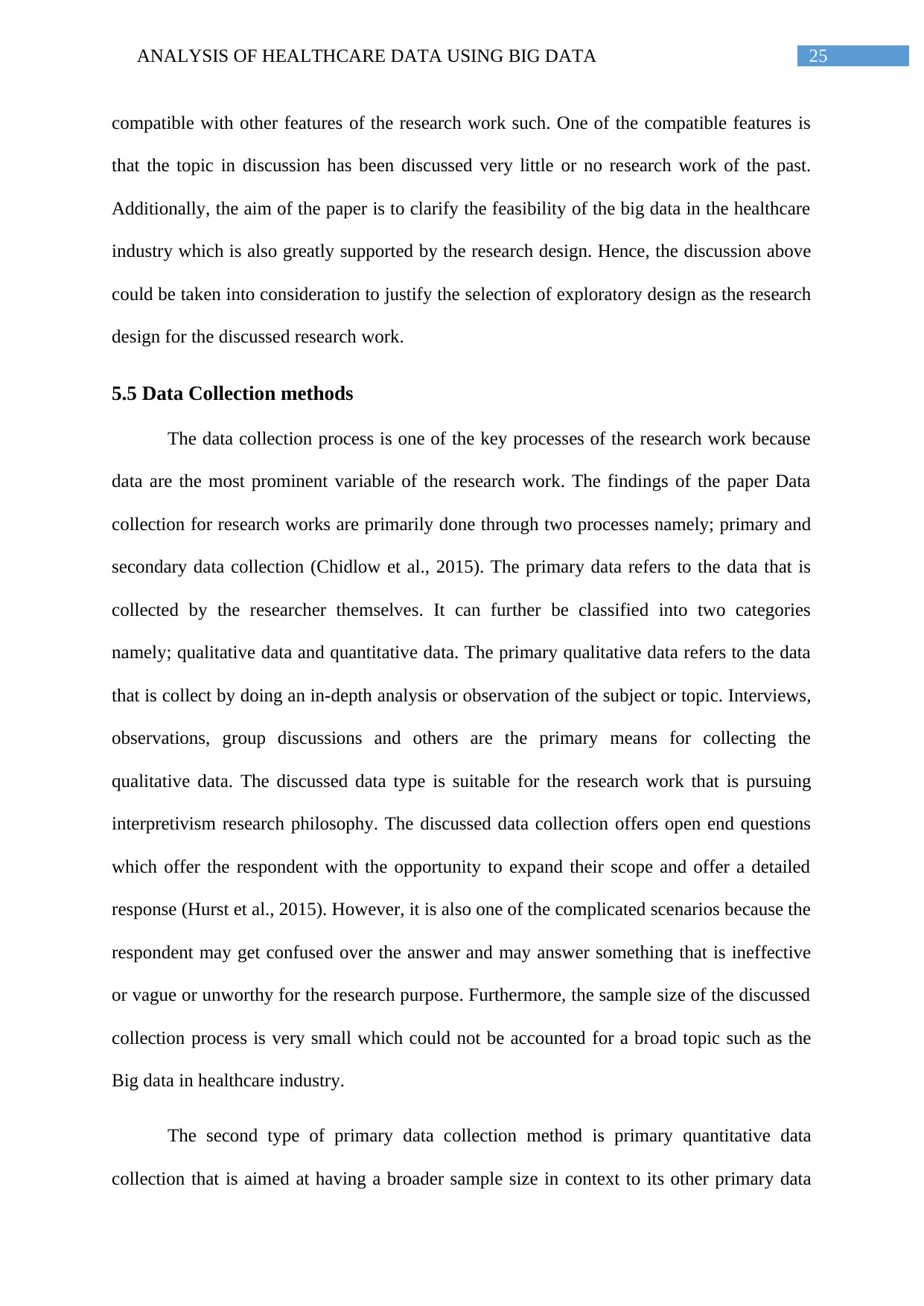
25ANALYSIS OF HEALTHCARE DATA USING BIG DATA
compatible with other features of the research work such. One of the compatible features is
that the topic in discussion has been discussed very little or no research work of the past.
Additionally, the aim of the paper is to clarify the feasibility of the big data in the healthcare
industry which is also greatly supported by the research design. Hence, the discussion above
could be taken into consideration to justify the selection of exploratory design as the research
design for the discussed research work.
5.5 Data Collection methods
The data collection process is one of the key processes of the research work because
data are the most prominent variable of the research work. The findings of the paper Data
collection for research works are primarily done through two processes namely; primary and
secondary data collection (Chidlow et al., 2015). The primary data refers to the data that is
collected by the researcher themselves. It can further be classified into two categories
namely; qualitative data and quantitative data. The primary qualitative data refers to the data
that is collect by doing an in-depth analysis or observation of the subject or topic. Interviews,
observations, group discussions and others are the primary means for collecting the
qualitative data. The discussed data type is suitable for the research work that is pursuing
interpretivism research philosophy. The discussed data collection offers open end questions
which offer the respondent with the opportunity to expand their scope and offer a detailed
response (Hurst et al., 2015). However, it is also one of the complicated scenarios because the
respondent may get confused over the answer and may answer something that is ineffective
or vague or unworthy for the research purpose. Furthermore, the sample size of the discussed
collection process is very small which could not be accounted for a broad topic such as the
Big data in healthcare industry.
The second type of primary data collection method is primary quantitative data
collection that is aimed at having a broader sample size in context to its other primary data
compatible with other features of the research work such. One of the compatible features is
that the topic in discussion has been discussed very little or no research work of the past.
Additionally, the aim of the paper is to clarify the feasibility of the big data in the healthcare
industry which is also greatly supported by the research design. Hence, the discussion above
could be taken into consideration to justify the selection of exploratory design as the research
design for the discussed research work.
5.5 Data Collection methods
The data collection process is one of the key processes of the research work because
data are the most prominent variable of the research work. The findings of the paper Data
collection for research works are primarily done through two processes namely; primary and
secondary data collection (Chidlow et al., 2015). The primary data refers to the data that is
collected by the researcher themselves. It can further be classified into two categories
namely; qualitative data and quantitative data. The primary qualitative data refers to the data
that is collect by doing an in-depth analysis or observation of the subject or topic. Interviews,
observations, group discussions and others are the primary means for collecting the
qualitative data. The discussed data type is suitable for the research work that is pursuing
interpretivism research philosophy. The discussed data collection offers open end questions
which offer the respondent with the opportunity to expand their scope and offer a detailed
response (Hurst et al., 2015). However, it is also one of the complicated scenarios because the
respondent may get confused over the answer and may answer something that is ineffective
or vague or unworthy for the research purpose. Furthermore, the sample size of the discussed
collection process is very small which could not be accounted for a broad topic such as the
Big data in healthcare industry.
The second type of primary data collection method is primary quantitative data
collection that is aimed at having a broader sample size in context to its other primary data
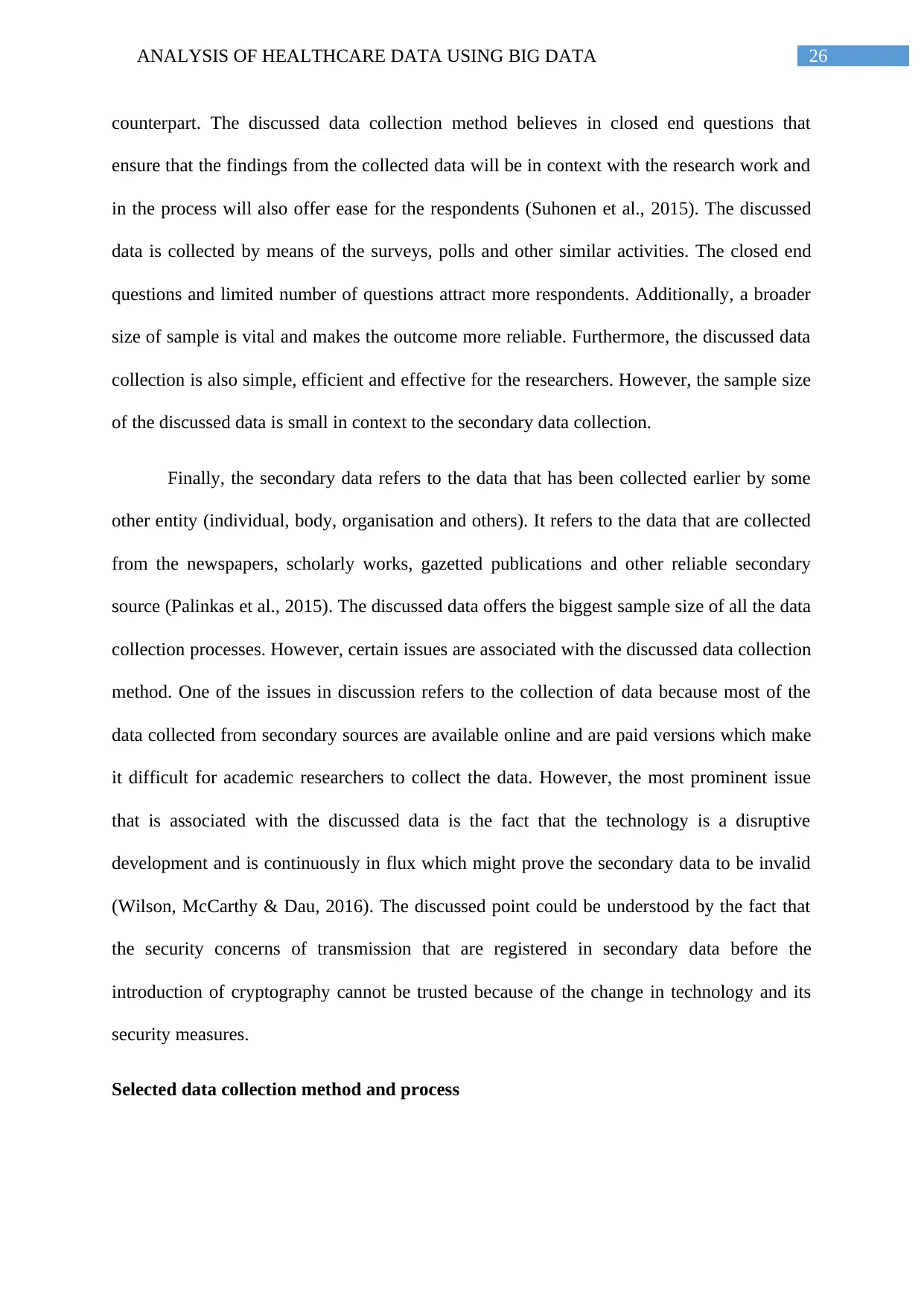
26ANALYSIS OF HEALTHCARE DATA USING BIG DATA
counterpart. The discussed data collection method believes in closed end questions that
ensure that the findings from the collected data will be in context with the research work and
in the process will also offer ease for the respondents (Suhonen et al., 2015). The discussed
data is collected by means of the surveys, polls and other similar activities. The closed end
questions and limited number of questions attract more respondents. Additionally, a broader
size of sample is vital and makes the outcome more reliable. Furthermore, the discussed data
collection is also simple, efficient and effective for the researchers. However, the sample size
of the discussed data is small in context to the secondary data collection.
Finally, the secondary data refers to the data that has been collected earlier by some
other entity (individual, body, organisation and others). It refers to the data that are collected
from the newspapers, scholarly works, gazetted publications and other reliable secondary
source (Palinkas et al., 2015). The discussed data offers the biggest sample size of all the data
collection processes. However, certain issues are associated with the discussed data collection
method. One of the issues in discussion refers to the collection of data because most of the
data collected from secondary sources are available online and are paid versions which make
it difficult for academic researchers to collect the data. However, the most prominent issue
that is associated with the discussed data is the fact that the technology is a disruptive
development and is continuously in flux which might prove the secondary data to be invalid
(Wilson, McCarthy & Dau, 2016). The discussed point could be understood by the fact that
the security concerns of transmission that are registered in secondary data before the
introduction of cryptography cannot be trusted because of the change in technology and its
security measures.
Selected data collection method and process
counterpart. The discussed data collection method believes in closed end questions that
ensure that the findings from the collected data will be in context with the research work and
in the process will also offer ease for the respondents (Suhonen et al., 2015). The discussed
data is collected by means of the surveys, polls and other similar activities. The closed end
questions and limited number of questions attract more respondents. Additionally, a broader
size of sample is vital and makes the outcome more reliable. Furthermore, the discussed data
collection is also simple, efficient and effective for the researchers. However, the sample size
of the discussed data is small in context to the secondary data collection.
Finally, the secondary data refers to the data that has been collected earlier by some
other entity (individual, body, organisation and others). It refers to the data that are collected
from the newspapers, scholarly works, gazetted publications and other reliable secondary
source (Palinkas et al., 2015). The discussed data offers the biggest sample size of all the data
collection processes. However, certain issues are associated with the discussed data collection
method. One of the issues in discussion refers to the collection of data because most of the
data collected from secondary sources are available online and are paid versions which make
it difficult for academic researchers to collect the data. However, the most prominent issue
that is associated with the discussed data is the fact that the technology is a disruptive
development and is continuously in flux which might prove the secondary data to be invalid
(Wilson, McCarthy & Dau, 2016). The discussed point could be understood by the fact that
the security concerns of transmission that are registered in secondary data before the
introduction of cryptography cannot be trusted because of the change in technology and its
security measures.
Selected data collection method and process
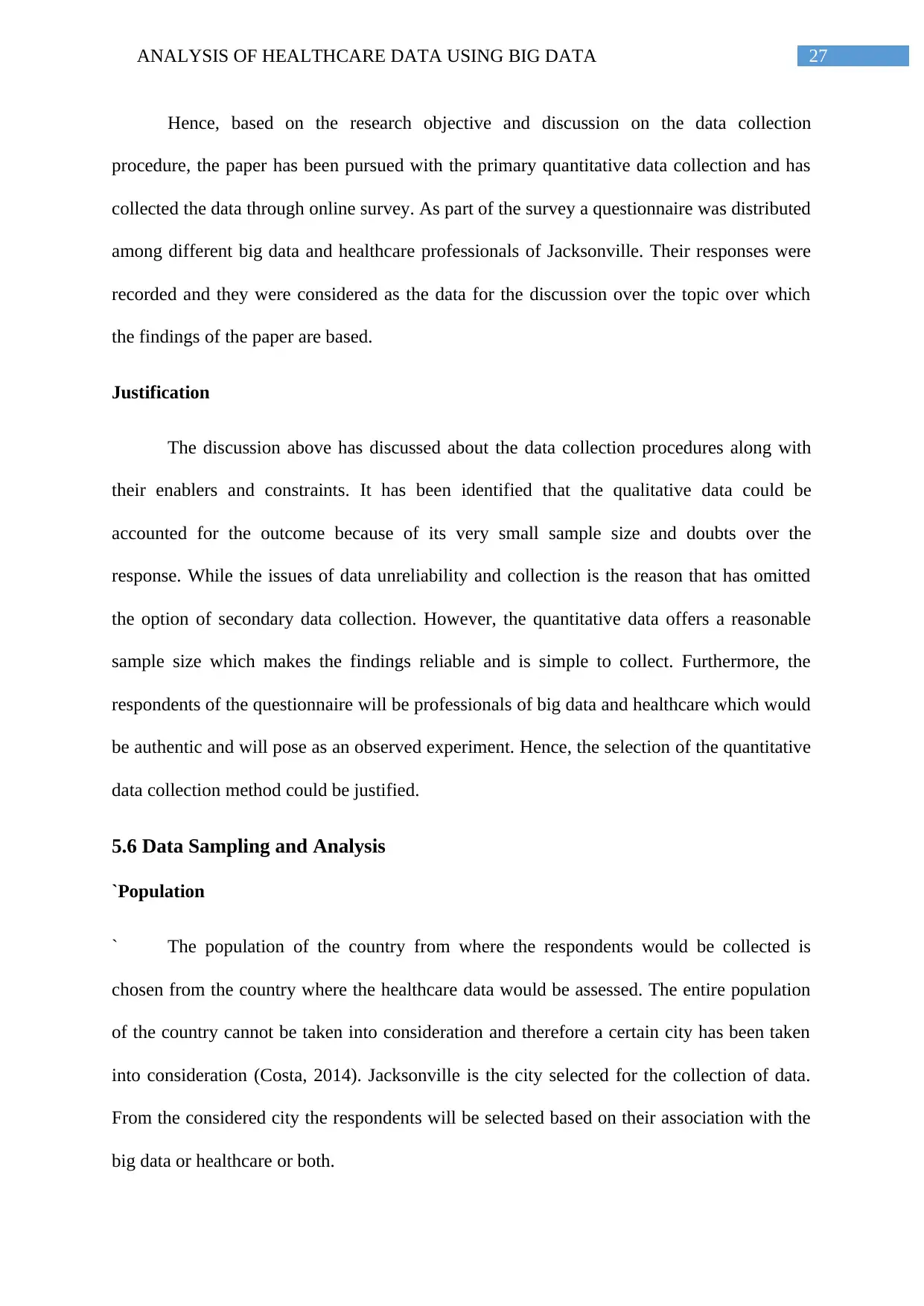
27ANALYSIS OF HEALTHCARE DATA USING BIG DATA
Hence, based on the research objective and discussion on the data collection
procedure, the paper has been pursued with the primary quantitative data collection and has
collected the data through online survey. As part of the survey a questionnaire was distributed
among different big data and healthcare professionals of Jacksonville. Their responses were
recorded and they were considered as the data for the discussion over the topic over which
the findings of the paper are based.
Justification
The discussion above has discussed about the data collection procedures along with
their enablers and constraints. It has been identified that the qualitative data could be
accounted for the outcome because of its very small sample size and doubts over the
response. While the issues of data unreliability and collection is the reason that has omitted
the option of secondary data collection. However, the quantitative data offers a reasonable
sample size which makes the findings reliable and is simple to collect. Furthermore, the
respondents of the questionnaire will be professionals of big data and healthcare which would
be authentic and will pose as an observed experiment. Hence, the selection of the quantitative
data collection method could be justified.
5.6 Data Sampling and Analysis
`Population
` The population of the country from where the respondents would be collected is
chosen from the country where the healthcare data would be assessed. The entire population
of the country cannot be taken into consideration and therefore a certain city has been taken
into consideration (Costa, 2014). Jacksonville is the city selected for the collection of data.
From the considered city the respondents will be selected based on their association with the
big data or healthcare or both.
Hence, based on the research objective and discussion on the data collection
procedure, the paper has been pursued with the primary quantitative data collection and has
collected the data through online survey. As part of the survey a questionnaire was distributed
among different big data and healthcare professionals of Jacksonville. Their responses were
recorded and they were considered as the data for the discussion over the topic over which
the findings of the paper are based.
Justification
The discussion above has discussed about the data collection procedures along with
their enablers and constraints. It has been identified that the qualitative data could be
accounted for the outcome because of its very small sample size and doubts over the
response. While the issues of data unreliability and collection is the reason that has omitted
the option of secondary data collection. However, the quantitative data offers a reasonable
sample size which makes the findings reliable and is simple to collect. Furthermore, the
respondents of the questionnaire will be professionals of big data and healthcare which would
be authentic and will pose as an observed experiment. Hence, the selection of the quantitative
data collection method could be justified.
5.6 Data Sampling and Analysis
`Population
` The population of the country from where the respondents would be collected is
chosen from the country where the healthcare data would be assessed. The entire population
of the country cannot be taken into consideration and therefore a certain city has been taken
into consideration (Costa, 2014). Jacksonville is the city selected for the collection of data.
From the considered city the respondents will be selected based on their association with the
big data or healthcare or both.
Secure Best Marks with AI Grader
Need help grading? Try our AI Grader for instant feedback on your assignments.
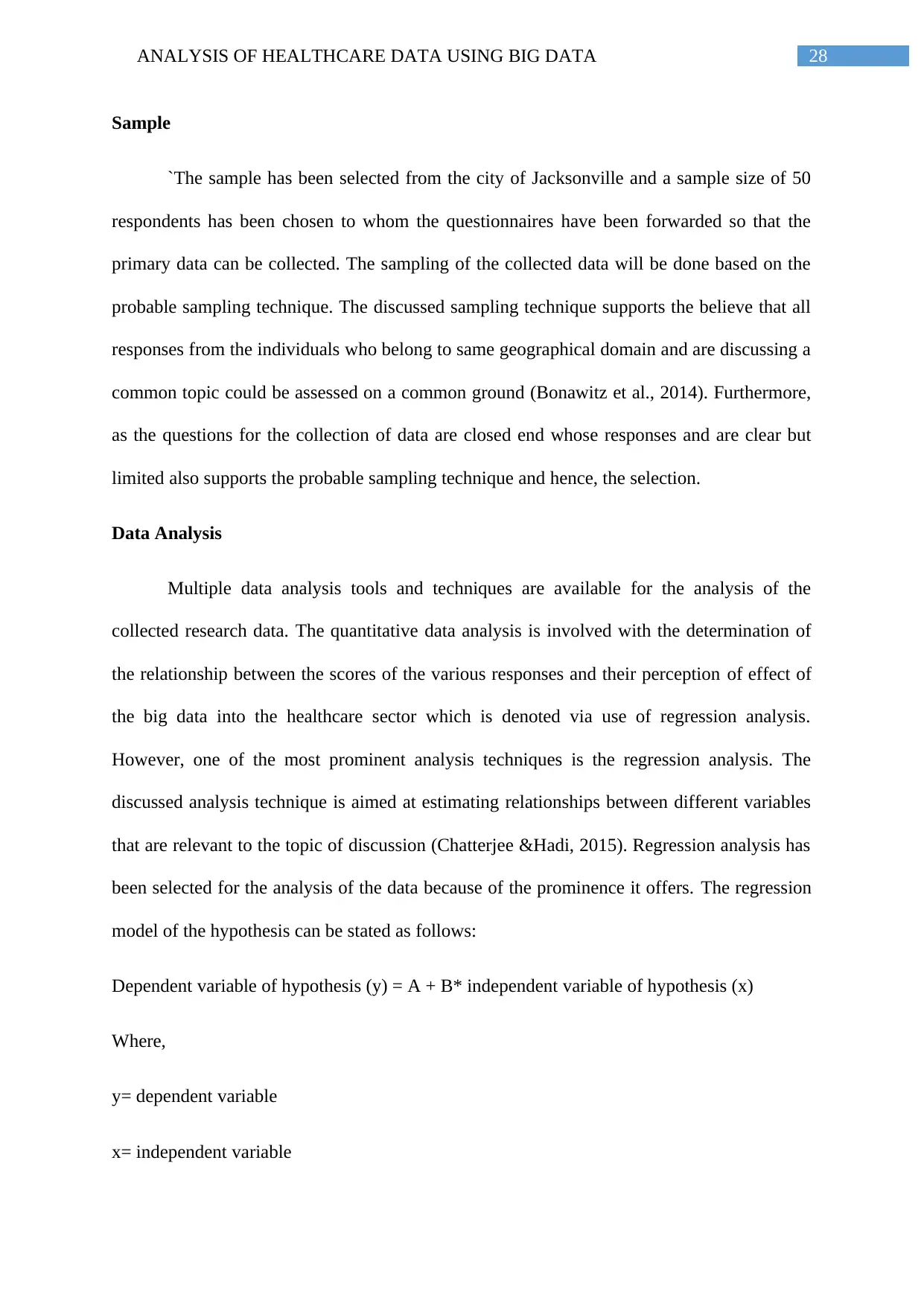
28ANALYSIS OF HEALTHCARE DATA USING BIG DATA
Sample
`The sample has been selected from the city of Jacksonville and a sample size of 50
respondents has been chosen to whom the questionnaires have been forwarded so that the
primary data can be collected. The sampling of the collected data will be done based on the
probable sampling technique. The discussed sampling technique supports the believe that all
responses from the individuals who belong to same geographical domain and are discussing a
common topic could be assessed on a common ground (Bonawitz et al., 2014). Furthermore,
as the questions for the collection of data are closed end whose responses and are clear but
limited also supports the probable sampling technique and hence, the selection.
Data Analysis
Multiple data analysis tools and techniques are available for the analysis of the
collected research data. The quantitative data analysis is involved with the determination of
the relationship between the scores of the various responses and their perception of effect of
the big data into the healthcare sector which is denoted via use of regression analysis.
However, one of the most prominent analysis techniques is the regression analysis. The
discussed analysis technique is aimed at estimating relationships between different variables
that are relevant to the topic of discussion (Chatterjee &Hadi, 2015). Regression analysis has
been selected for the analysis of the data because of the prominence it offers. The regression
model of the hypothesis can be stated as follows:
Dependent variable of hypothesis (y) = A + B* independent variable of hypothesis (x)
Where,
y= dependent variable
x= independent variable
Sample
`The sample has been selected from the city of Jacksonville and a sample size of 50
respondents has been chosen to whom the questionnaires have been forwarded so that the
primary data can be collected. The sampling of the collected data will be done based on the
probable sampling technique. The discussed sampling technique supports the believe that all
responses from the individuals who belong to same geographical domain and are discussing a
common topic could be assessed on a common ground (Bonawitz et al., 2014). Furthermore,
as the questions for the collection of data are closed end whose responses and are clear but
limited also supports the probable sampling technique and hence, the selection.
Data Analysis
Multiple data analysis tools and techniques are available for the analysis of the
collected research data. The quantitative data analysis is involved with the determination of
the relationship between the scores of the various responses and their perception of effect of
the big data into the healthcare sector which is denoted via use of regression analysis.
However, one of the most prominent analysis techniques is the regression analysis. The
discussed analysis technique is aimed at estimating relationships between different variables
that are relevant to the topic of discussion (Chatterjee &Hadi, 2015). Regression analysis has
been selected for the analysis of the data because of the prominence it offers. The regression
model of the hypothesis can be stated as follows:
Dependent variable of hypothesis (y) = A + B* independent variable of hypothesis (x)
Where,
y= dependent variable
x= independent variable
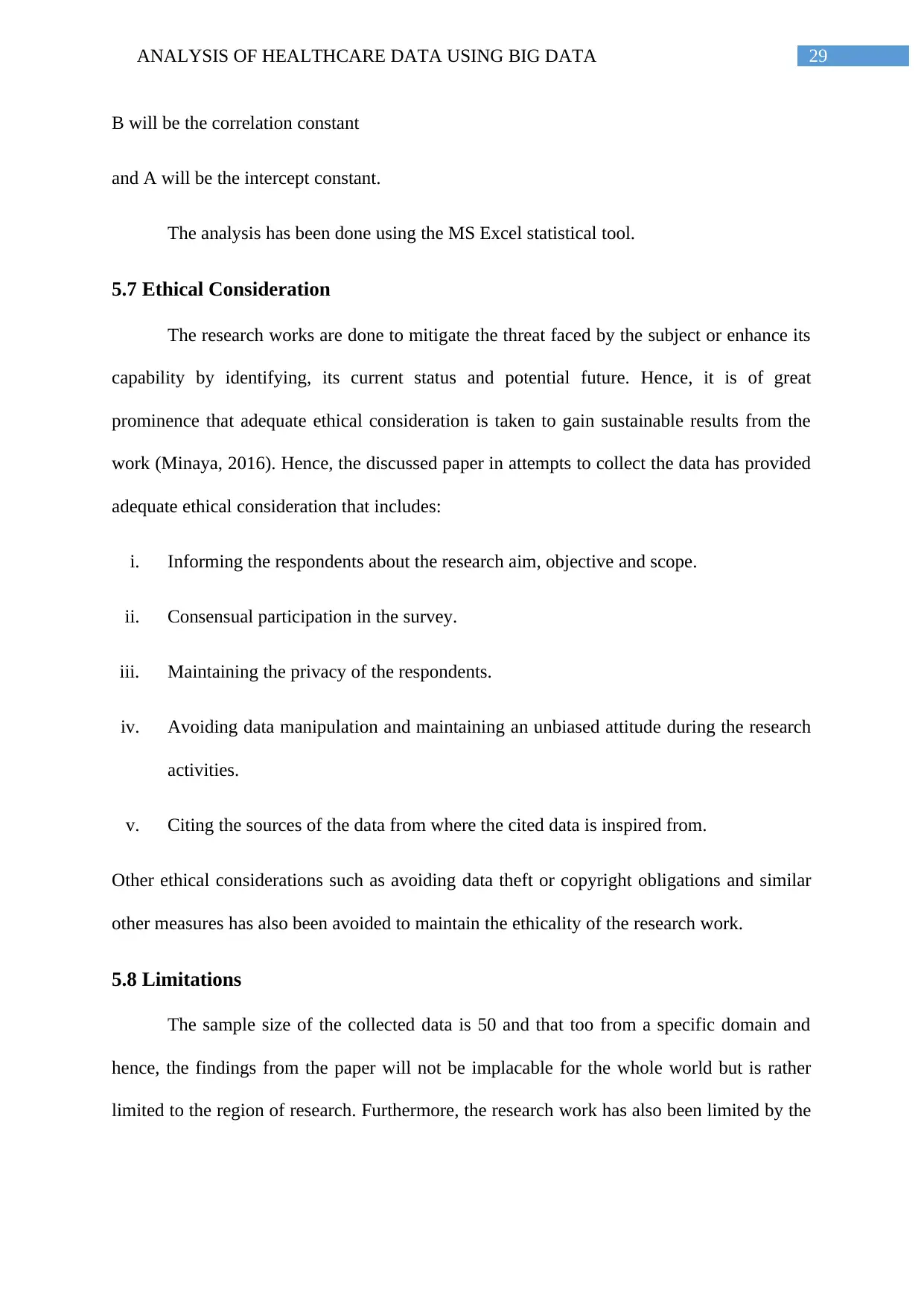
29ANALYSIS OF HEALTHCARE DATA USING BIG DATA
B will be the correlation constant
and A will be the intercept constant.
The analysis has been done using the MS Excel statistical tool.
5.7 Ethical Consideration
The research works are done to mitigate the threat faced by the subject or enhance its
capability by identifying, its current status and potential future. Hence, it is of great
prominence that adequate ethical consideration is taken to gain sustainable results from the
work (Minaya, 2016). Hence, the discussed paper in attempts to collect the data has provided
adequate ethical consideration that includes:
i. Informing the respondents about the research aim, objective and scope.
ii. Consensual participation in the survey.
iii. Maintaining the privacy of the respondents.
iv. Avoiding data manipulation and maintaining an unbiased attitude during the research
activities.
v. Citing the sources of the data from where the cited data is inspired from.
Other ethical considerations such as avoiding data theft or copyright obligations and similar
other measures has also been avoided to maintain the ethicality of the research work.
5.8 Limitations
The sample size of the collected data is 50 and that too from a specific domain and
hence, the findings from the paper will not be implacable for the whole world but is rather
limited to the region of research. Furthermore, the research work has also been limited by the
B will be the correlation constant
and A will be the intercept constant.
The analysis has been done using the MS Excel statistical tool.
5.7 Ethical Consideration
The research works are done to mitigate the threat faced by the subject or enhance its
capability by identifying, its current status and potential future. Hence, it is of great
prominence that adequate ethical consideration is taken to gain sustainable results from the
work (Minaya, 2016). Hence, the discussed paper in attempts to collect the data has provided
adequate ethical consideration that includes:
i. Informing the respondents about the research aim, objective and scope.
ii. Consensual participation in the survey.
iii. Maintaining the privacy of the respondents.
iv. Avoiding data manipulation and maintaining an unbiased attitude during the research
activities.
v. Citing the sources of the data from where the cited data is inspired from.
Other ethical considerations such as avoiding data theft or copyright obligations and similar
other measures has also been avoided to maintain the ethicality of the research work.
5.8 Limitations
The sample size of the collected data is 50 and that too from a specific domain and
hence, the findings from the paper will not be implacable for the whole world but is rather
limited to the region of research. Furthermore, the research work has also been limited by the
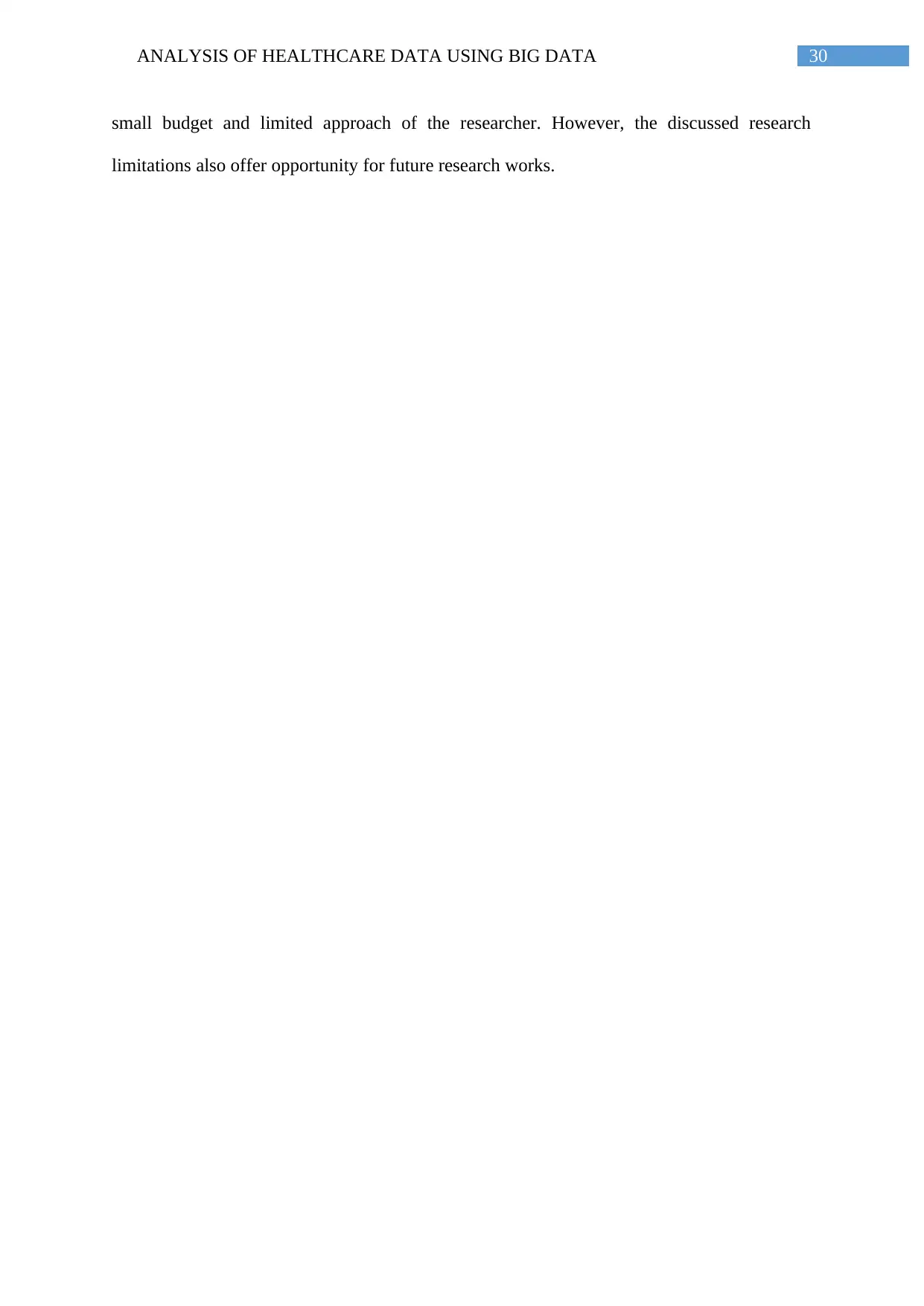
30ANALYSIS OF HEALTHCARE DATA USING BIG DATA
small budget and limited approach of the researcher. However, the discussed research
limitations also offer opportunity for future research works.
small budget and limited approach of the researcher. However, the discussed research
limitations also offer opportunity for future research works.
Paraphrase This Document
Need a fresh take? Get an instant paraphrase of this document with our AI Paraphraser

31ANALYSIS OF HEALTHCARE DATA USING BIG DATA
Chapter 6: Anticipated timeline
This particular thesis work is occurred for 6 months and laid with the research plan.
This section shows the timeline of this project; describe the research activities and goals to
investigate the selected thesis topic. The project work was started at the month of March and
finished at end of September, 2018. The survey questionnaire is done.
WBS Task Name Duration Start Finish
0 Research paper 133 days Wed 3/7/18 Fri 9/7/18
1 Select research topic 18 days Wed 3/7/18 Fri 3/30/18
1.1 Select a topic based on healthcare data 2 days Wed 3/7/18 Thu 3/8/18
1.2
Develop a research draft based on
requirements
2 days Fri 3/9/18 Mon 3/12/18
1.3 Aim of the thesis paper 4 days Tue 3/13/18 Fri 3/16/18
1.4 Analyze the research objectives 6 days Mon 3/19/18 Mon 3/26/18
1.5 Analyze the research questions 4 days Tue 3/27/18 Fri 3/30/18
2 Literature review 22 days Mon 4/2/18 Tue 5/1/18
2.1 Analyze the healthcare data using big data 4 days Mon 4/2/18 Thu 4/5/18
2.2
Identification of the added value of Big Data
in health practices
3 days Fri 4/6/18 Tue 4/10/18
2.3 19 10 days Wed 4/11/18 Tue 4/24/18
2.4 Big data in healthcare 5 days Wed 4/25/18 Tue 5/1/18
Chapter 6: Anticipated timeline
This particular thesis work is occurred for 6 months and laid with the research plan.
This section shows the timeline of this project; describe the research activities and goals to
investigate the selected thesis topic. The project work was started at the month of March and
finished at end of September, 2018. The survey questionnaire is done.
WBS Task Name Duration Start Finish
0 Research paper 133 days Wed 3/7/18 Fri 9/7/18
1 Select research topic 18 days Wed 3/7/18 Fri 3/30/18
1.1 Select a topic based on healthcare data 2 days Wed 3/7/18 Thu 3/8/18
1.2
Develop a research draft based on
requirements
2 days Fri 3/9/18 Mon 3/12/18
1.3 Aim of the thesis paper 4 days Tue 3/13/18 Fri 3/16/18
1.4 Analyze the research objectives 6 days Mon 3/19/18 Mon 3/26/18
1.5 Analyze the research questions 4 days Tue 3/27/18 Fri 3/30/18
2 Literature review 22 days Mon 4/2/18 Tue 5/1/18
2.1 Analyze the healthcare data using big data 4 days Mon 4/2/18 Thu 4/5/18
2.2
Identification of the added value of Big Data
in health practices
3 days Fri 4/6/18 Tue 4/10/18
2.3 19 10 days Wed 4/11/18 Tue 4/24/18
2.4 Big data in healthcare 5 days Wed 4/25/18 Tue 5/1/18
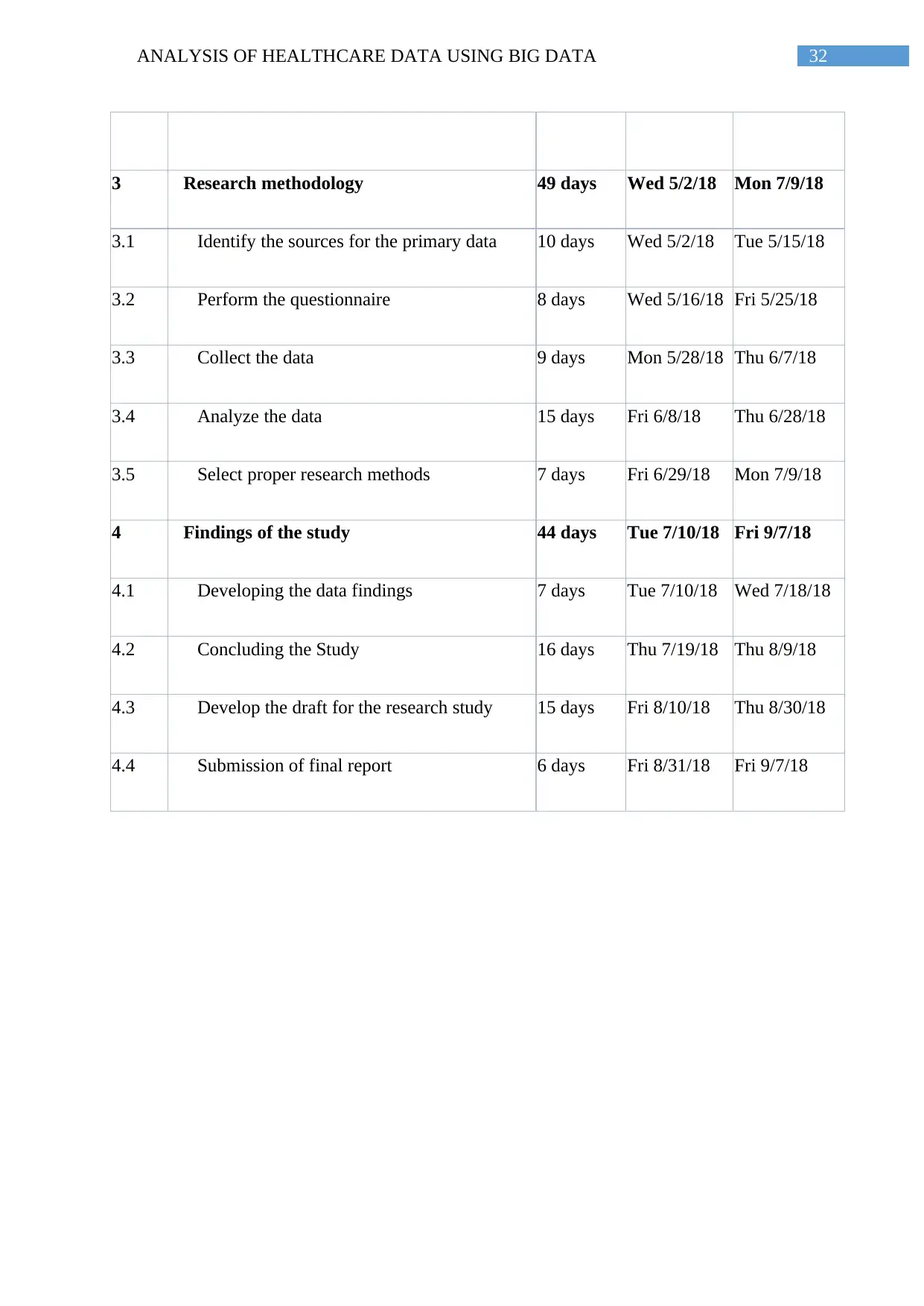
32ANALYSIS OF HEALTHCARE DATA USING BIG DATA
3 Research methodology 49 days Wed 5/2/18 Mon 7/9/18
3.1 Identify the sources for the primary data 10 days Wed 5/2/18 Tue 5/15/18
3.2 Perform the questionnaire 8 days Wed 5/16/18 Fri 5/25/18
3.3 Collect the data 9 days Mon 5/28/18 Thu 6/7/18
3.4 Analyze the data 15 days Fri 6/8/18 Thu 6/28/18
3.5 Select proper research methods 7 days Fri 6/29/18 Mon 7/9/18
4 Findings of the study 44 days Tue 7/10/18 Fri 9/7/18
4.1 Developing the data findings 7 days Tue 7/10/18 Wed 7/18/18
4.2 Concluding the Study 16 days Thu 7/19/18 Thu 8/9/18
4.3 Develop the draft for the research study 15 days Fri 8/10/18 Thu 8/30/18
4.4 Submission of final report 6 days Fri 8/31/18 Fri 9/7/18
3 Research methodology 49 days Wed 5/2/18 Mon 7/9/18
3.1 Identify the sources for the primary data 10 days Wed 5/2/18 Tue 5/15/18
3.2 Perform the questionnaire 8 days Wed 5/16/18 Fri 5/25/18
3.3 Collect the data 9 days Mon 5/28/18 Thu 6/7/18
3.4 Analyze the data 15 days Fri 6/8/18 Thu 6/28/18
3.5 Select proper research methods 7 days Fri 6/29/18 Mon 7/9/18
4 Findings of the study 44 days Tue 7/10/18 Fri 9/7/18
4.1 Developing the data findings 7 days Tue 7/10/18 Wed 7/18/18
4.2 Concluding the Study 16 days Thu 7/19/18 Thu 8/9/18
4.3 Develop the draft for the research study 15 days Fri 8/10/18 Thu 8/30/18
4.4 Submission of final report 6 days Fri 8/31/18 Fri 9/7/18
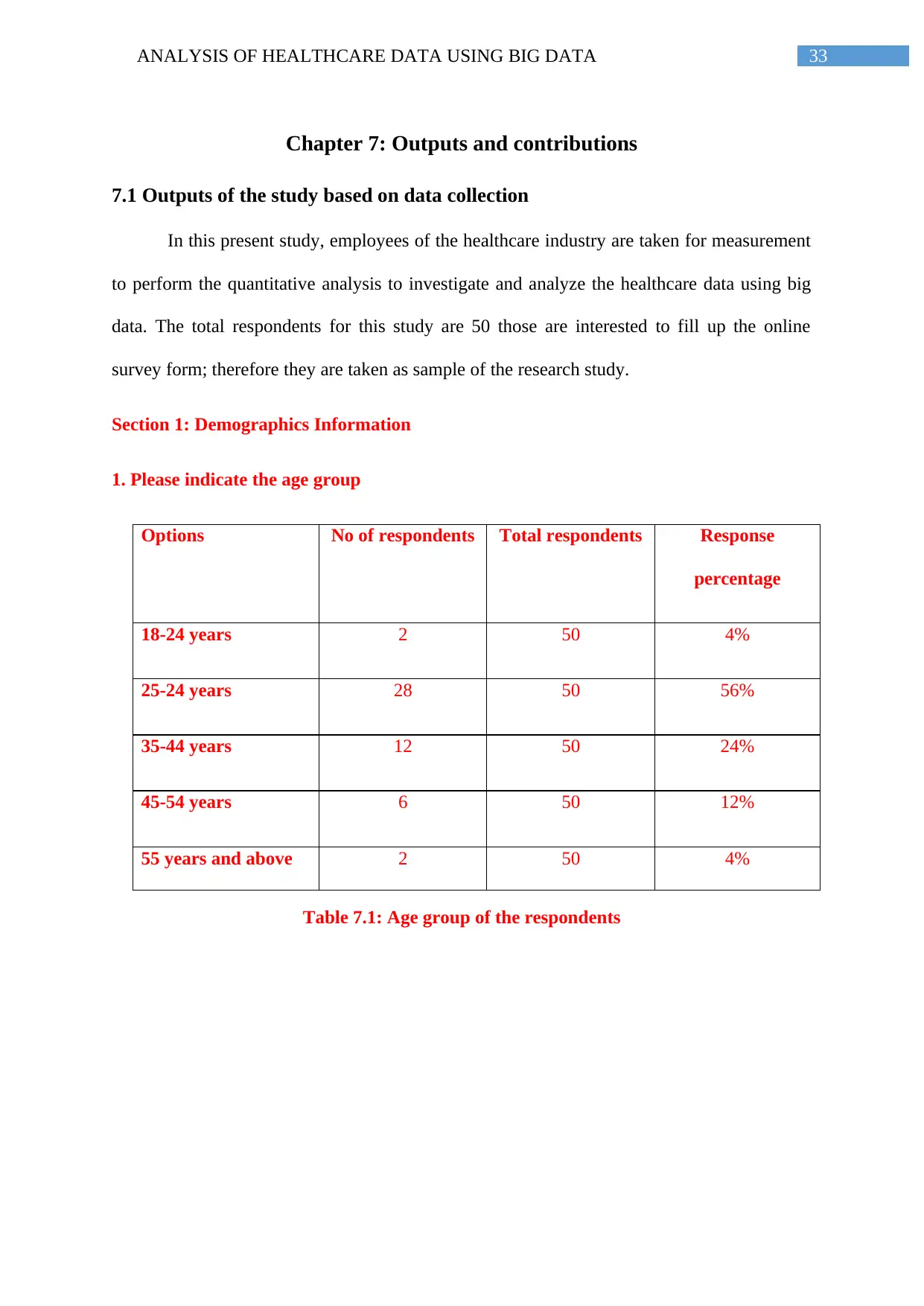
33ANALYSIS OF HEALTHCARE DATA USING BIG DATA
Chapter 7: Outputs and contributions
7.1 Outputs of the study based on data collection
In this present study, employees of the healthcare industry are taken for measurement
to perform the quantitative analysis to investigate and analyze the healthcare data using big
data. The total respondents for this study are 50 those are interested to fill up the online
survey form; therefore they are taken as sample of the research study.
Section 1: Demographics Information
1. Please indicate the age group
Options No of respondents Total respondents Response
percentage
18-24 years 2 50 4%
25-24 years 28 50 56%
35-44 years 12 50 24%
45-54 years 6 50 12%
55 years and above 2 50 4%
Table 7.1: Age group of the respondents
Chapter 7: Outputs and contributions
7.1 Outputs of the study based on data collection
In this present study, employees of the healthcare industry are taken for measurement
to perform the quantitative analysis to investigate and analyze the healthcare data using big
data. The total respondents for this study are 50 those are interested to fill up the online
survey form; therefore they are taken as sample of the research study.
Section 1: Demographics Information
1. Please indicate the age group
Options No of respondents Total respondents Response
percentage
18-24 years 2 50 4%
25-24 years 28 50 56%
35-44 years 12 50 24%
45-54 years 6 50 12%
55 years and above 2 50 4%
Table 7.1: Age group of the respondents
Secure Best Marks with AI Grader
Need help grading? Try our AI Grader for instant feedback on your assignments.
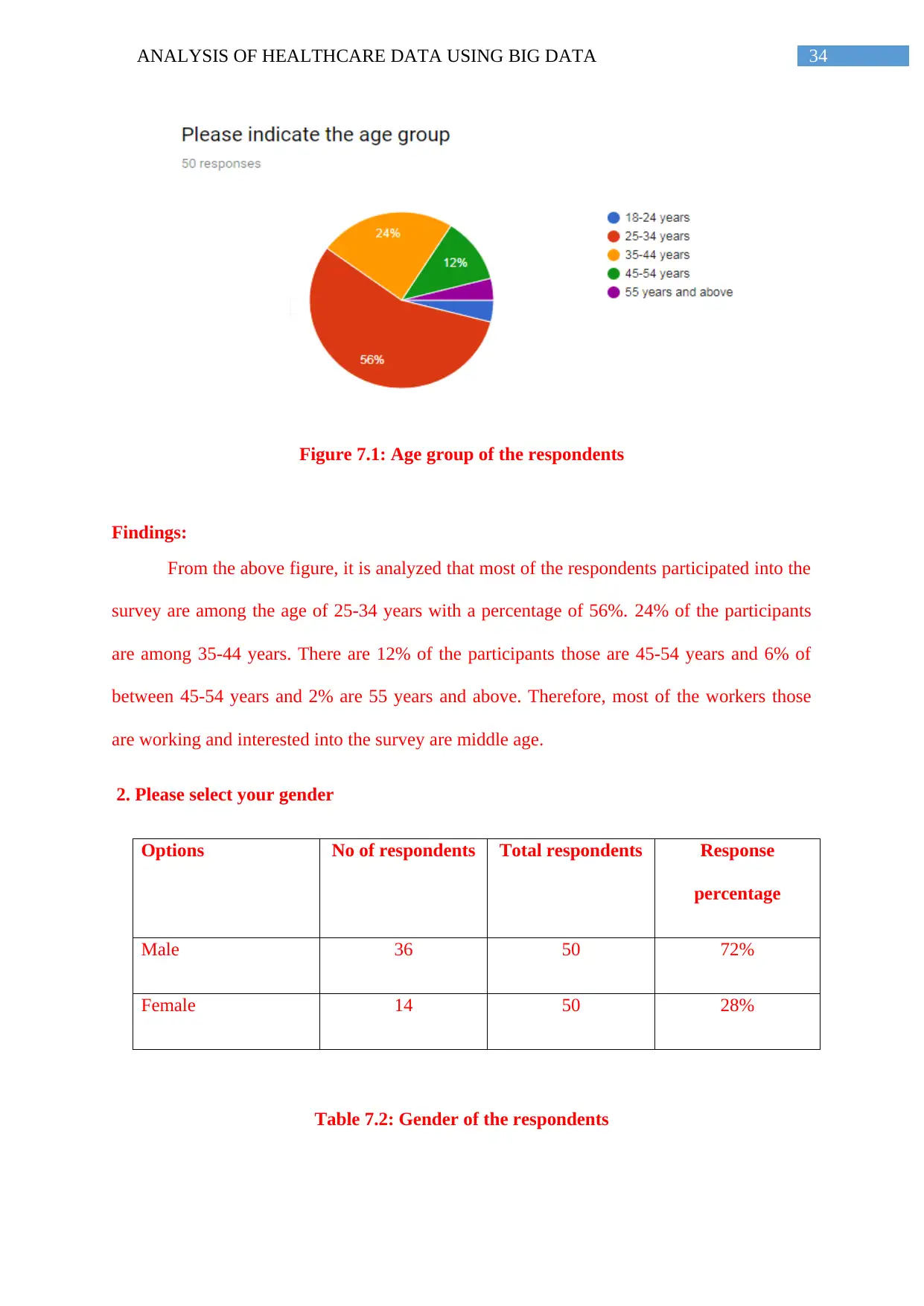
34ANALYSIS OF HEALTHCARE DATA USING BIG DATA
Figure 7.1: Age group of the respondents
Findings:
From the above figure, it is analyzed that most of the respondents participated into the
survey are among the age of 25-34 years with a percentage of 56%. 24% of the participants
are among 35-44 years. There are 12% of the participants those are 45-54 years and 6% of
between 45-54 years and 2% are 55 years and above. Therefore, most of the workers those
are working and interested into the survey are middle age.
2. Please select your gender
Options No of respondents Total respondents Response
percentage
Male 36 50 72%
Female 14 50 28%
Table 7.2: Gender of the respondents
Figure 7.1: Age group of the respondents
Findings:
From the above figure, it is analyzed that most of the respondents participated into the
survey are among the age of 25-34 years with a percentage of 56%. 24% of the participants
are among 35-44 years. There are 12% of the participants those are 45-54 years and 6% of
between 45-54 years and 2% are 55 years and above. Therefore, most of the workers those
are working and interested into the survey are middle age.
2. Please select your gender
Options No of respondents Total respondents Response
percentage
Male 36 50 72%
Female 14 50 28%
Table 7.2: Gender of the respondents

35ANALYSIS OF HEALTHCARE DATA USING BIG DATA
Figure 7.2: Gender of the respondents
Findings:
From the above figure, it is analyzed that 72% of the respondents are male and 28%
of them are female. Therefore, both male as well as female is interested in this research study
to provide their feedback on analyzing the healthcare data using big data.
3. Please select your designation
Options No of respondents Total respondents Response
percentage
Project manager 7 50 14%
Employee 16 50 32%
IT Manager 18 50 36%
System Analyst 9 50 18%
Figure 7.2: Gender of the respondents
Findings:
From the above figure, it is analyzed that 72% of the respondents are male and 28%
of them are female. Therefore, both male as well as female is interested in this research study
to provide their feedback on analyzing the healthcare data using big data.
3. Please select your designation
Options No of respondents Total respondents Response
percentage
Project manager 7 50 14%
Employee 16 50 32%
IT Manager 18 50 36%
System Analyst 9 50 18%

36ANALYSIS OF HEALTHCARE DATA USING BIG DATA
Table 7.3: Designation of the respondents
Figure 7.3: Designation of the respondents
Findings:
From the above figure, it is analyzed that 32% of the respondents for the survey are
normal employee those are not from the senior management level. 36% of the respondents
are IT Manager, 14% are Project Manager and 18% are System Analyst. Therefore, the IT
managers are more interested in the survey to provide their feedback.
4. Do you process streamlining big data in your industry?
Options No of respondents Total respondents Response
percentage
Yes 48 50 96%
No 2 50 4%
Table 7.3: Designation of the respondents
Figure 7.3: Designation of the respondents
Findings:
From the above figure, it is analyzed that 32% of the respondents for the survey are
normal employee those are not from the senior management level. 36% of the respondents
are IT Manager, 14% are Project Manager and 18% are System Analyst. Therefore, the IT
managers are more interested in the survey to provide their feedback.
4. Do you process streamlining big data in your industry?
Options No of respondents Total respondents Response
percentage
Yes 48 50 96%
No 2 50 4%
Paraphrase This Document
Need a fresh take? Get an instant paraphrase of this document with our AI Paraphraser
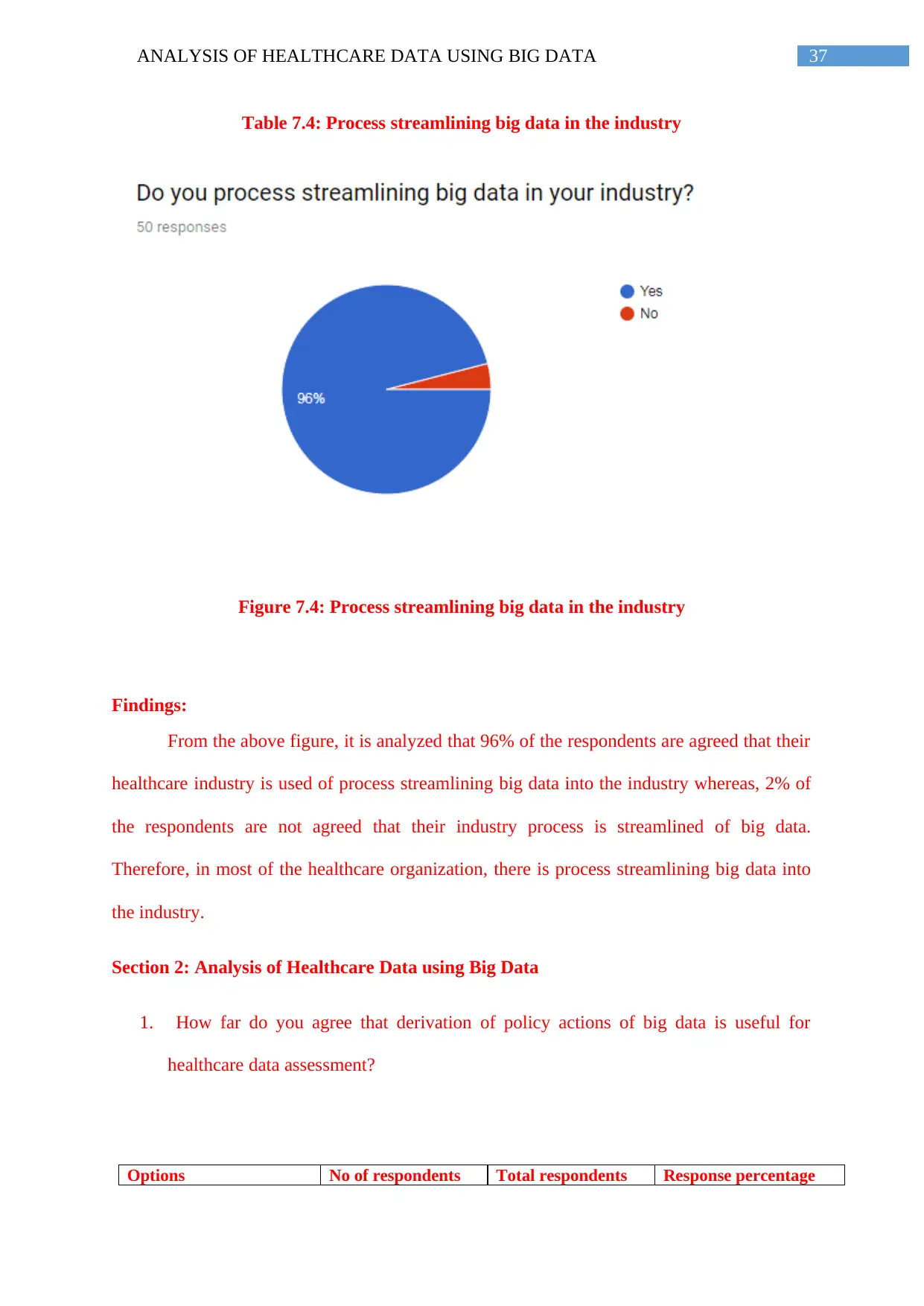
37ANALYSIS OF HEALTHCARE DATA USING BIG DATA
Table 7.4: Process streamlining big data in the industry
Figure 7.4: Process streamlining big data in the industry
Findings:
From the above figure, it is analyzed that 96% of the respondents are agreed that their
healthcare industry is used of process streamlining big data into the industry whereas, 2% of
the respondents are not agreed that their industry process is streamlined of big data.
Therefore, in most of the healthcare organization, there is process streamlining big data into
the industry.
Section 2: Analysis of Healthcare Data using Big Data
1. How far do you agree that derivation of policy actions of big data is useful for
healthcare data assessment?
Options No of respondents Total respondents Response percentage
Table 7.4: Process streamlining big data in the industry
Figure 7.4: Process streamlining big data in the industry
Findings:
From the above figure, it is analyzed that 96% of the respondents are agreed that their
healthcare industry is used of process streamlining big data into the industry whereas, 2% of
the respondents are not agreed that their industry process is streamlined of big data.
Therefore, in most of the healthcare organization, there is process streamlining big data into
the industry.
Section 2: Analysis of Healthcare Data using Big Data
1. How far do you agree that derivation of policy actions of big data is useful for
healthcare data assessment?
Options No of respondents Total respondents Response percentage
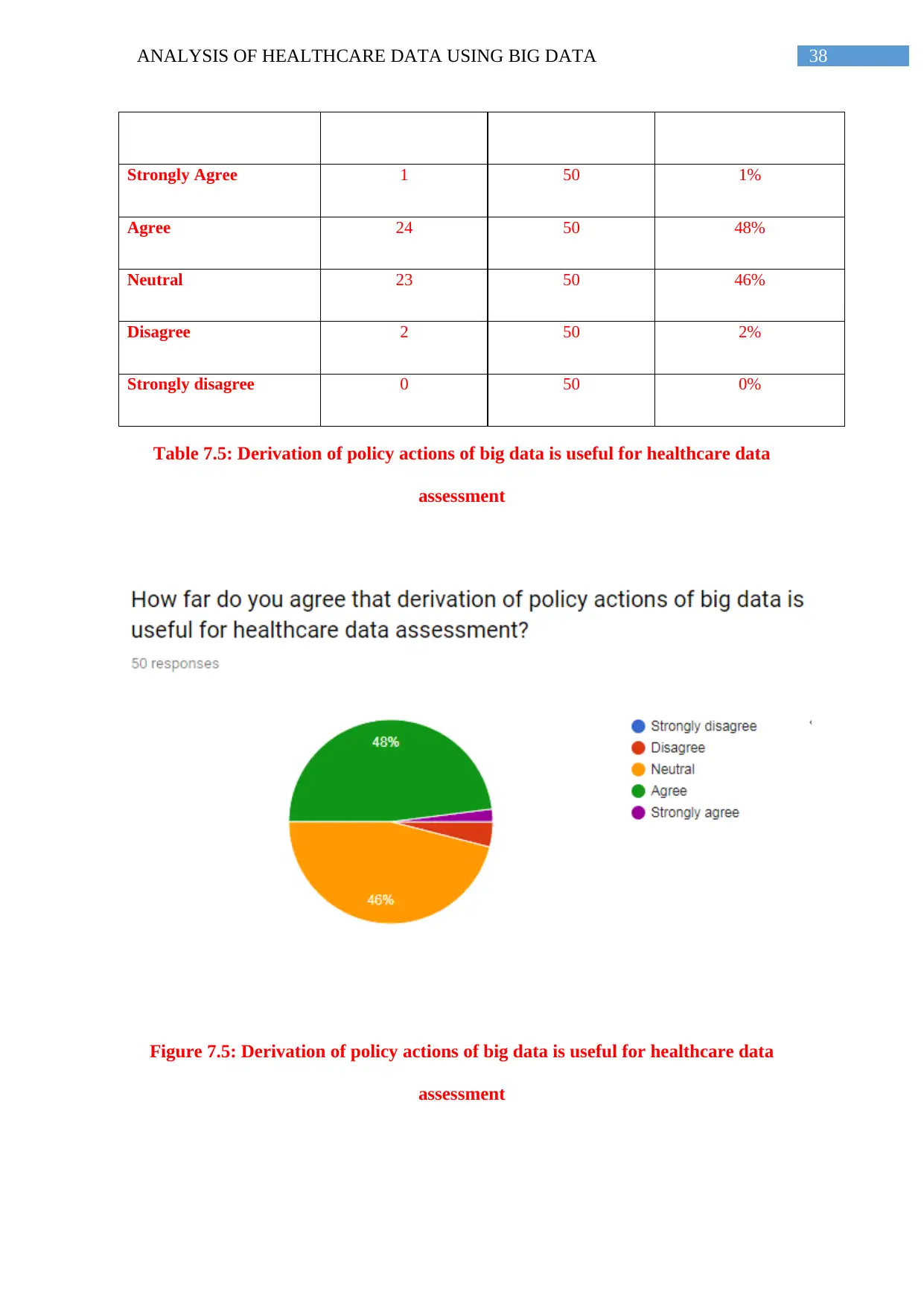
38ANALYSIS OF HEALTHCARE DATA USING BIG DATA
Strongly Agree 1 50 1%
Agree 24 50 48%
Neutral 23 50 46%
Disagree 2 50 2%
Strongly disagree 0 50 0%
Table 7.5: Derivation of policy actions of big data is useful for healthcare data
assessment
Figure 7.5: Derivation of policy actions of big data is useful for healthcare data
assessment
Strongly Agree 1 50 1%
Agree 24 50 48%
Neutral 23 50 46%
Disagree 2 50 2%
Strongly disagree 0 50 0%
Table 7.5: Derivation of policy actions of big data is useful for healthcare data
assessment
Figure 7.5: Derivation of policy actions of big data is useful for healthcare data
assessment
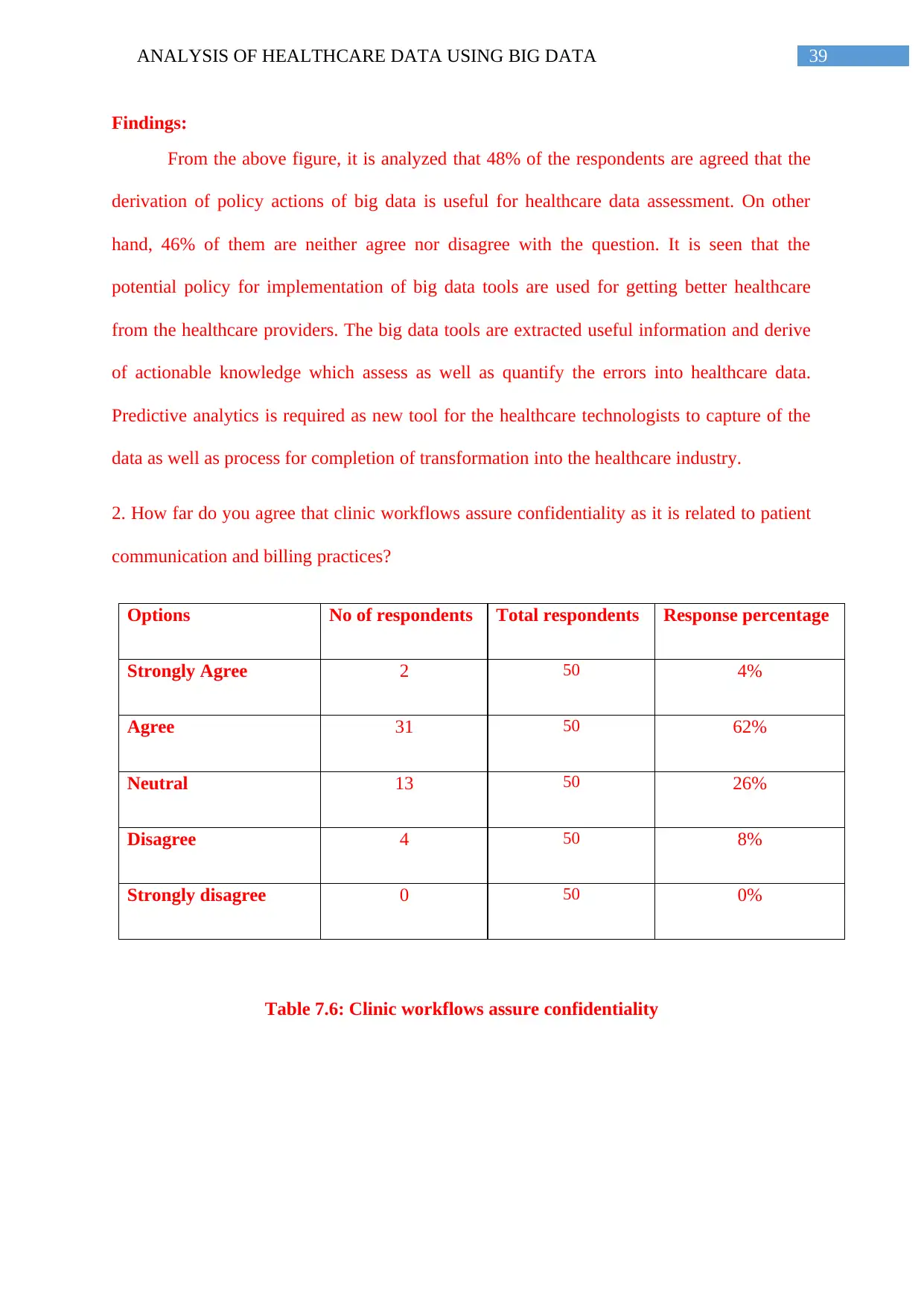
39ANALYSIS OF HEALTHCARE DATA USING BIG DATA
Findings:
From the above figure, it is analyzed that 48% of the respondents are agreed that the
derivation of policy actions of big data is useful for healthcare data assessment. On other
hand, 46% of them are neither agree nor disagree with the question. It is seen that the
potential policy for implementation of big data tools are used for getting better healthcare
from the healthcare providers. The big data tools are extracted useful information and derive
of actionable knowledge which assess as well as quantify the errors into healthcare data.
Predictive analytics is required as new tool for the healthcare technologists to capture of the
data as well as process for completion of transformation into the healthcare industry.
2. How far do you agree that clinic workflows assure confidentiality as it is related to patient
communication and billing practices?
Options No of respondents Total respondents Response percentage
Strongly Agree 2 50 4%
Agree 31 50 62%
Neutral 13 50 26%
Disagree 4 50 8%
Strongly disagree 0 50 0%
Table 7.6: Clinic workflows assure confidentiality
Findings:
From the above figure, it is analyzed that 48% of the respondents are agreed that the
derivation of policy actions of big data is useful for healthcare data assessment. On other
hand, 46% of them are neither agree nor disagree with the question. It is seen that the
potential policy for implementation of big data tools are used for getting better healthcare
from the healthcare providers. The big data tools are extracted useful information and derive
of actionable knowledge which assess as well as quantify the errors into healthcare data.
Predictive analytics is required as new tool for the healthcare technologists to capture of the
data as well as process for completion of transformation into the healthcare industry.
2. How far do you agree that clinic workflows assure confidentiality as it is related to patient
communication and billing practices?
Options No of respondents Total respondents Response percentage
Strongly Agree 2 50 4%
Agree 31 50 62%
Neutral 13 50 26%
Disagree 4 50 8%
Strongly disagree 0 50 0%
Table 7.6: Clinic workflows assure confidentiality
Secure Best Marks with AI Grader
Need help grading? Try our AI Grader for instant feedback on your assignments.
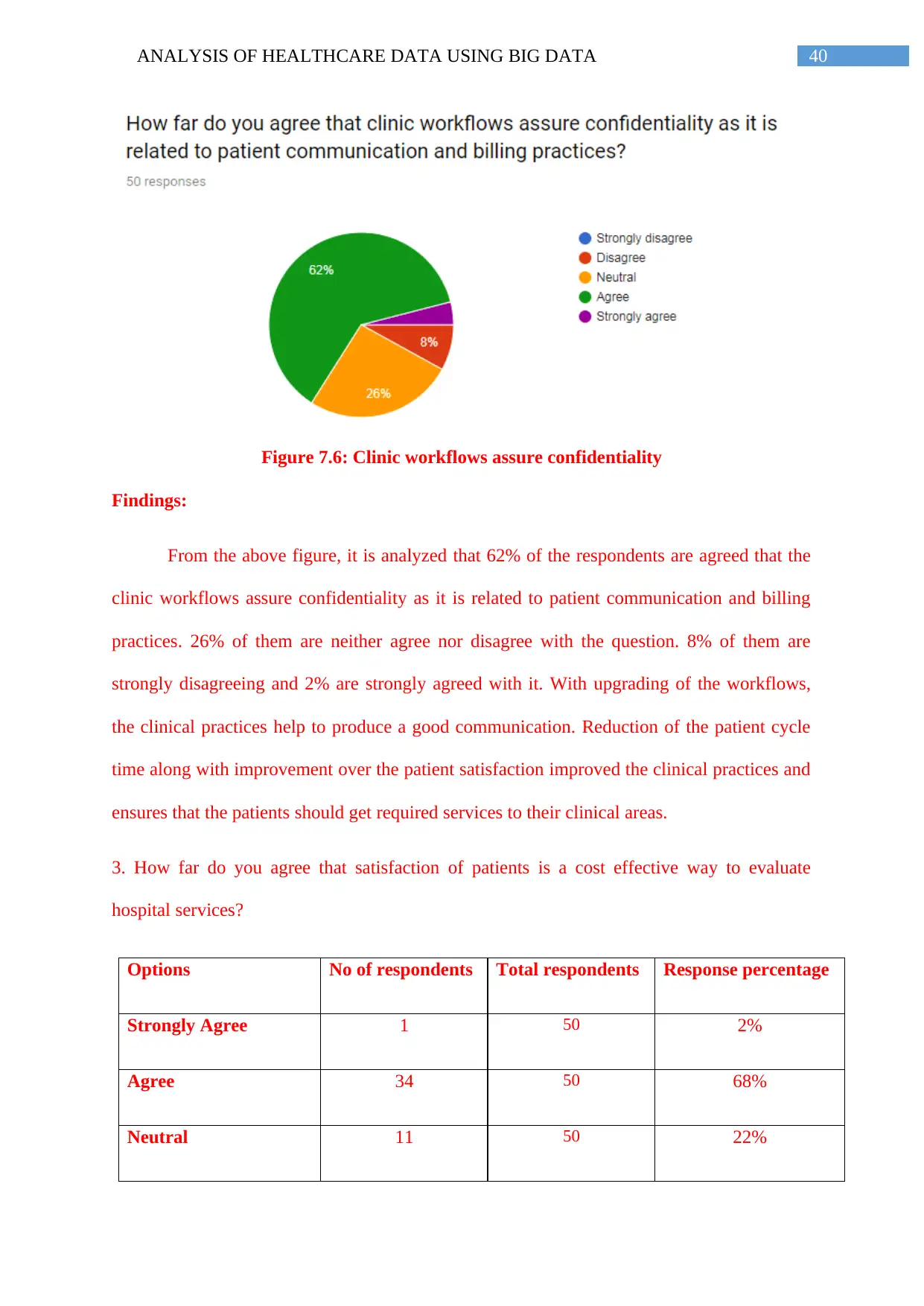
40ANALYSIS OF HEALTHCARE DATA USING BIG DATA
Figure 7.6: Clinic workflows assure confidentiality
Findings:
From the above figure, it is analyzed that 62% of the respondents are agreed that the
clinic workflows assure confidentiality as it is related to patient communication and billing
practices. 26% of them are neither agree nor disagree with the question. 8% of them are
strongly disagreeing and 2% are strongly agreed with it. With upgrading of the workflows,
the clinical practices help to produce a good communication. Reduction of the patient cycle
time along with improvement over the patient satisfaction improved the clinical practices and
ensures that the patients should get required services to their clinical areas.
3. How far do you agree that satisfaction of patients is a cost effective way to evaluate
hospital services?
Options No of respondents Total respondents Response percentage
Strongly Agree 1 50 2%
Agree 34 50 68%
Neutral 11 50 22%
Figure 7.6: Clinic workflows assure confidentiality
Findings:
From the above figure, it is analyzed that 62% of the respondents are agreed that the
clinic workflows assure confidentiality as it is related to patient communication and billing
practices. 26% of them are neither agree nor disagree with the question. 8% of them are
strongly disagreeing and 2% are strongly agreed with it. With upgrading of the workflows,
the clinical practices help to produce a good communication. Reduction of the patient cycle
time along with improvement over the patient satisfaction improved the clinical practices and
ensures that the patients should get required services to their clinical areas.
3. How far do you agree that satisfaction of patients is a cost effective way to evaluate
hospital services?
Options No of respondents Total respondents Response percentage
Strongly Agree 1 50 2%
Agree 34 50 68%
Neutral 11 50 22%

41ANALYSIS OF HEALTHCARE DATA USING BIG DATA
Disagree 3 50 6%
Strongly disagree 1 50 2%
Table 7.7: Satisfaction of patients is a cost effective way to evaluate hospital services
Figure 7.7: Satisfaction of patients is a cost effective way to evaluate hospital services
Findings:
From the above figure, it is analyzed that 68% of the respondents are agreed that
satisfaction of patients is a cost effective way to evaluate hospital services. 22% of them are
neither agree nor disagree and 2% of them are strongly agreed with it. The healthcare system
is based on availability, efficiency as well as cost which are provided to the patients. The
study shows that the patients are admitted in different wards of the hospitals should satisfied
with quality of the professional services with availability of clinical amenities. The study
Disagree 3 50 6%
Strongly disagree 1 50 2%
Table 7.7: Satisfaction of patients is a cost effective way to evaluate hospital services
Figure 7.7: Satisfaction of patients is a cost effective way to evaluate hospital services
Findings:
From the above figure, it is analyzed that 68% of the respondents are agreed that
satisfaction of patients is a cost effective way to evaluate hospital services. 22% of them are
neither agree nor disagree and 2% of them are strongly agreed with it. The healthcare system
is based on availability, efficiency as well as cost which are provided to the patients. The
study shows that the patients are admitted in different wards of the hospitals should satisfied
with quality of the professional services with availability of clinical amenities. The study
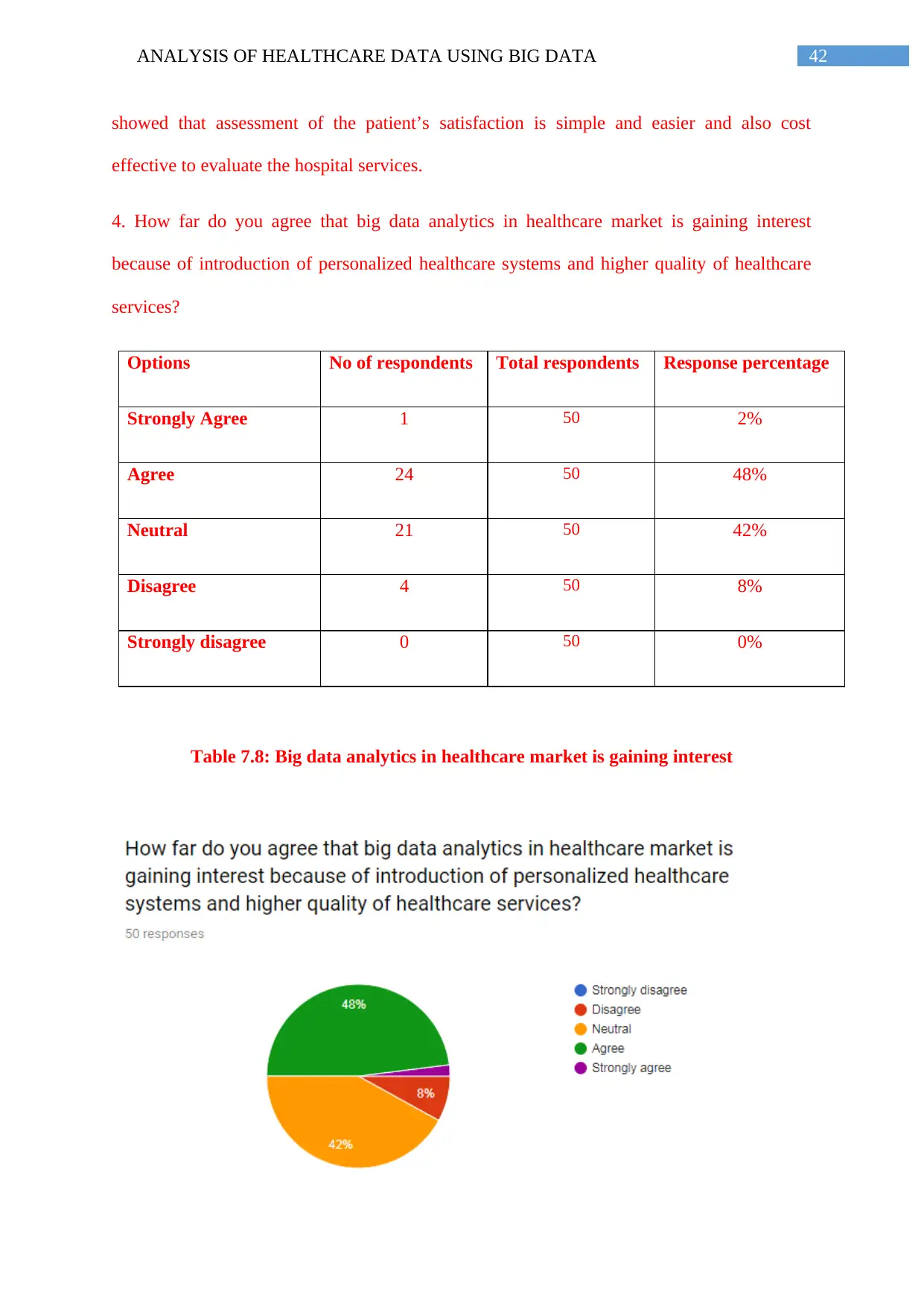
42ANALYSIS OF HEALTHCARE DATA USING BIG DATA
showed that assessment of the patient’s satisfaction is simple and easier and also cost
effective to evaluate the hospital services.
4. How far do you agree that big data analytics in healthcare market is gaining interest
because of introduction of personalized healthcare systems and higher quality of healthcare
services?
Options No of respondents Total respondents Response percentage
Strongly Agree 1 50 2%
Agree 24 50 48%
Neutral 21 50 42%
Disagree 4 50 8%
Strongly disagree 0 50 0%
Table 7.8: Big data analytics in healthcare market is gaining interest
showed that assessment of the patient’s satisfaction is simple and easier and also cost
effective to evaluate the hospital services.
4. How far do you agree that big data analytics in healthcare market is gaining interest
because of introduction of personalized healthcare systems and higher quality of healthcare
services?
Options No of respondents Total respondents Response percentage
Strongly Agree 1 50 2%
Agree 24 50 48%
Neutral 21 50 42%
Disagree 4 50 8%
Strongly disagree 0 50 0%
Table 7.8: Big data analytics in healthcare market is gaining interest
Paraphrase This Document
Need a fresh take? Get an instant paraphrase of this document with our AI Paraphraser
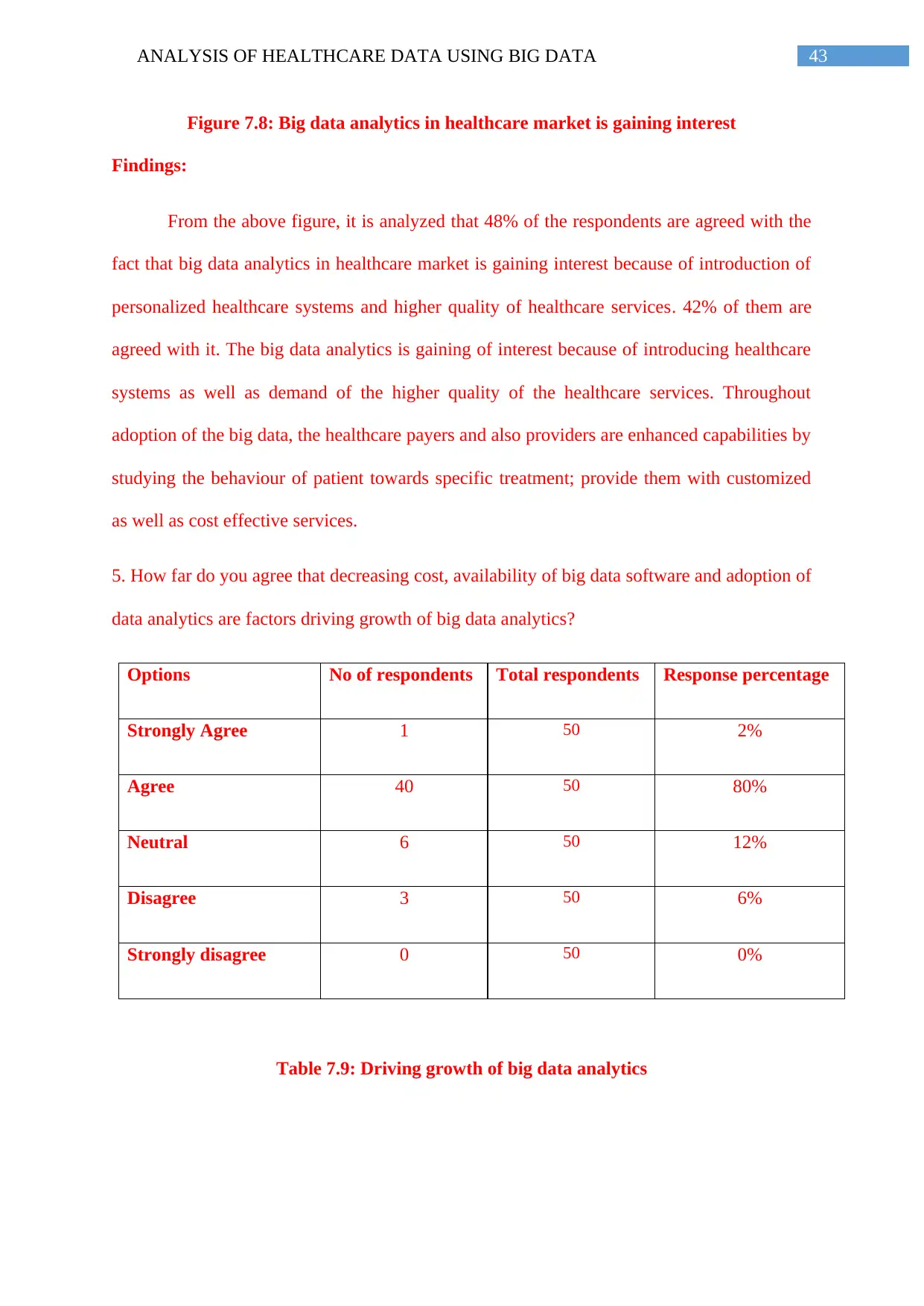
43ANALYSIS OF HEALTHCARE DATA USING BIG DATA
Figure 7.8: Big data analytics in healthcare market is gaining interest
Findings:
From the above figure, it is analyzed that 48% of the respondents are agreed with the
fact that big data analytics in healthcare market is gaining interest because of introduction of
personalized healthcare systems and higher quality of healthcare services. 42% of them are
agreed with it. The big data analytics is gaining of interest because of introducing healthcare
systems as well as demand of the higher quality of the healthcare services. Throughout
adoption of the big data, the healthcare payers and also providers are enhanced capabilities by
studying the behaviour of patient towards specific treatment; provide them with customized
as well as cost effective services.
5. How far do you agree that decreasing cost, availability of big data software and adoption of
data analytics are factors driving growth of big data analytics?
Options No of respondents Total respondents Response percentage
Strongly Agree 1 50 2%
Agree 40 50 80%
Neutral 6 50 12%
Disagree 3 50 6%
Strongly disagree 0 50 0%
Table 7.9: Driving growth of big data analytics
Figure 7.8: Big data analytics in healthcare market is gaining interest
Findings:
From the above figure, it is analyzed that 48% of the respondents are agreed with the
fact that big data analytics in healthcare market is gaining interest because of introduction of
personalized healthcare systems and higher quality of healthcare services. 42% of them are
agreed with it. The big data analytics is gaining of interest because of introducing healthcare
systems as well as demand of the higher quality of the healthcare services. Throughout
adoption of the big data, the healthcare payers and also providers are enhanced capabilities by
studying the behaviour of patient towards specific treatment; provide them with customized
as well as cost effective services.
5. How far do you agree that decreasing cost, availability of big data software and adoption of
data analytics are factors driving growth of big data analytics?
Options No of respondents Total respondents Response percentage
Strongly Agree 1 50 2%
Agree 40 50 80%
Neutral 6 50 12%
Disagree 3 50 6%
Strongly disagree 0 50 0%
Table 7.9: Driving growth of big data analytics
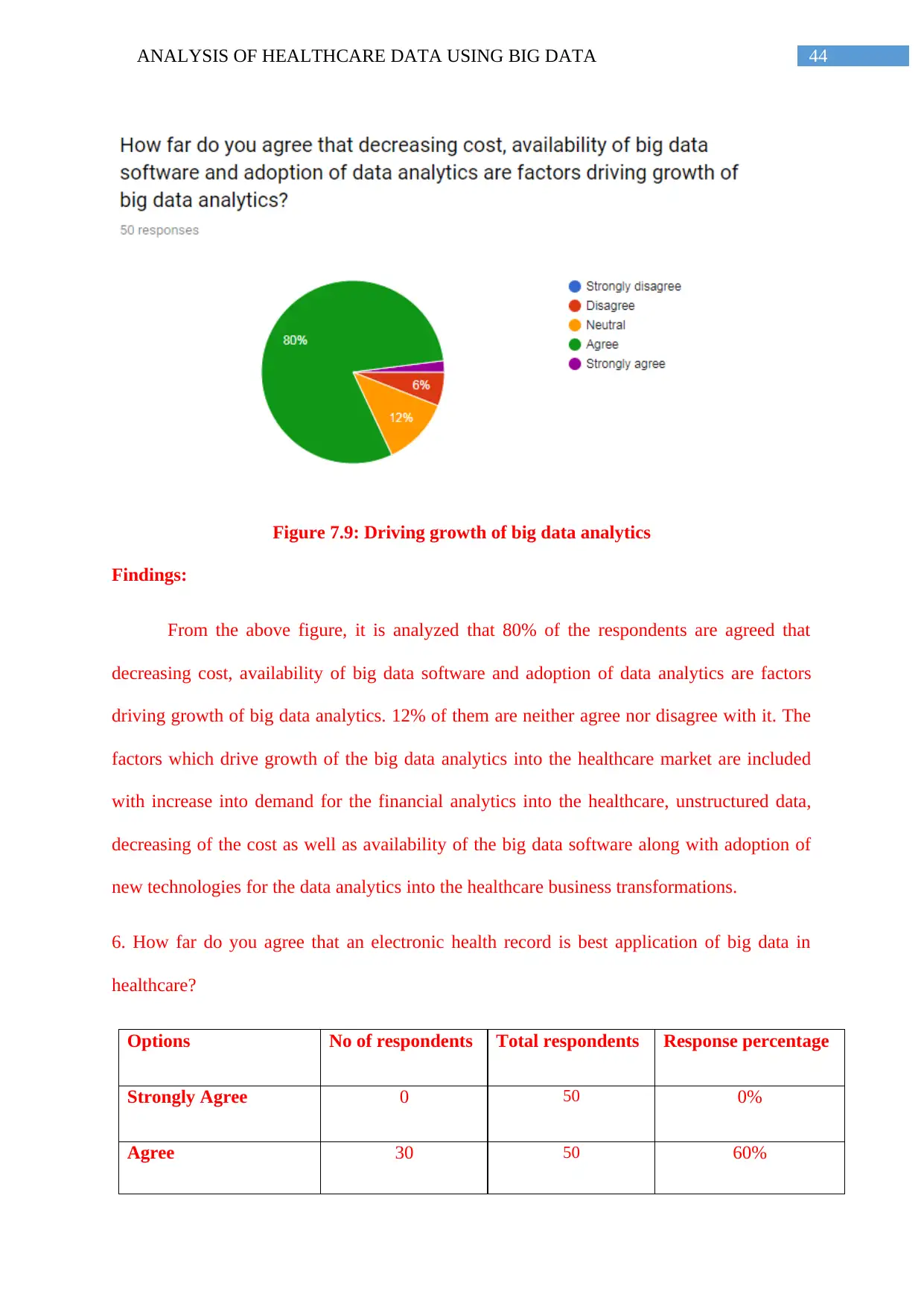
44ANALYSIS OF HEALTHCARE DATA USING BIG DATA
Figure 7.9: Driving growth of big data analytics
Findings:
From the above figure, it is analyzed that 80% of the respondents are agreed that
decreasing cost, availability of big data software and adoption of data analytics are factors
driving growth of big data analytics. 12% of them are neither agree nor disagree with it. The
factors which drive growth of the big data analytics into the healthcare market are included
with increase into demand for the financial analytics into the healthcare, unstructured data,
decreasing of the cost as well as availability of the big data software along with adoption of
new technologies for the data analytics into the healthcare business transformations.
6. How far do you agree that an electronic health record is best application of big data in
healthcare?
Options No of respondents Total respondents Response percentage
Strongly Agree 0 50 0%
Agree 30 50 60%
Figure 7.9: Driving growth of big data analytics
Findings:
From the above figure, it is analyzed that 80% of the respondents are agreed that
decreasing cost, availability of big data software and adoption of data analytics are factors
driving growth of big data analytics. 12% of them are neither agree nor disagree with it. The
factors which drive growth of the big data analytics into the healthcare market are included
with increase into demand for the financial analytics into the healthcare, unstructured data,
decreasing of the cost as well as availability of the big data software along with adoption of
new technologies for the data analytics into the healthcare business transformations.
6. How far do you agree that an electronic health record is best application of big data in
healthcare?
Options No of respondents Total respondents Response percentage
Strongly Agree 0 50 0%
Agree 30 50 60%
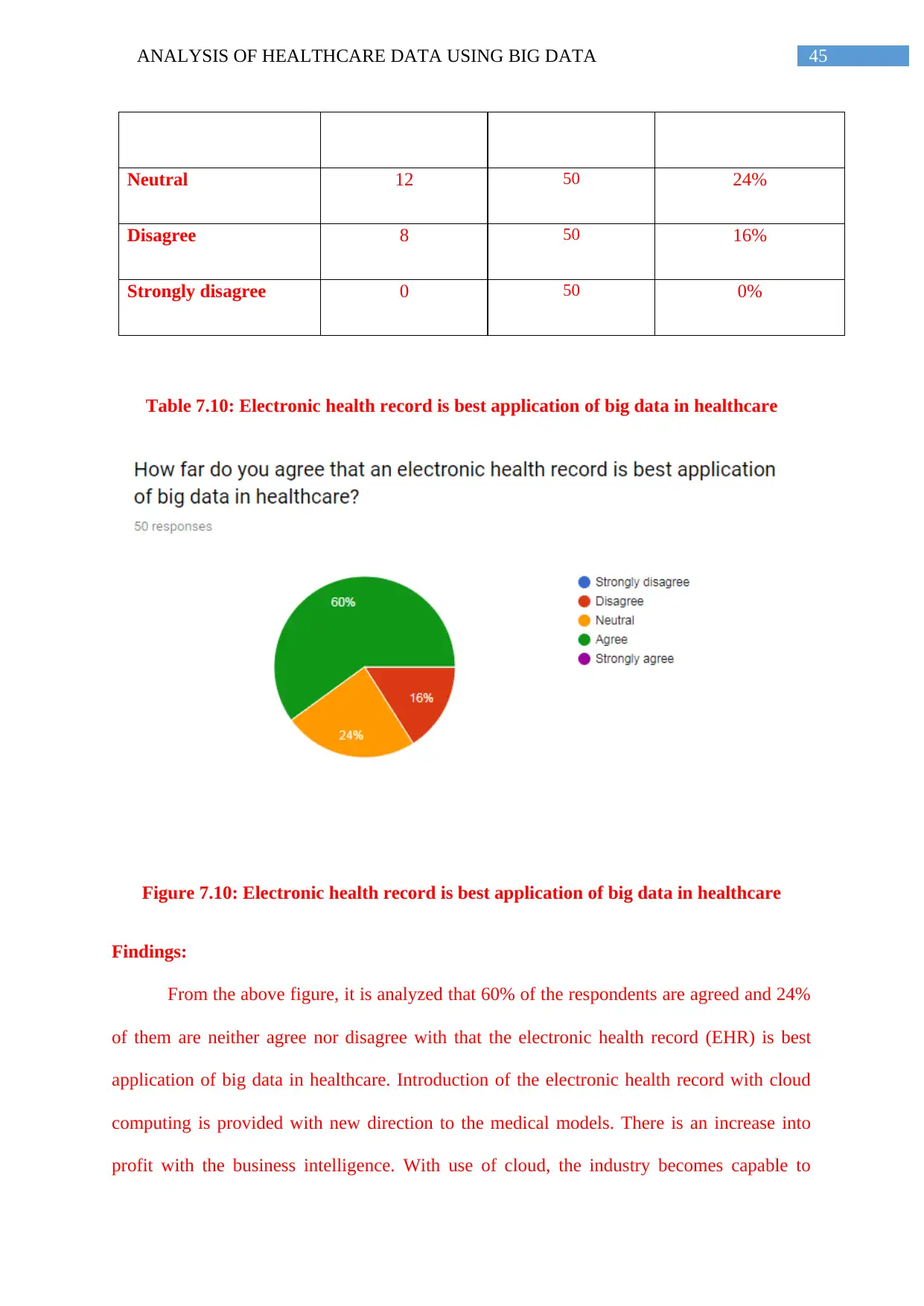
45ANALYSIS OF HEALTHCARE DATA USING BIG DATA
Neutral 12 50 24%
Disagree 8 50 16%
Strongly disagree 0 50 0%
Table 7.10: Electronic health record is best application of big data in healthcare
Figure 7.10: Electronic health record is best application of big data in healthcare
Findings:
From the above figure, it is analyzed that 60% of the respondents are agreed and 24%
of them are neither agree nor disagree with that the electronic health record (EHR) is best
application of big data in healthcare. Introduction of the electronic health record with cloud
computing is provided with new direction to the medical models. There is an increase into
profit with the business intelligence. With use of cloud, the industry becomes capable to
Neutral 12 50 24%
Disagree 8 50 16%
Strongly disagree 0 50 0%
Table 7.10: Electronic health record is best application of big data in healthcare
Figure 7.10: Electronic health record is best application of big data in healthcare
Findings:
From the above figure, it is analyzed that 60% of the respondents are agreed and 24%
of them are neither agree nor disagree with that the electronic health record (EHR) is best
application of big data in healthcare. Introduction of the electronic health record with cloud
computing is provided with new direction to the medical models. There is an increase into
profit with the business intelligence. With use of cloud, the industry becomes capable to
Secure Best Marks with AI Grader
Need help grading? Try our AI Grader for instant feedback on your assignments.
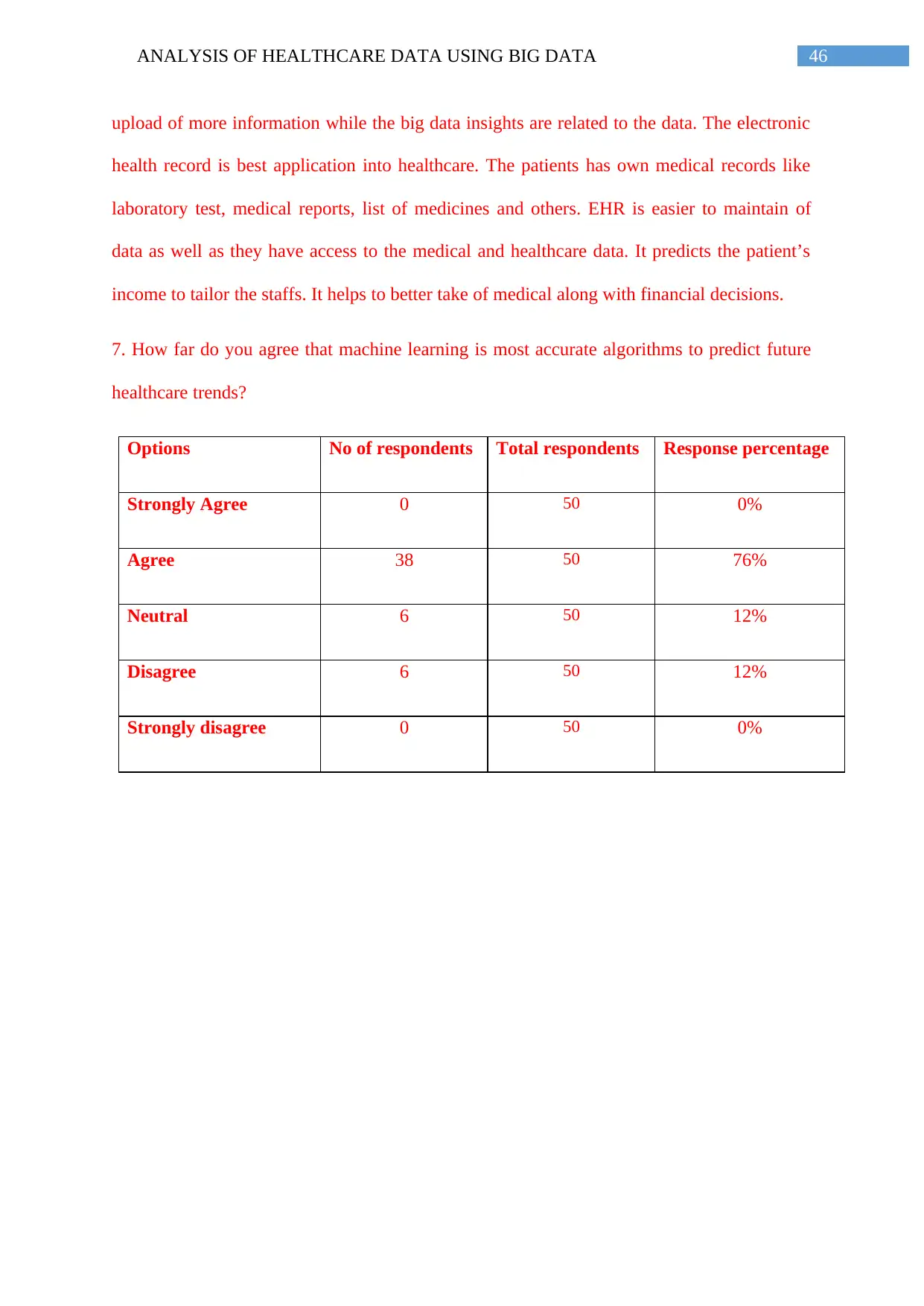
46ANALYSIS OF HEALTHCARE DATA USING BIG DATA
upload of more information while the big data insights are related to the data. The electronic
health record is best application into healthcare. The patients has own medical records like
laboratory test, medical reports, list of medicines and others. EHR is easier to maintain of
data as well as they have access to the medical and healthcare data. It predicts the patient’s
income to tailor the staffs. It helps to better take of medical along with financial decisions.
7. How far do you agree that machine learning is most accurate algorithms to predict future
healthcare trends?
Options No of respondents Total respondents Response percentage
Strongly Agree 0 50 0%
Agree 38 50 76%
Neutral 6 50 12%
Disagree 6 50 12%
Strongly disagree 0 50 0%
upload of more information while the big data insights are related to the data. The electronic
health record is best application into healthcare. The patients has own medical records like
laboratory test, medical reports, list of medicines and others. EHR is easier to maintain of
data as well as they have access to the medical and healthcare data. It predicts the patient’s
income to tailor the staffs. It helps to better take of medical along with financial decisions.
7. How far do you agree that machine learning is most accurate algorithms to predict future
healthcare trends?
Options No of respondents Total respondents Response percentage
Strongly Agree 0 50 0%
Agree 38 50 76%
Neutral 6 50 12%
Disagree 6 50 12%
Strongly disagree 0 50 0%
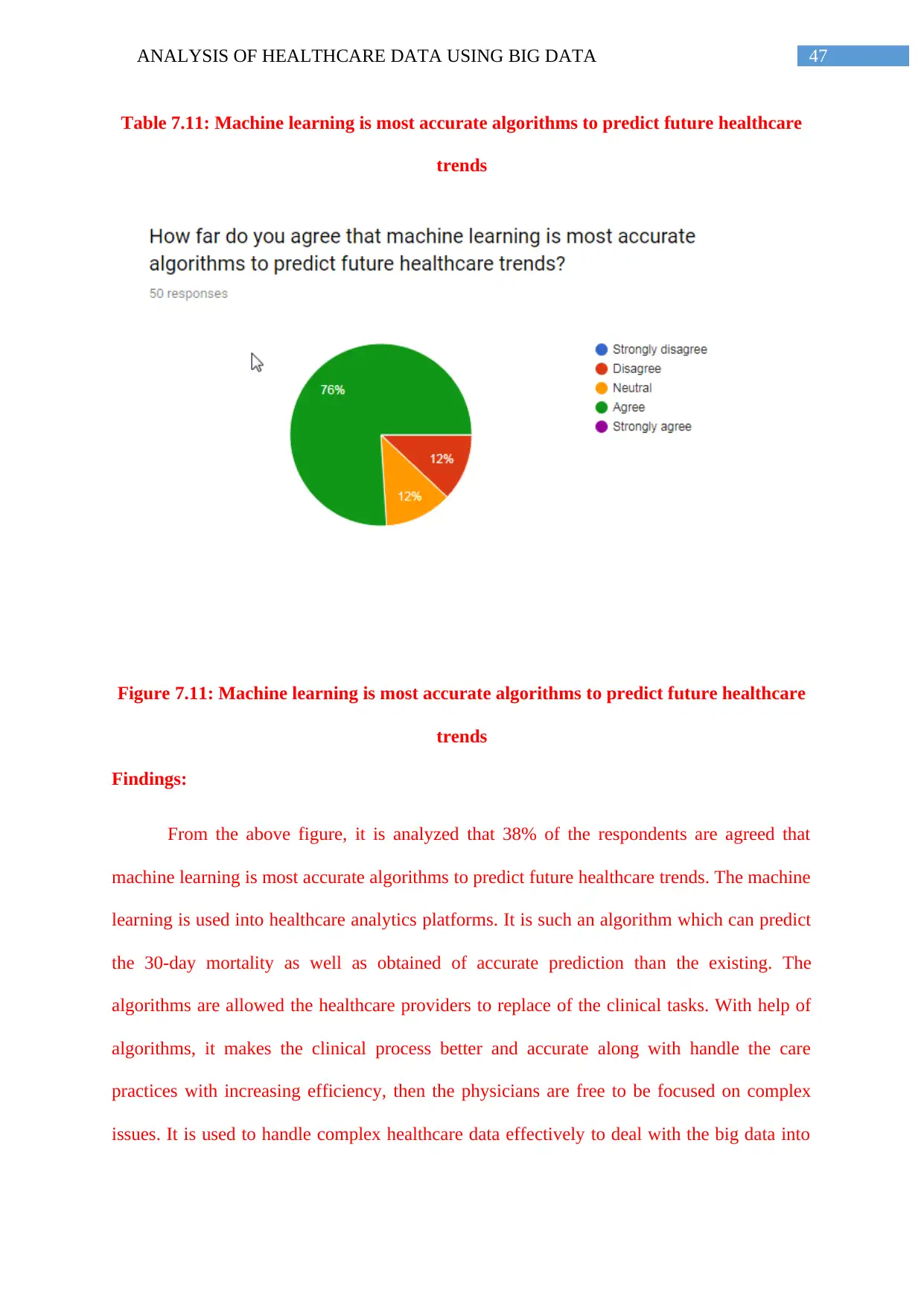
47ANALYSIS OF HEALTHCARE DATA USING BIG DATA
Table 7.11: Machine learning is most accurate algorithms to predict future healthcare
trends
Figure 7.11: Machine learning is most accurate algorithms to predict future healthcare
trends
Findings:
From the above figure, it is analyzed that 38% of the respondents are agreed that
machine learning is most accurate algorithms to predict future healthcare trends. The machine
learning is used into healthcare analytics platforms. It is such an algorithm which can predict
the 30-day mortality as well as obtained of accurate prediction than the existing. The
algorithms are allowed the healthcare providers to replace of the clinical tasks. With help of
algorithms, it makes the clinical process better and accurate along with handle the care
practices with increasing efficiency, then the physicians are free to be focused on complex
issues. It is used to handle complex healthcare data effectively to deal with the big data into
Table 7.11: Machine learning is most accurate algorithms to predict future healthcare
trends
Figure 7.11: Machine learning is most accurate algorithms to predict future healthcare
trends
Findings:
From the above figure, it is analyzed that 38% of the respondents are agreed that
machine learning is most accurate algorithms to predict future healthcare trends. The machine
learning is used into healthcare analytics platforms. It is such an algorithm which can predict
the 30-day mortality as well as obtained of accurate prediction than the existing. The
algorithms are allowed the healthcare providers to replace of the clinical tasks. With help of
algorithms, it makes the clinical process better and accurate along with handle the care
practices with increasing efficiency, then the physicians are free to be focused on complex
issues. It is used to handle complex healthcare data effectively to deal with the big data into
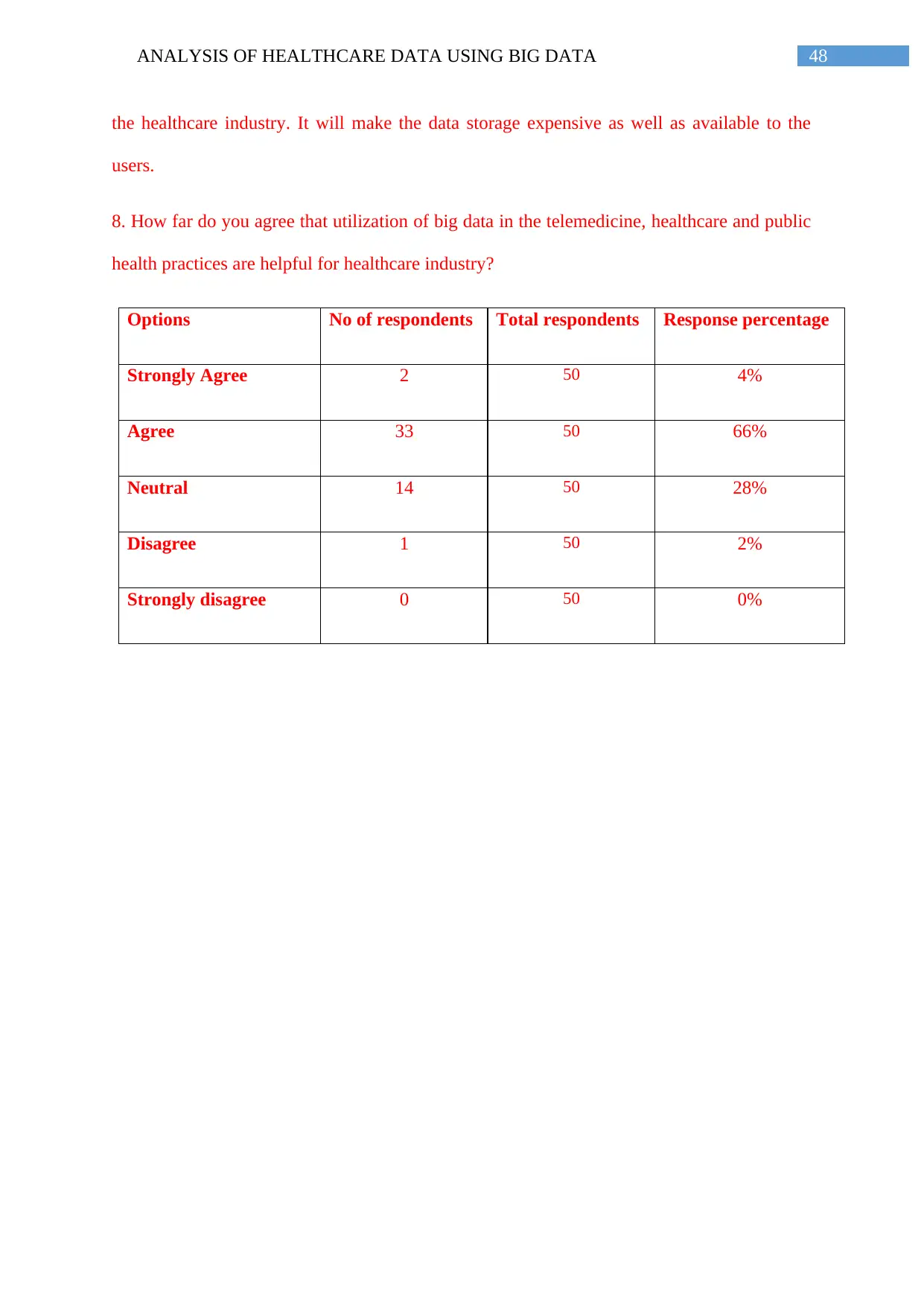
48ANALYSIS OF HEALTHCARE DATA USING BIG DATA
the healthcare industry. It will make the data storage expensive as well as available to the
users.
8. How far do you agree that utilization of big data in the telemedicine, healthcare and public
health practices are helpful for healthcare industry?
Options No of respondents Total respondents Response percentage
Strongly Agree 2 50 4%
Agree 33 50 66%
Neutral 14 50 28%
Disagree 1 50 2%
Strongly disagree 0 50 0%
the healthcare industry. It will make the data storage expensive as well as available to the
users.
8. How far do you agree that utilization of big data in the telemedicine, healthcare and public
health practices are helpful for healthcare industry?
Options No of respondents Total respondents Response percentage
Strongly Agree 2 50 4%
Agree 33 50 66%
Neutral 14 50 28%
Disagree 1 50 2%
Strongly disagree 0 50 0%
Paraphrase This Document
Need a fresh take? Get an instant paraphrase of this document with our AI Paraphraser
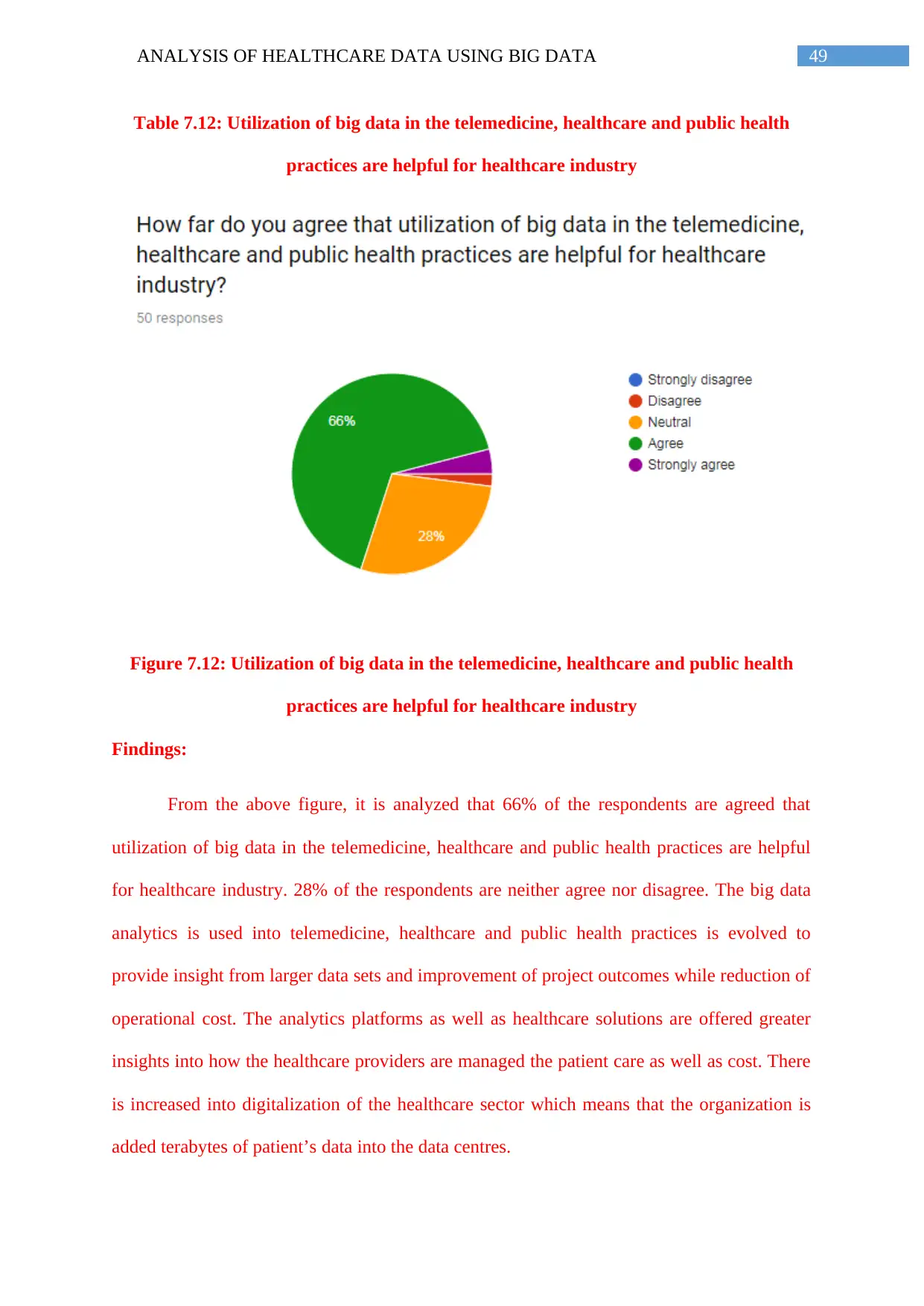
49ANALYSIS OF HEALTHCARE DATA USING BIG DATA
Table 7.12: Utilization of big data in the telemedicine, healthcare and public health
practices are helpful for healthcare industry
Figure 7.12: Utilization of big data in the telemedicine, healthcare and public health
practices are helpful for healthcare industry
Findings:
From the above figure, it is analyzed that 66% of the respondents are agreed that
utilization of big data in the telemedicine, healthcare and public health practices are helpful
for healthcare industry. 28% of the respondents are neither agree nor disagree. The big data
analytics is used into telemedicine, healthcare and public health practices is evolved to
provide insight from larger data sets and improvement of project outcomes while reduction of
operational cost. The analytics platforms as well as healthcare solutions are offered greater
insights into how the healthcare providers are managed the patient care as well as cost. There
is increased into digitalization of the healthcare sector which means that the organization is
added terabytes of patient’s data into the data centres.
Table 7.12: Utilization of big data in the telemedicine, healthcare and public health
practices are helpful for healthcare industry
Figure 7.12: Utilization of big data in the telemedicine, healthcare and public health
practices are helpful for healthcare industry
Findings:
From the above figure, it is analyzed that 66% of the respondents are agreed that
utilization of big data in the telemedicine, healthcare and public health practices are helpful
for healthcare industry. 28% of the respondents are neither agree nor disagree. The big data
analytics is used into telemedicine, healthcare and public health practices is evolved to
provide insight from larger data sets and improvement of project outcomes while reduction of
operational cost. The analytics platforms as well as healthcare solutions are offered greater
insights into how the healthcare providers are managed the patient care as well as cost. There
is increased into digitalization of the healthcare sector which means that the organization is
added terabytes of patient’s data into the data centres.
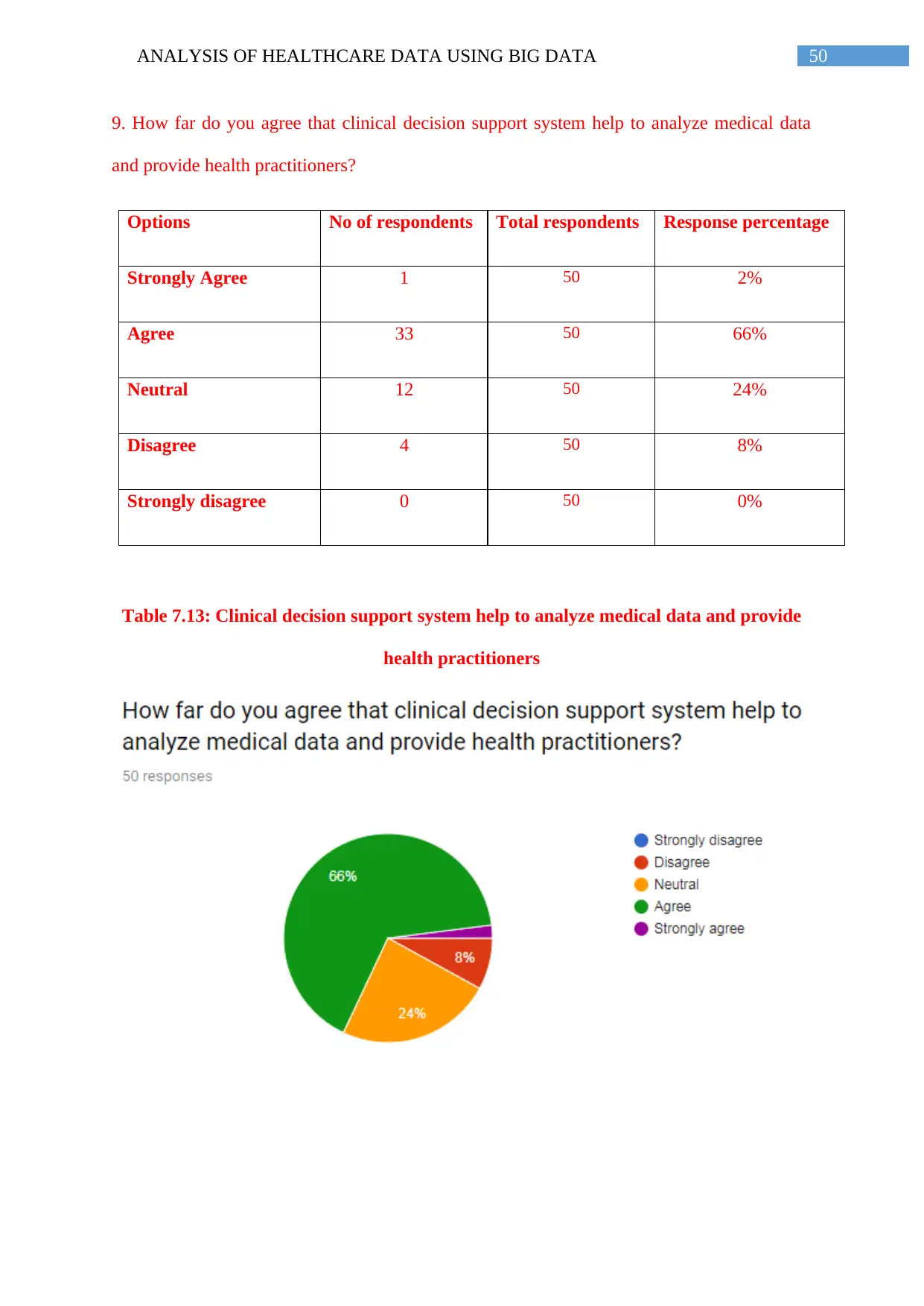
50ANALYSIS OF HEALTHCARE DATA USING BIG DATA
9. How far do you agree that clinical decision support system help to analyze medical data
and provide health practitioners?
Options No of respondents Total respondents Response percentage
Strongly Agree 1 50 2%
Agree 33 50 66%
Neutral 12 50 24%
Disagree 4 50 8%
Strongly disagree 0 50 0%
Table 7.13: Clinical decision support system help to analyze medical data and provide
health practitioners
9. How far do you agree that clinical decision support system help to analyze medical data
and provide health practitioners?
Options No of respondents Total respondents Response percentage
Strongly Agree 1 50 2%
Agree 33 50 66%
Neutral 12 50 24%
Disagree 4 50 8%
Strongly disagree 0 50 0%
Table 7.13: Clinical decision support system help to analyze medical data and provide
health practitioners
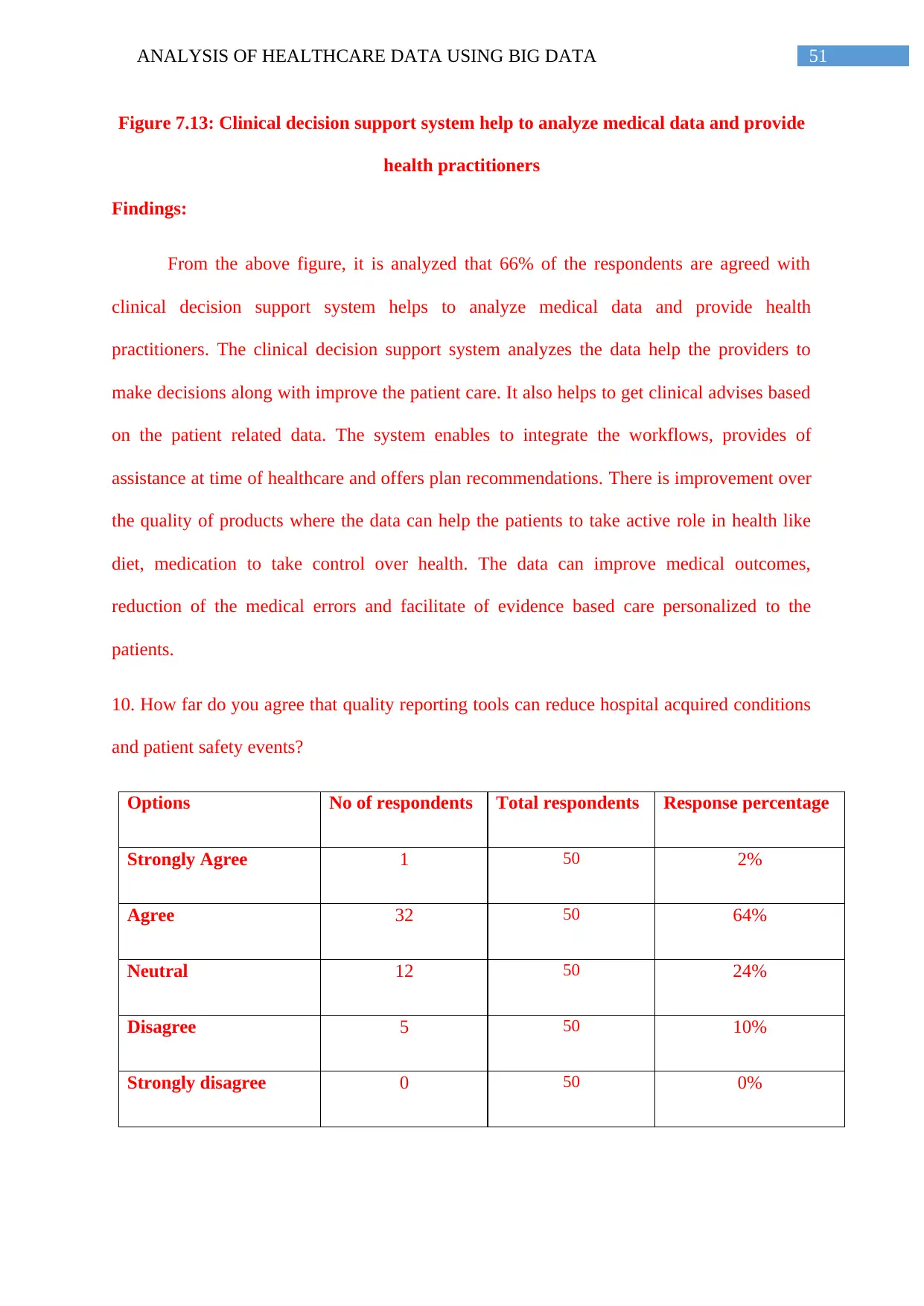
51ANALYSIS OF HEALTHCARE DATA USING BIG DATA
Figure 7.13: Clinical decision support system help to analyze medical data and provide
health practitioners
Findings:
From the above figure, it is analyzed that 66% of the respondents are agreed with
clinical decision support system helps to analyze medical data and provide health
practitioners. The clinical decision support system analyzes the data help the providers to
make decisions along with improve the patient care. It also helps to get clinical advises based
on the patient related data. The system enables to integrate the workflows, provides of
assistance at time of healthcare and offers plan recommendations. There is improvement over
the quality of products where the data can help the patients to take active role in health like
diet, medication to take control over health. The data can improve medical outcomes,
reduction of the medical errors and facilitate of evidence based care personalized to the
patients.
10. How far do you agree that quality reporting tools can reduce hospital acquired conditions
and patient safety events?
Options No of respondents Total respondents Response percentage
Strongly Agree 1 50 2%
Agree 32 50 64%
Neutral 12 50 24%
Disagree 5 50 10%
Strongly disagree 0 50 0%
Figure 7.13: Clinical decision support system help to analyze medical data and provide
health practitioners
Findings:
From the above figure, it is analyzed that 66% of the respondents are agreed with
clinical decision support system helps to analyze medical data and provide health
practitioners. The clinical decision support system analyzes the data help the providers to
make decisions along with improve the patient care. It also helps to get clinical advises based
on the patient related data. The system enables to integrate the workflows, provides of
assistance at time of healthcare and offers plan recommendations. There is improvement over
the quality of products where the data can help the patients to take active role in health like
diet, medication to take control over health. The data can improve medical outcomes,
reduction of the medical errors and facilitate of evidence based care personalized to the
patients.
10. How far do you agree that quality reporting tools can reduce hospital acquired conditions
and patient safety events?
Options No of respondents Total respondents Response percentage
Strongly Agree 1 50 2%
Agree 32 50 64%
Neutral 12 50 24%
Disagree 5 50 10%
Strongly disagree 0 50 0%
Secure Best Marks with AI Grader
Need help grading? Try our AI Grader for instant feedback on your assignments.
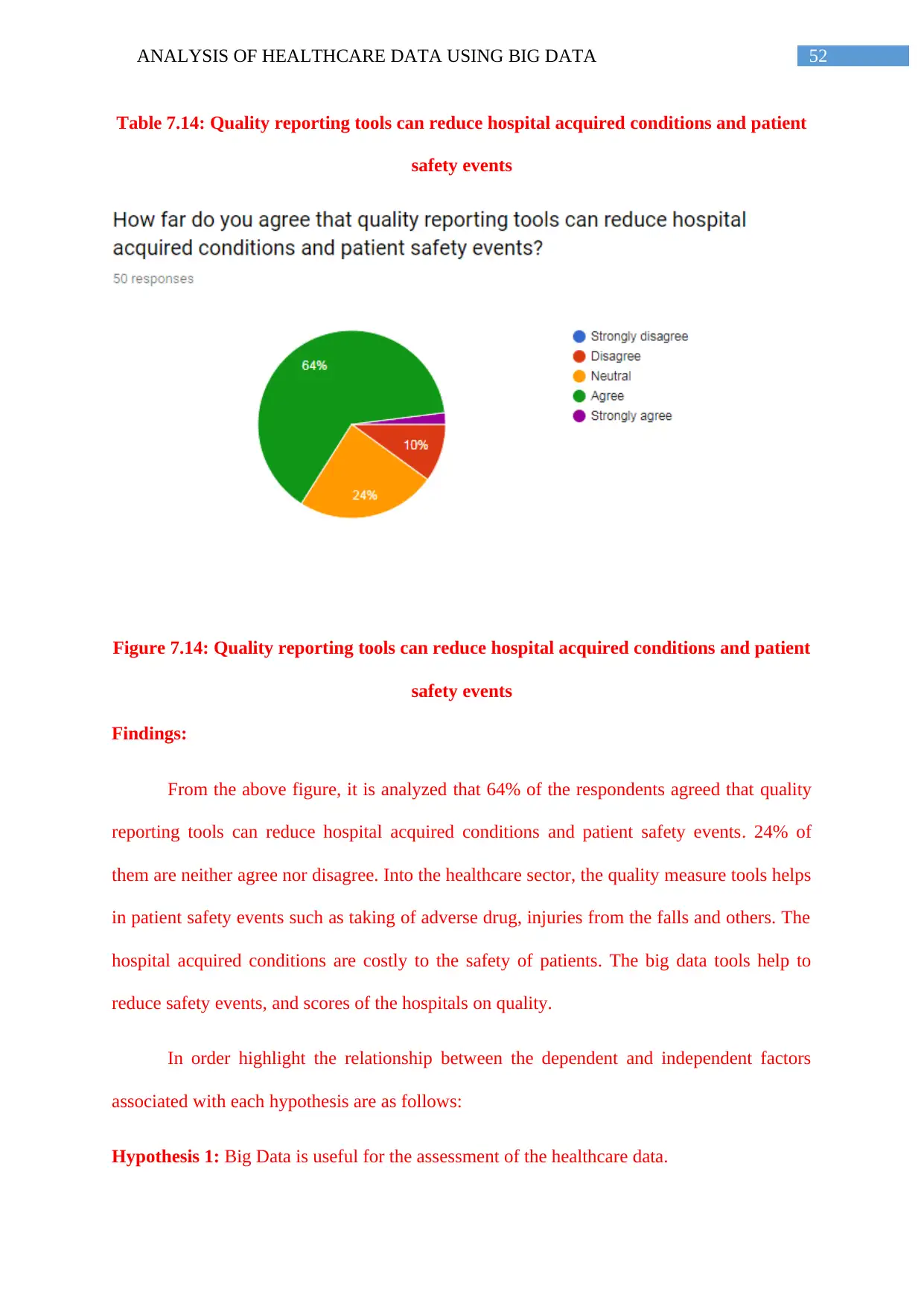
52ANALYSIS OF HEALTHCARE DATA USING BIG DATA
Table 7.14: Quality reporting tools can reduce hospital acquired conditions and patient
safety events
Figure 7.14: Quality reporting tools can reduce hospital acquired conditions and patient
safety events
Findings:
From the above figure, it is analyzed that 64% of the respondents agreed that quality
reporting tools can reduce hospital acquired conditions and patient safety events. 24% of
them are neither agree nor disagree. Into the healthcare sector, the quality measure tools helps
in patient safety events such as taking of adverse drug, injuries from the falls and others. The
hospital acquired conditions are costly to the safety of patients. The big data tools help to
reduce safety events, and scores of the hospitals on quality.
In order highlight the relationship between the dependent and independent factors
associated with each hypothesis are as follows:
Hypothesis 1: Big Data is useful for the assessment of the healthcare data.
Table 7.14: Quality reporting tools can reduce hospital acquired conditions and patient
safety events
Figure 7.14: Quality reporting tools can reduce hospital acquired conditions and patient
safety events
Findings:
From the above figure, it is analyzed that 64% of the respondents agreed that quality
reporting tools can reduce hospital acquired conditions and patient safety events. 24% of
them are neither agree nor disagree. Into the healthcare sector, the quality measure tools helps
in patient safety events such as taking of adverse drug, injuries from the falls and others. The
hospital acquired conditions are costly to the safety of patients. The big data tools help to
reduce safety events, and scores of the hospitals on quality.
In order highlight the relationship between the dependent and independent factors
associated with each hypothesis are as follows:
Hypothesis 1: Big Data is useful for the assessment of the healthcare data.
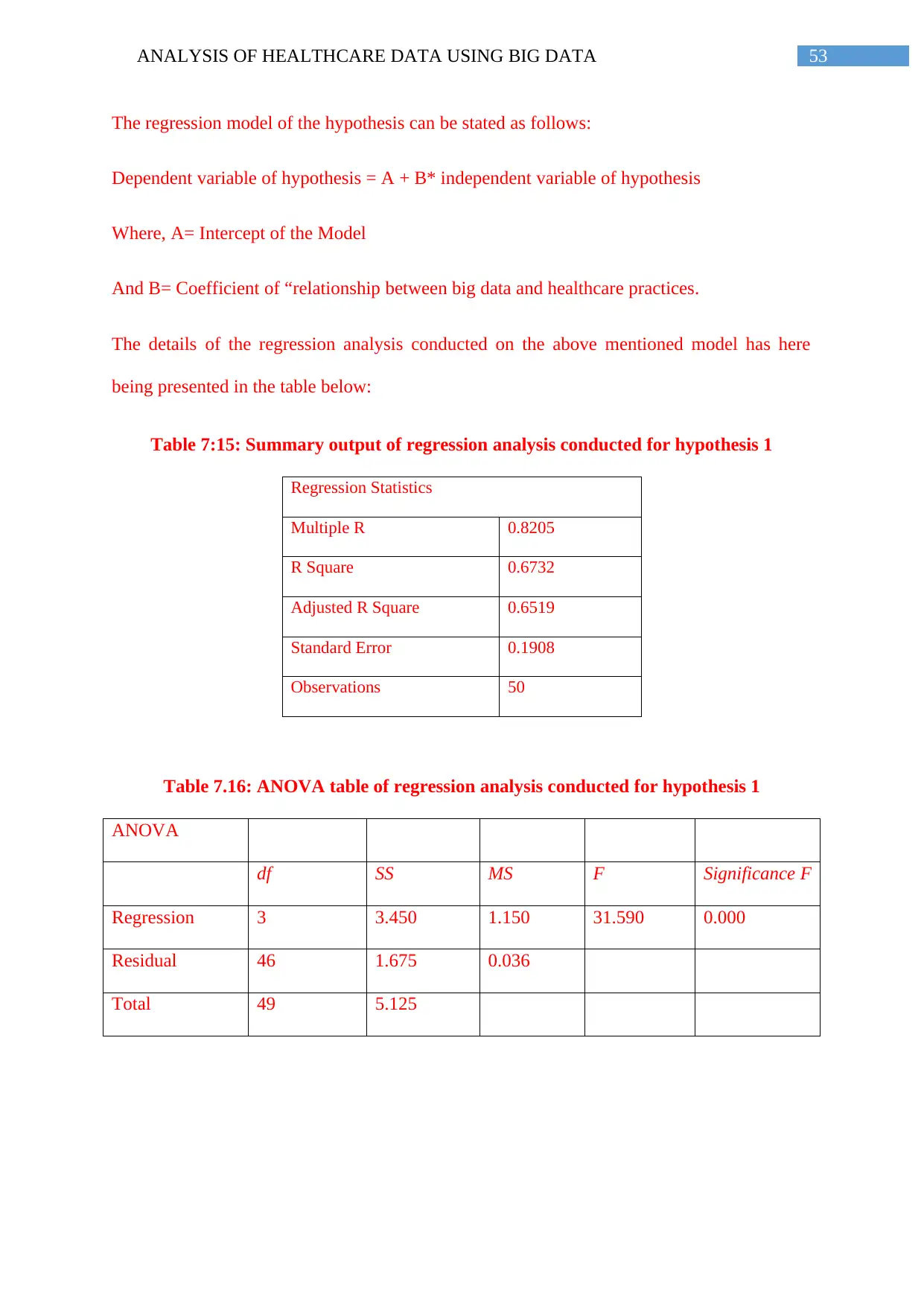
53ANALYSIS OF HEALTHCARE DATA USING BIG DATA
The regression model of the hypothesis can be stated as follows:
Dependent variable of hypothesis = A + B* independent variable of hypothesis
Where, A= Intercept of the Model
And B= Coefficient of “relationship between big data and healthcare practices.
The details of the regression analysis conducted on the above mentioned model has here
being presented in the table below:
Table 7:15: Summary output of regression analysis conducted for hypothesis 1
Regression Statistics
Multiple R 0.8205
R Square 0.6732
Adjusted R Square 0.6519
Standard Error 0.1908
Observations 50
Table 7.16: ANOVA table of regression analysis conducted for hypothesis 1
ANOVA
df SS MS F Significance F
Regression 3 3.450 1.150 31.590 0.000
Residual 46 1.675 0.036
Total 49 5.125
The regression model of the hypothesis can be stated as follows:
Dependent variable of hypothesis = A + B* independent variable of hypothesis
Where, A= Intercept of the Model
And B= Coefficient of “relationship between big data and healthcare practices.
The details of the regression analysis conducted on the above mentioned model has here
being presented in the table below:
Table 7:15: Summary output of regression analysis conducted for hypothesis 1
Regression Statistics
Multiple R 0.8205
R Square 0.6732
Adjusted R Square 0.6519
Standard Error 0.1908
Observations 50
Table 7.16: ANOVA table of regression analysis conducted for hypothesis 1
ANOVA
df SS MS F Significance F
Regression 3 3.450 1.150 31.590 0.000
Residual 46 1.675 0.036
Total 49 5.125
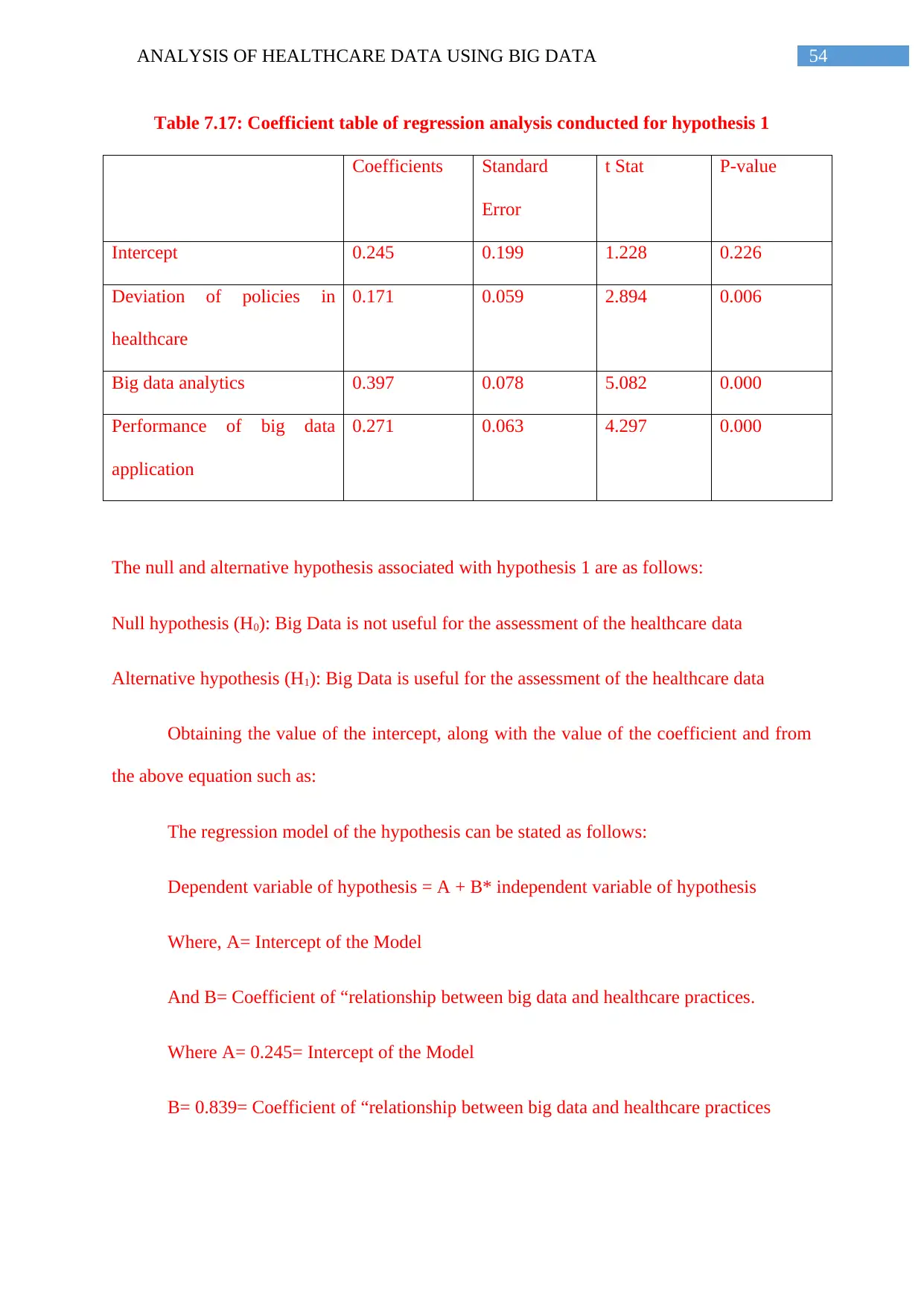
54ANALYSIS OF HEALTHCARE DATA USING BIG DATA
Table 7.17: Coefficient table of regression analysis conducted for hypothesis 1
Coefficients Standard
Error
t Stat P-value
Intercept 0.245 0.199 1.228 0.226
Deviation of policies in
healthcare
0.171 0.059 2.894 0.006
Big data analytics 0.397 0.078 5.082 0.000
Performance of big data
application
0.271 0.063 4.297 0.000
The null and alternative hypothesis associated with hypothesis 1 are as follows:
Null hypothesis (H0): Big Data is not useful for the assessment of the healthcare data
Alternative hypothesis (H1): Big Data is useful for the assessment of the healthcare data
Obtaining the value of the intercept, along with the value of the coefficient and from
the above equation such as:
The regression model of the hypothesis can be stated as follows:
Dependent variable of hypothesis = A + B* independent variable of hypothesis
Where, A= Intercept of the Model
And B= Coefficient of “relationship between big data and healthcare practices.
Where A= 0.245= Intercept of the Model
B= 0.839= Coefficient of “relationship between big data and healthcare practices
Table 7.17: Coefficient table of regression analysis conducted for hypothesis 1
Coefficients Standard
Error
t Stat P-value
Intercept 0.245 0.199 1.228 0.226
Deviation of policies in
healthcare
0.171 0.059 2.894 0.006
Big data analytics 0.397 0.078 5.082 0.000
Performance of big data
application
0.271 0.063 4.297 0.000
The null and alternative hypothesis associated with hypothesis 1 are as follows:
Null hypothesis (H0): Big Data is not useful for the assessment of the healthcare data
Alternative hypothesis (H1): Big Data is useful for the assessment of the healthcare data
Obtaining the value of the intercept, along with the value of the coefficient and from
the above equation such as:
The regression model of the hypothesis can be stated as follows:
Dependent variable of hypothesis = A + B* independent variable of hypothesis
Where, A= Intercept of the Model
And B= Coefficient of “relationship between big data and healthcare practices.
Where A= 0.245= Intercept of the Model
B= 0.839= Coefficient of “relationship between big data and healthcare practices
Paraphrase This Document
Need a fresh take? Get an instant paraphrase of this document with our AI Paraphraser
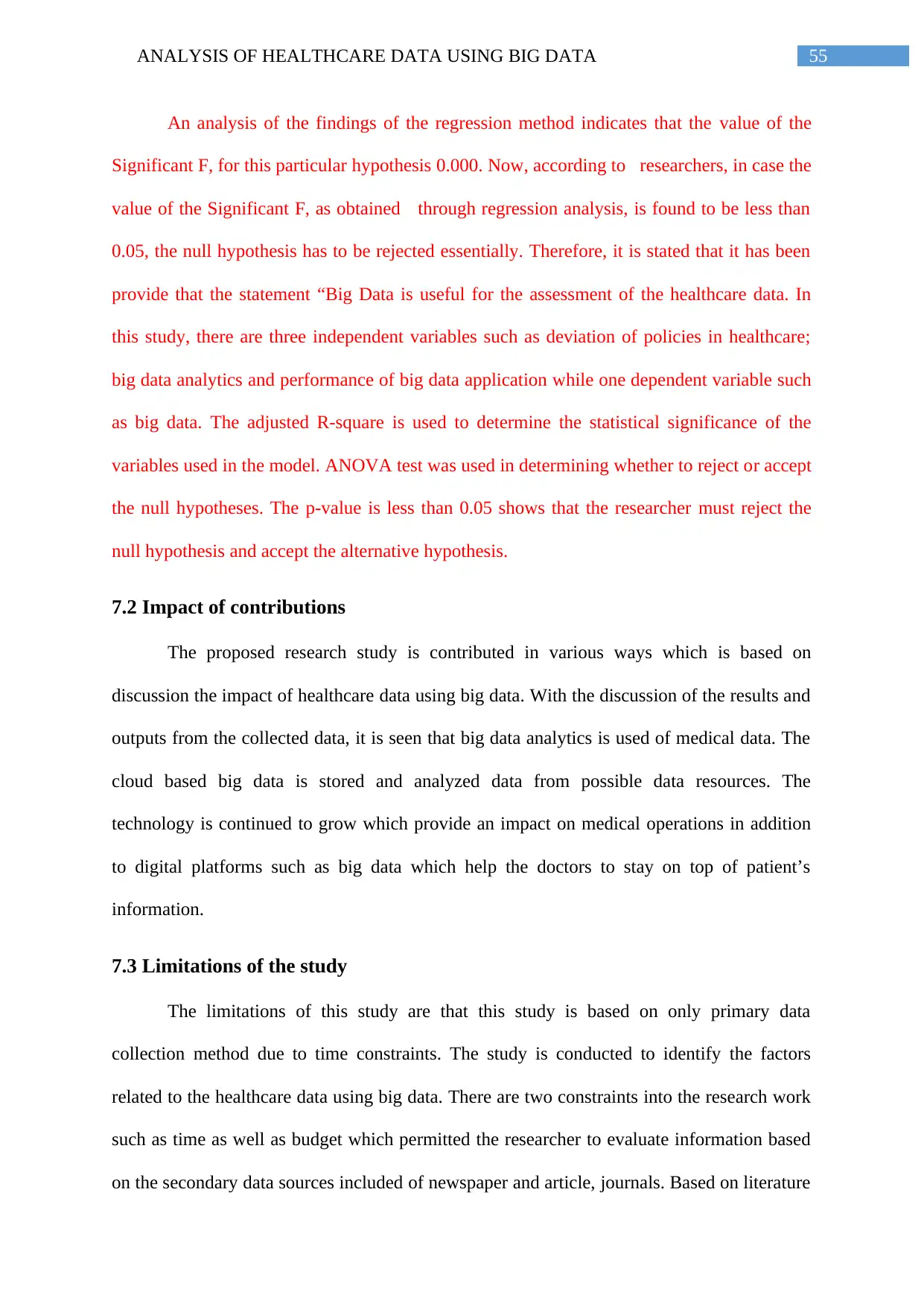
55ANALYSIS OF HEALTHCARE DATA USING BIG DATA
An analysis of the findings of the regression method indicates that the value of the
Significant F, for this particular hypothesis 0.000. Now, according to researchers, in case the
value of the Significant F, as obtained through regression analysis, is found to be less than
0.05, the null hypothesis has to be rejected essentially. Therefore, it is stated that it has been
provide that the statement “Big Data is useful for the assessment of the healthcare data. In
this study, there are three independent variables such as deviation of policies in healthcare;
big data analytics and performance of big data application while one dependent variable such
as big data. The adjusted R-square is used to determine the statistical significance of the
variables used in the model. ANOVA test was used in determining whether to reject or accept
the null hypotheses. The p-value is less than 0.05 shows that the researcher must reject the
null hypothesis and accept the alternative hypothesis.
7.2 Impact of contributions
The proposed research study is contributed in various ways which is based on
discussion the impact of healthcare data using big data. With the discussion of the results and
outputs from the collected data, it is seen that big data analytics is used of medical data. The
cloud based big data is stored and analyzed data from possible data resources. The
technology is continued to grow which provide an impact on medical operations in addition
to digital platforms such as big data which help the doctors to stay on top of patient’s
information.
7.3 Limitations of the study
The limitations of this study are that this study is based on only primary data
collection method due to time constraints. The study is conducted to identify the factors
related to the healthcare data using big data. There are two constraints into the research work
such as time as well as budget which permitted the researcher to evaluate information based
on the secondary data sources included of newspaper and article, journals. Based on literature
An analysis of the findings of the regression method indicates that the value of the
Significant F, for this particular hypothesis 0.000. Now, according to researchers, in case the
value of the Significant F, as obtained through regression analysis, is found to be less than
0.05, the null hypothesis has to be rejected essentially. Therefore, it is stated that it has been
provide that the statement “Big Data is useful for the assessment of the healthcare data. In
this study, there are three independent variables such as deviation of policies in healthcare;
big data analytics and performance of big data application while one dependent variable such
as big data. The adjusted R-square is used to determine the statistical significance of the
variables used in the model. ANOVA test was used in determining whether to reject or accept
the null hypotheses. The p-value is less than 0.05 shows that the researcher must reject the
null hypothesis and accept the alternative hypothesis.
7.2 Impact of contributions
The proposed research study is contributed in various ways which is based on
discussion the impact of healthcare data using big data. With the discussion of the results and
outputs from the collected data, it is seen that big data analytics is used of medical data. The
cloud based big data is stored and analyzed data from possible data resources. The
technology is continued to grow which provide an impact on medical operations in addition
to digital platforms such as big data which help the doctors to stay on top of patient’s
information.
7.3 Limitations of the study
The limitations of this study are that this study is based on only primary data
collection method due to time constraints. The study is conducted to identify the factors
related to the healthcare data using big data. There are two constraints into the research work
such as time as well as budget which permitted the researcher to evaluate information based
on the secondary data sources included of newspaper and article, journals. Based on literature

56ANALYSIS OF HEALTHCARE DATA USING BIG DATA
review as well as secondary sources, the researcher has analyzed that SPSS analysis is
eliminated into the study.
review as well as secondary sources, the researcher has analyzed that SPSS analysis is
eliminated into the study.
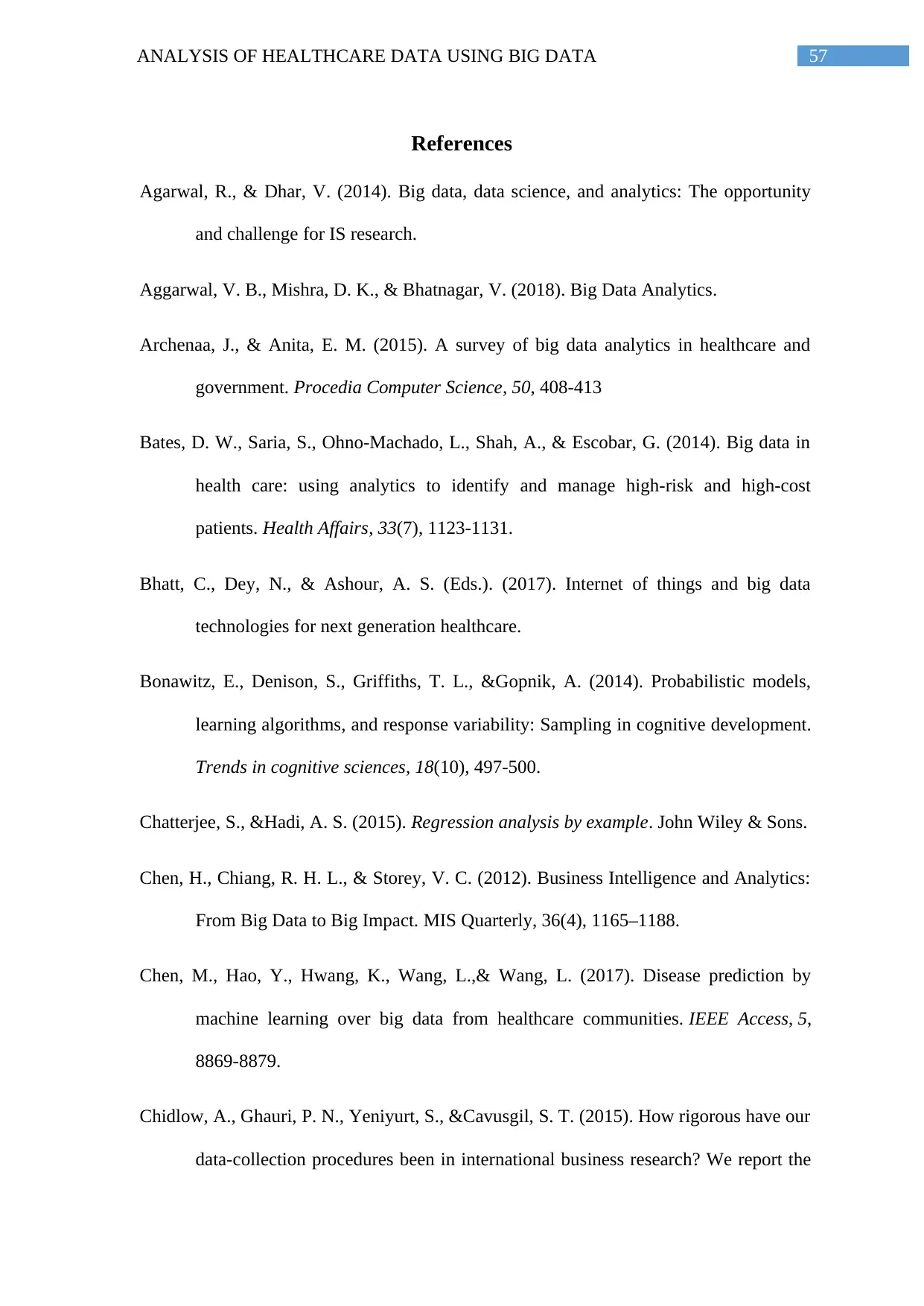
57ANALYSIS OF HEALTHCARE DATA USING BIG DATA
References
Agarwal, R., & Dhar, V. (2014). Big data, data science, and analytics: The opportunity
and challenge for IS research.
Aggarwal, V. B., Mishra, D. K., & Bhatnagar, V. (2018). Big Data Analytics.
Archenaa, J., & Anita, E. M. (2015). A survey of big data analytics in healthcare and
government. Procedia Computer Science, 50, 408-413
Bates, D. W., Saria, S., Ohno-Machado, L., Shah, A., & Escobar, G. (2014). Big data in
health care: using analytics to identify and manage high-risk and high-cost
patients. Health Affairs, 33(7), 1123-1131.
Bhatt, C., Dey, N., & Ashour, A. S. (Eds.). (2017). Internet of things and big data
technologies for next generation healthcare.
Bonawitz, E., Denison, S., Griffiths, T. L., &Gopnik, A. (2014). Probabilistic models,
learning algorithms, and response variability: Sampling in cognitive development.
Trends in cognitive sciences, 18(10), 497-500.
Chatterjee, S., &Hadi, A. S. (2015). Regression analysis by example. John Wiley & Sons.
Chen, H., Chiang, R. H. L., & Storey, V. C. (2012). Business Intelligence and Analytics:
From Big Data to Big Impact. MIS Quarterly, 36(4), 1165–1188.
Chen, M., Hao, Y., Hwang, K., Wang, L.,& Wang, L. (2017). Disease prediction by
machine learning over big data from healthcare communities. IEEE Access, 5,
8869-8879.
Chidlow, A., Ghauri, P. N., Yeniyurt, S., &Cavusgil, S. T. (2015). How rigorous have our
data-collection procedures been in international business research? We report the
References
Agarwal, R., & Dhar, V. (2014). Big data, data science, and analytics: The opportunity
and challenge for IS research.
Aggarwal, V. B., Mishra, D. K., & Bhatnagar, V. (2018). Big Data Analytics.
Archenaa, J., & Anita, E. M. (2015). A survey of big data analytics in healthcare and
government. Procedia Computer Science, 50, 408-413
Bates, D. W., Saria, S., Ohno-Machado, L., Shah, A., & Escobar, G. (2014). Big data in
health care: using analytics to identify and manage high-risk and high-cost
patients. Health Affairs, 33(7), 1123-1131.
Bhatt, C., Dey, N., & Ashour, A. S. (Eds.). (2017). Internet of things and big data
technologies for next generation healthcare.
Bonawitz, E., Denison, S., Griffiths, T. L., &Gopnik, A. (2014). Probabilistic models,
learning algorithms, and response variability: Sampling in cognitive development.
Trends in cognitive sciences, 18(10), 497-500.
Chatterjee, S., &Hadi, A. S. (2015). Regression analysis by example. John Wiley & Sons.
Chen, H., Chiang, R. H. L., & Storey, V. C. (2012). Business Intelligence and Analytics:
From Big Data to Big Impact. MIS Quarterly, 36(4), 1165–1188.
Chen, M., Hao, Y., Hwang, K., Wang, L.,& Wang, L. (2017). Disease prediction by
machine learning over big data from healthcare communities. IEEE Access, 5,
8869-8879.
Chidlow, A., Ghauri, P. N., Yeniyurt, S., &Cavusgil, S. T. (2015). How rigorous have our
data-collection procedures been in international business research? We report the
Secure Best Marks with AI Grader
Need help grading? Try our AI Grader for instant feedback on your assignments.
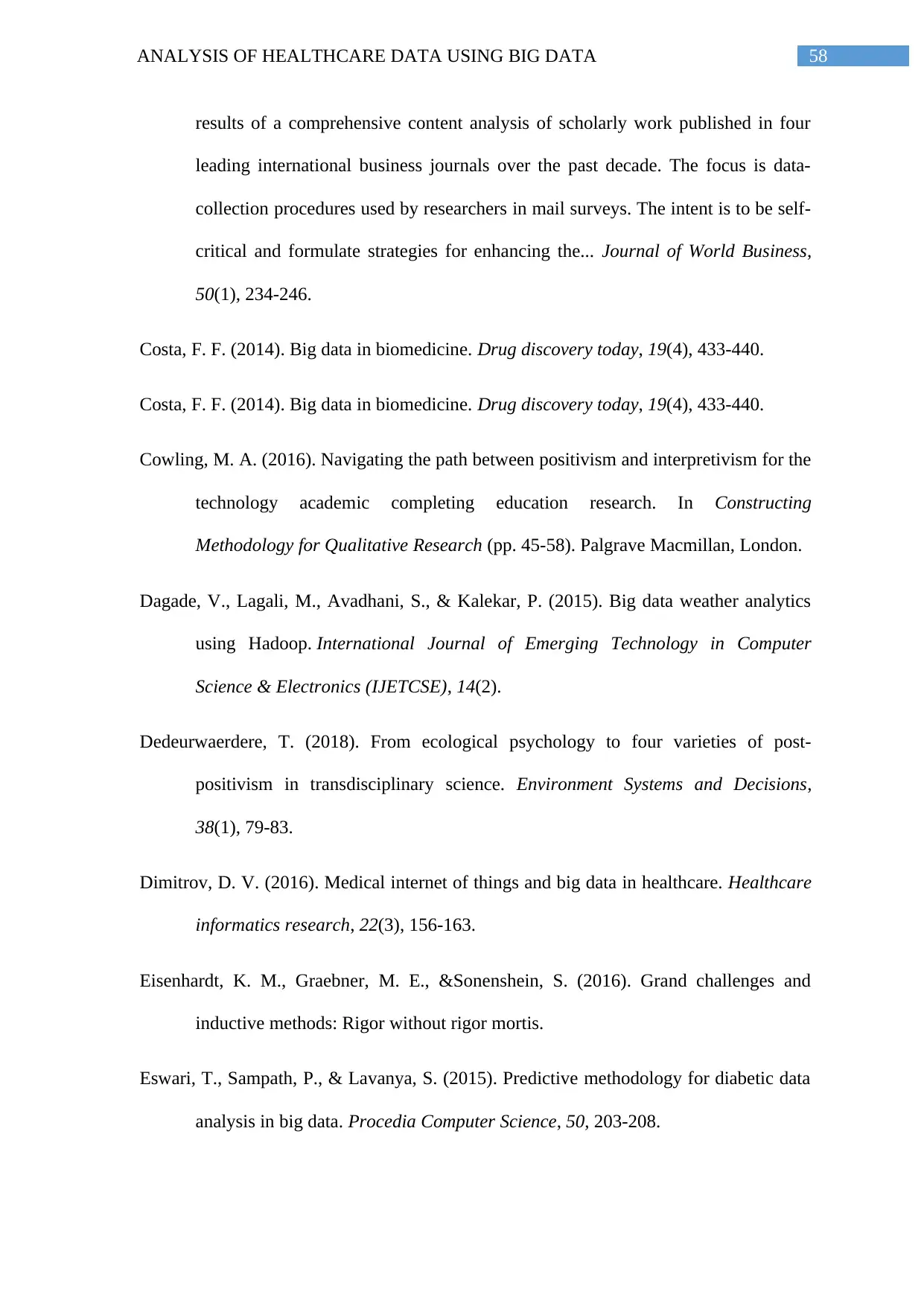
58ANALYSIS OF HEALTHCARE DATA USING BIG DATA
results of a comprehensive content analysis of scholarly work published in four
leading international business journals over the past decade. The focus is data-
collection procedures used by researchers in mail surveys. The intent is to be self-
critical and formulate strategies for enhancing the... Journal of World Business,
50(1), 234-246.
Costa, F. F. (2014). Big data in biomedicine. Drug discovery today, 19(4), 433-440.
Costa, F. F. (2014). Big data in biomedicine. Drug discovery today, 19(4), 433-440.
Cowling, M. A. (2016). Navigating the path between positivism and interpretivism for the
technology academic completing education research. In Constructing
Methodology for Qualitative Research (pp. 45-58). Palgrave Macmillan, London.
Dagade, V., Lagali, M., Avadhani, S., & Kalekar, P. (2015). Big data weather analytics
using Hadoop. International Journal of Emerging Technology in Computer
Science & Electronics (IJETCSE), 14(2).
Dedeurwaerdere, T. (2018). From ecological psychology to four varieties of post-
positivism in transdisciplinary science. Environment Systems and Decisions,
38(1), 79-83.
Dimitrov, D. V. (2016). Medical internet of things and big data in healthcare. Healthcare
informatics research, 22(3), 156-163.
Eisenhardt, K. M., Graebner, M. E., &Sonenshein, S. (2016). Grand challenges and
inductive methods: Rigor without rigor mortis.
Eswari, T., Sampath, P., & Lavanya, S. (2015). Predictive methodology for diabetic data
analysis in big data. Procedia Computer Science, 50, 203-208.
results of a comprehensive content analysis of scholarly work published in four
leading international business journals over the past decade. The focus is data-
collection procedures used by researchers in mail surveys. The intent is to be self-
critical and formulate strategies for enhancing the... Journal of World Business,
50(1), 234-246.
Costa, F. F. (2014). Big data in biomedicine. Drug discovery today, 19(4), 433-440.
Costa, F. F. (2014). Big data in biomedicine. Drug discovery today, 19(4), 433-440.
Cowling, M. A. (2016). Navigating the path between positivism and interpretivism for the
technology academic completing education research. In Constructing
Methodology for Qualitative Research (pp. 45-58). Palgrave Macmillan, London.
Dagade, V., Lagali, M., Avadhani, S., & Kalekar, P. (2015). Big data weather analytics
using Hadoop. International Journal of Emerging Technology in Computer
Science & Electronics (IJETCSE), 14(2).
Dedeurwaerdere, T. (2018). From ecological psychology to four varieties of post-
positivism in transdisciplinary science. Environment Systems and Decisions,
38(1), 79-83.
Dimitrov, D. V. (2016). Medical internet of things and big data in healthcare. Healthcare
informatics research, 22(3), 156-163.
Eisenhardt, K. M., Graebner, M. E., &Sonenshein, S. (2016). Grand challenges and
inductive methods: Rigor without rigor mortis.
Eswari, T., Sampath, P., & Lavanya, S. (2015). Predictive methodology for diabetic data
analysis in big data. Procedia Computer Science, 50, 203-208.
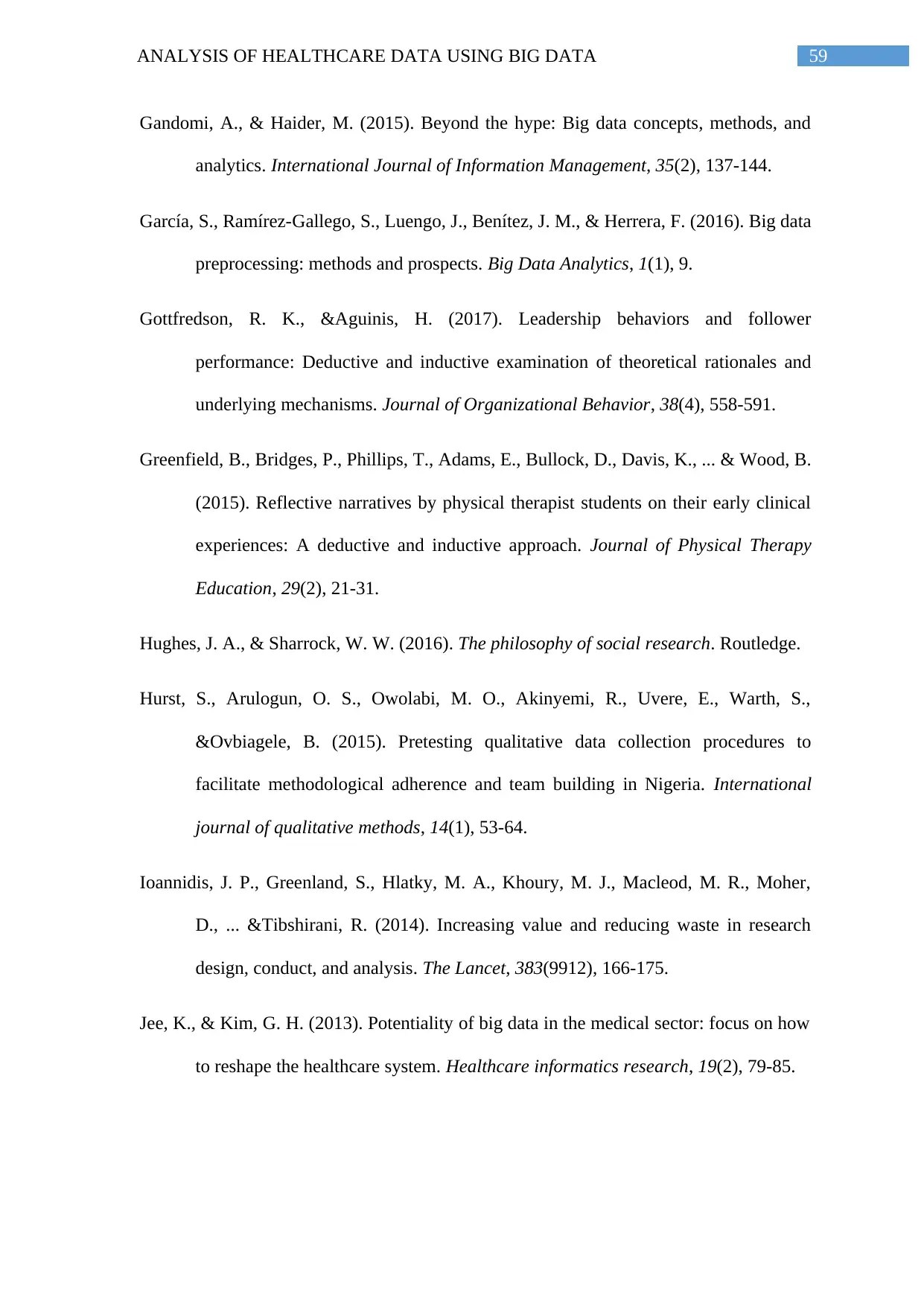
59ANALYSIS OF HEALTHCARE DATA USING BIG DATA
Gandomi, A., & Haider, M. (2015). Beyond the hype: Big data concepts, methods, and
analytics. International Journal of Information Management, 35(2), 137-144.
García, S., Ramírez-Gallego, S., Luengo, J., Benítez, J. M., & Herrera, F. (2016). Big data
preprocessing: methods and prospects. Big Data Analytics, 1(1), 9.
Gottfredson, R. K., &Aguinis, H. (2017). Leadership behaviors and follower
performance: Deductive and inductive examination of theoretical rationales and
underlying mechanisms. Journal of Organizational Behavior, 38(4), 558-591.
Greenfield, B., Bridges, P., Phillips, T., Adams, E., Bullock, D., Davis, K., ... & Wood, B.
(2015). Reflective narratives by physical therapist students on their early clinical
experiences: A deductive and inductive approach. Journal of Physical Therapy
Education, 29(2), 21-31.
Hughes, J. A., & Sharrock, W. W. (2016). The philosophy of social research. Routledge.
Hurst, S., Arulogun, O. S., Owolabi, M. O., Akinyemi, R., Uvere, E., Warth, S.,
&Ovbiagele, B. (2015). Pretesting qualitative data collection procedures to
facilitate methodological adherence and team building in Nigeria. International
journal of qualitative methods, 14(1), 53-64.
Ioannidis, J. P., Greenland, S., Hlatky, M. A., Khoury, M. J., Macleod, M. R., Moher,
D., ... &Tibshirani, R. (2014). Increasing value and reducing waste in research
design, conduct, and analysis. The Lancet, 383(9912), 166-175.
Jee, K., & Kim, G. H. (2013). Potentiality of big data in the medical sector: focus on how
to reshape the healthcare system. Healthcare informatics research, 19(2), 79-85.
Gandomi, A., & Haider, M. (2015). Beyond the hype: Big data concepts, methods, and
analytics. International Journal of Information Management, 35(2), 137-144.
García, S., Ramírez-Gallego, S., Luengo, J., Benítez, J. M., & Herrera, F. (2016). Big data
preprocessing: methods and prospects. Big Data Analytics, 1(1), 9.
Gottfredson, R. K., &Aguinis, H. (2017). Leadership behaviors and follower
performance: Deductive and inductive examination of theoretical rationales and
underlying mechanisms. Journal of Organizational Behavior, 38(4), 558-591.
Greenfield, B., Bridges, P., Phillips, T., Adams, E., Bullock, D., Davis, K., ... & Wood, B.
(2015). Reflective narratives by physical therapist students on their early clinical
experiences: A deductive and inductive approach. Journal of Physical Therapy
Education, 29(2), 21-31.
Hughes, J. A., & Sharrock, W. W. (2016). The philosophy of social research. Routledge.
Hurst, S., Arulogun, O. S., Owolabi, M. O., Akinyemi, R., Uvere, E., Warth, S.,
&Ovbiagele, B. (2015). Pretesting qualitative data collection procedures to
facilitate methodological adherence and team building in Nigeria. International
journal of qualitative methods, 14(1), 53-64.
Ioannidis, J. P., Greenland, S., Hlatky, M. A., Khoury, M. J., Macleod, M. R., Moher,
D., ... &Tibshirani, R. (2014). Increasing value and reducing waste in research
design, conduct, and analysis. The Lancet, 383(9912), 166-175.
Jee, K., & Kim, G. H. (2013). Potentiality of big data in the medical sector: focus on how
to reshape the healthcare system. Healthcare informatics research, 19(2), 79-85.
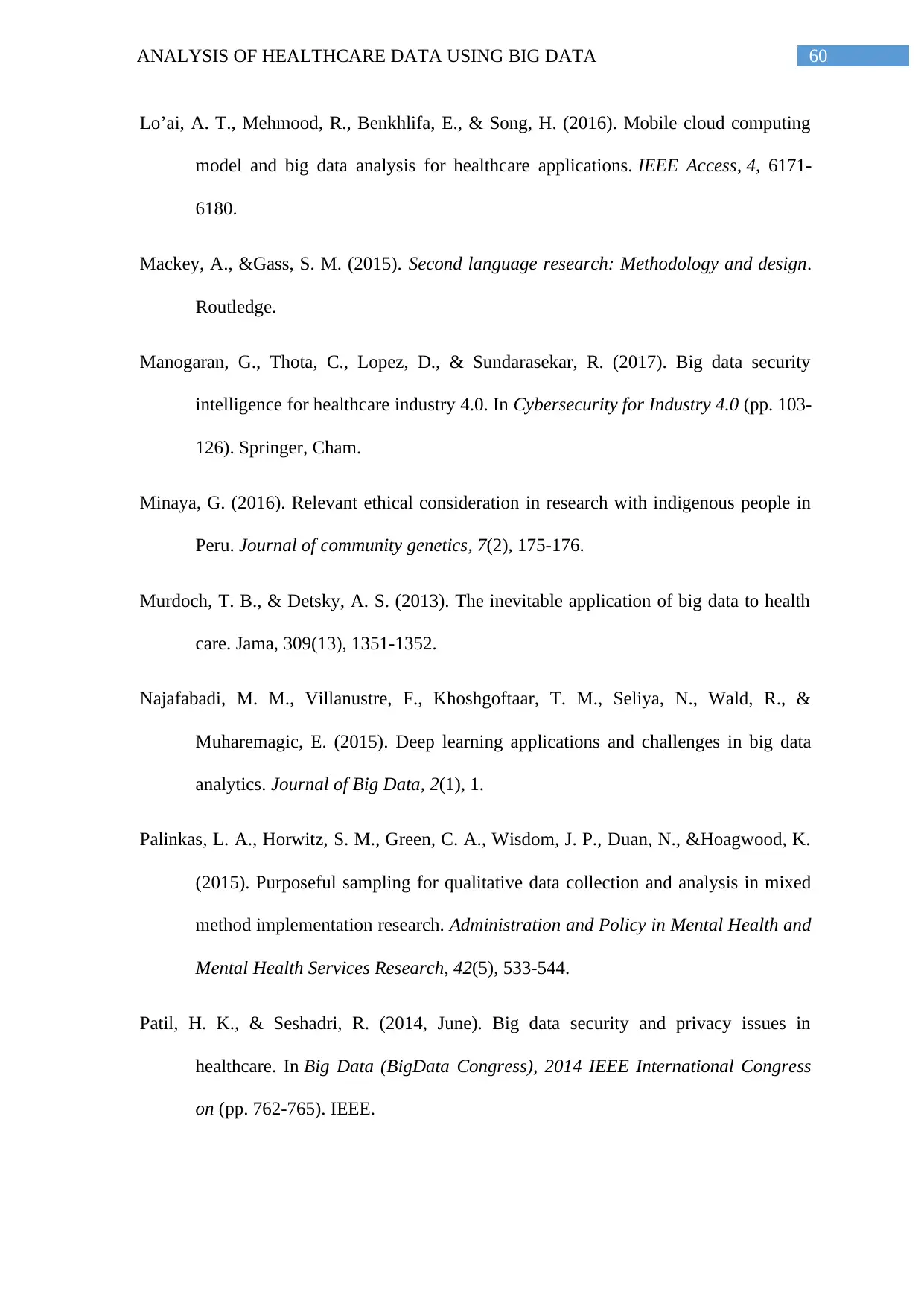
60ANALYSIS OF HEALTHCARE DATA USING BIG DATA
Lo’ai, A. T., Mehmood, R., Benkhlifa, E., & Song, H. (2016). Mobile cloud computing
model and big data analysis for healthcare applications. IEEE Access, 4, 6171-
6180.
Mackey, A., &Gass, S. M. (2015). Second language research: Methodology and design.
Routledge.
Manogaran, G., Thota, C., Lopez, D., & Sundarasekar, R. (2017). Big data security
intelligence for healthcare industry 4.0. In Cybersecurity for Industry 4.0 (pp. 103-
126). Springer, Cham.
Minaya, G. (2016). Relevant ethical consideration in research with indigenous people in
Peru. Journal of community genetics, 7(2), 175-176.
Murdoch, T. B., & Detsky, A. S. (2013). The inevitable application of big data to health
care. Jama, 309(13), 1351-1352.
Najafabadi, M. M., Villanustre, F., Khoshgoftaar, T. M., Seliya, N., Wald, R., &
Muharemagic, E. (2015). Deep learning applications and challenges in big data
analytics. Journal of Big Data, 2(1), 1.
Palinkas, L. A., Horwitz, S. M., Green, C. A., Wisdom, J. P., Duan, N., &Hoagwood, K.
(2015). Purposeful sampling for qualitative data collection and analysis in mixed
method implementation research. Administration and Policy in Mental Health and
Mental Health Services Research, 42(5), 533-544.
Patil, H. K., & Seshadri, R. (2014, June). Big data security and privacy issues in
healthcare. In Big Data (BigData Congress), 2014 IEEE International Congress
on (pp. 762-765). IEEE.
Lo’ai, A. T., Mehmood, R., Benkhlifa, E., & Song, H. (2016). Mobile cloud computing
model and big data analysis for healthcare applications. IEEE Access, 4, 6171-
6180.
Mackey, A., &Gass, S. M. (2015). Second language research: Methodology and design.
Routledge.
Manogaran, G., Thota, C., Lopez, D., & Sundarasekar, R. (2017). Big data security
intelligence for healthcare industry 4.0. In Cybersecurity for Industry 4.0 (pp. 103-
126). Springer, Cham.
Minaya, G. (2016). Relevant ethical consideration in research with indigenous people in
Peru. Journal of community genetics, 7(2), 175-176.
Murdoch, T. B., & Detsky, A. S. (2013). The inevitable application of big data to health
care. Jama, 309(13), 1351-1352.
Najafabadi, M. M., Villanustre, F., Khoshgoftaar, T. M., Seliya, N., Wald, R., &
Muharemagic, E. (2015). Deep learning applications and challenges in big data
analytics. Journal of Big Data, 2(1), 1.
Palinkas, L. A., Horwitz, S. M., Green, C. A., Wisdom, J. P., Duan, N., &Hoagwood, K.
(2015). Purposeful sampling for qualitative data collection and analysis in mixed
method implementation research. Administration and Policy in Mental Health and
Mental Health Services Research, 42(5), 533-544.
Patil, H. K., & Seshadri, R. (2014, June). Big data security and privacy issues in
healthcare. In Big Data (BigData Congress), 2014 IEEE International Congress
on (pp. 762-765). IEEE.
Paraphrase This Document
Need a fresh take? Get an instant paraphrase of this document with our AI Paraphraser
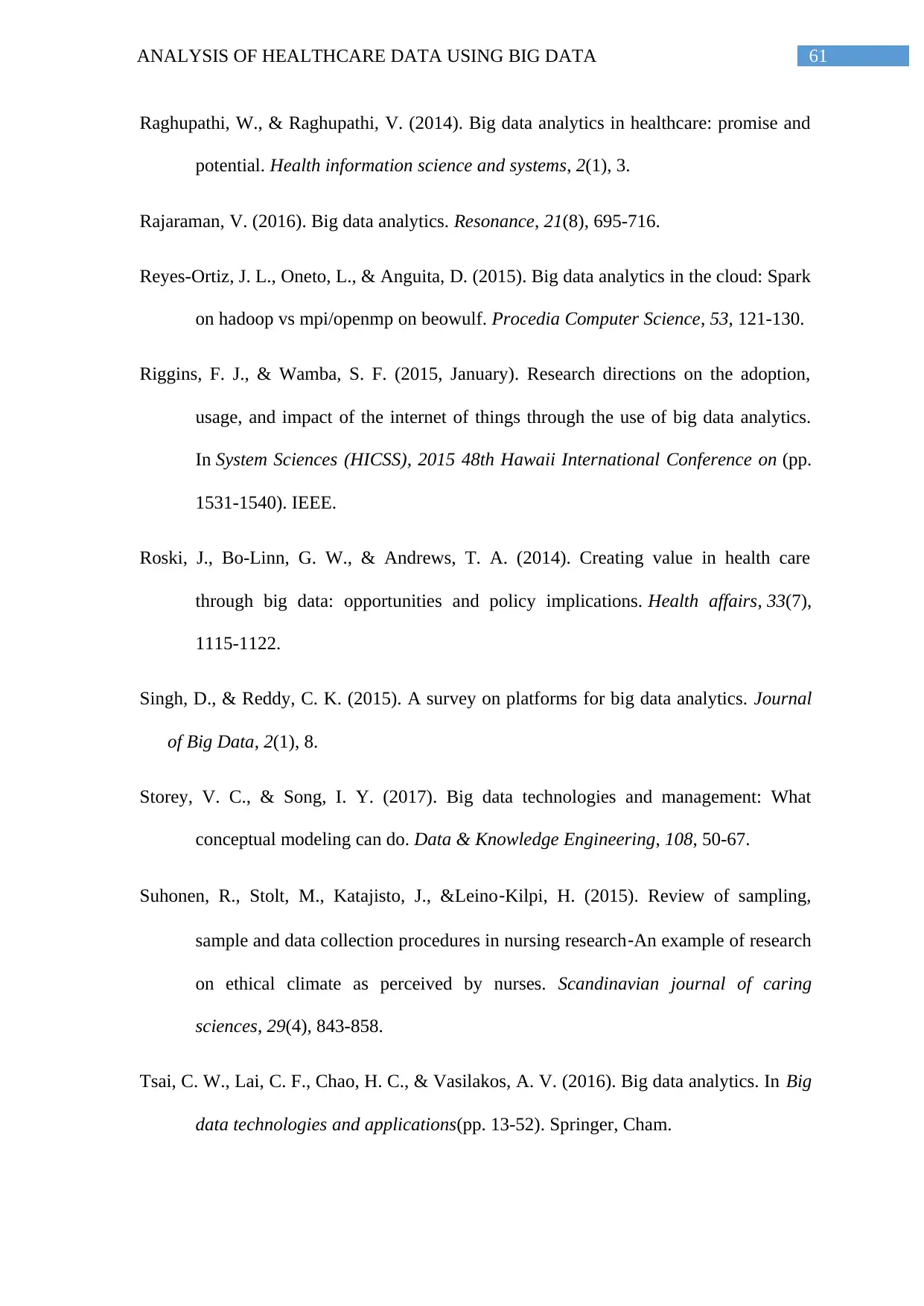
61ANALYSIS OF HEALTHCARE DATA USING BIG DATA
Raghupathi, W., & Raghupathi, V. (2014). Big data analytics in healthcare: promise and
potential. Health information science and systems, 2(1), 3.
Rajaraman, V. (2016). Big data analytics. Resonance, 21(8), 695-716.
Reyes-Ortiz, J. L., Oneto, L., & Anguita, D. (2015). Big data analytics in the cloud: Spark
on hadoop vs mpi/openmp on beowulf. Procedia Computer Science, 53, 121-130.
Riggins, F. J., & Wamba, S. F. (2015, January). Research directions on the adoption,
usage, and impact of the internet of things through the use of big data analytics.
In System Sciences (HICSS), 2015 48th Hawaii International Conference on (pp.
1531-1540). IEEE.
Roski, J., Bo-Linn, G. W., & Andrews, T. A. (2014). Creating value in health care
through big data: opportunities and policy implications. Health affairs, 33(7),
1115-1122.
Singh, D., & Reddy, C. K. (2015). A survey on platforms for big data analytics. Journal
of Big Data, 2(1), 8.
Storey, V. C., & Song, I. Y. (2017). Big data technologies and management: What
conceptual modeling can do. Data & Knowledge Engineering, 108, 50-67.
Suhonen, R., Stolt, M., Katajisto, J., &Leino‐Kilpi, H. (2015). Review of sampling,
sample and data collection procedures in nursing research‐An example of research
on ethical climate as perceived by nurses. Scandinavian journal of caring
sciences, 29(4), 843-858.
Tsai, C. W., Lai, C. F., Chao, H. C., & Vasilakos, A. V. (2016). Big data analytics. In Big
data technologies and applications(pp. 13-52). Springer, Cham.
Raghupathi, W., & Raghupathi, V. (2014). Big data analytics in healthcare: promise and
potential. Health information science and systems, 2(1), 3.
Rajaraman, V. (2016). Big data analytics. Resonance, 21(8), 695-716.
Reyes-Ortiz, J. L., Oneto, L., & Anguita, D. (2015). Big data analytics in the cloud: Spark
on hadoop vs mpi/openmp on beowulf. Procedia Computer Science, 53, 121-130.
Riggins, F. J., & Wamba, S. F. (2015, January). Research directions on the adoption,
usage, and impact of the internet of things through the use of big data analytics.
In System Sciences (HICSS), 2015 48th Hawaii International Conference on (pp.
1531-1540). IEEE.
Roski, J., Bo-Linn, G. W., & Andrews, T. A. (2014). Creating value in health care
through big data: opportunities and policy implications. Health affairs, 33(7),
1115-1122.
Singh, D., & Reddy, C. K. (2015). A survey on platforms for big data analytics. Journal
of Big Data, 2(1), 8.
Storey, V. C., & Song, I. Y. (2017). Big data technologies and management: What
conceptual modeling can do. Data & Knowledge Engineering, 108, 50-67.
Suhonen, R., Stolt, M., Katajisto, J., &Leino‐Kilpi, H. (2015). Review of sampling,
sample and data collection procedures in nursing research‐An example of research
on ethical climate as perceived by nurses. Scandinavian journal of caring
sciences, 29(4), 843-858.
Tsai, C. W., Lai, C. F., Chao, H. C., & Vasilakos, A. V. (2016). Big data analytics. In Big
data technologies and applications(pp. 13-52). Springer, Cham.
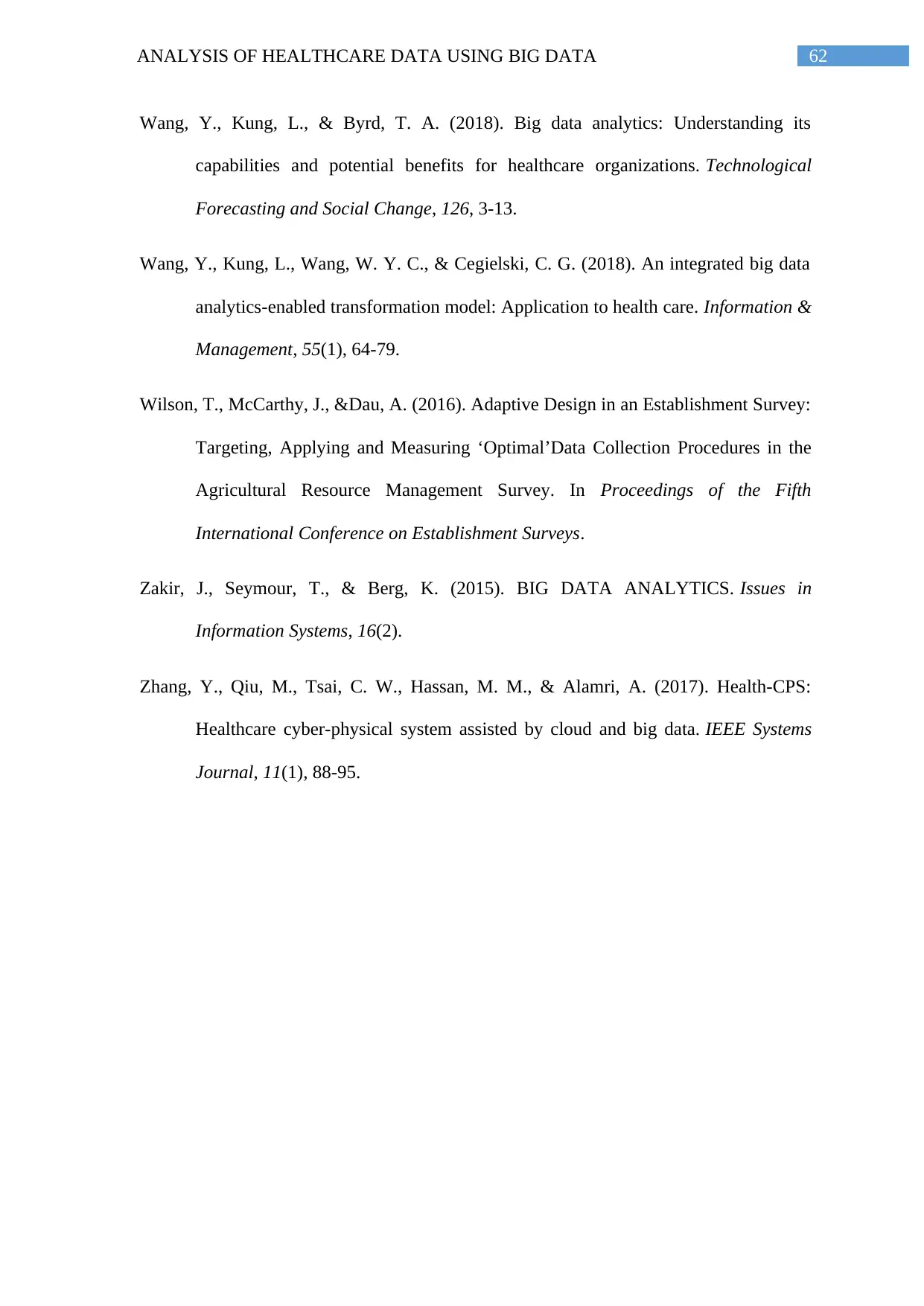
62ANALYSIS OF HEALTHCARE DATA USING BIG DATA
Wang, Y., Kung, L., & Byrd, T. A. (2018). Big data analytics: Understanding its
capabilities and potential benefits for healthcare organizations. Technological
Forecasting and Social Change, 126, 3-13.
Wang, Y., Kung, L., Wang, W. Y. C., & Cegielski, C. G. (2018). An integrated big data
analytics-enabled transformation model: Application to health care. Information &
Management, 55(1), 64-79.
Wilson, T., McCarthy, J., &Dau, A. (2016). Adaptive Design in an Establishment Survey:
Targeting, Applying and Measuring ‘Optimal’Data Collection Procedures in the
Agricultural Resource Management Survey. In Proceedings of the Fifth
International Conference on Establishment Surveys.
Zakir, J., Seymour, T., & Berg, K. (2015). BIG DATA ANALYTICS. Issues in
Information Systems, 16(2).
Zhang, Y., Qiu, M., Tsai, C. W., Hassan, M. M., & Alamri, A. (2017). Health-CPS:
Healthcare cyber-physical system assisted by cloud and big data. IEEE Systems
Journal, 11(1), 88-95.
Wang, Y., Kung, L., & Byrd, T. A. (2018). Big data analytics: Understanding its
capabilities and potential benefits for healthcare organizations. Technological
Forecasting and Social Change, 126, 3-13.
Wang, Y., Kung, L., Wang, W. Y. C., & Cegielski, C. G. (2018). An integrated big data
analytics-enabled transformation model: Application to health care. Information &
Management, 55(1), 64-79.
Wilson, T., McCarthy, J., &Dau, A. (2016). Adaptive Design in an Establishment Survey:
Targeting, Applying and Measuring ‘Optimal’Data Collection Procedures in the
Agricultural Resource Management Survey. In Proceedings of the Fifth
International Conference on Establishment Surveys.
Zakir, J., Seymour, T., & Berg, K. (2015). BIG DATA ANALYTICS. Issues in
Information Systems, 16(2).
Zhang, Y., Qiu, M., Tsai, C. W., Hassan, M. M., & Alamri, A. (2017). Health-CPS:
Healthcare cyber-physical system assisted by cloud and big data. IEEE Systems
Journal, 11(1), 88-95.
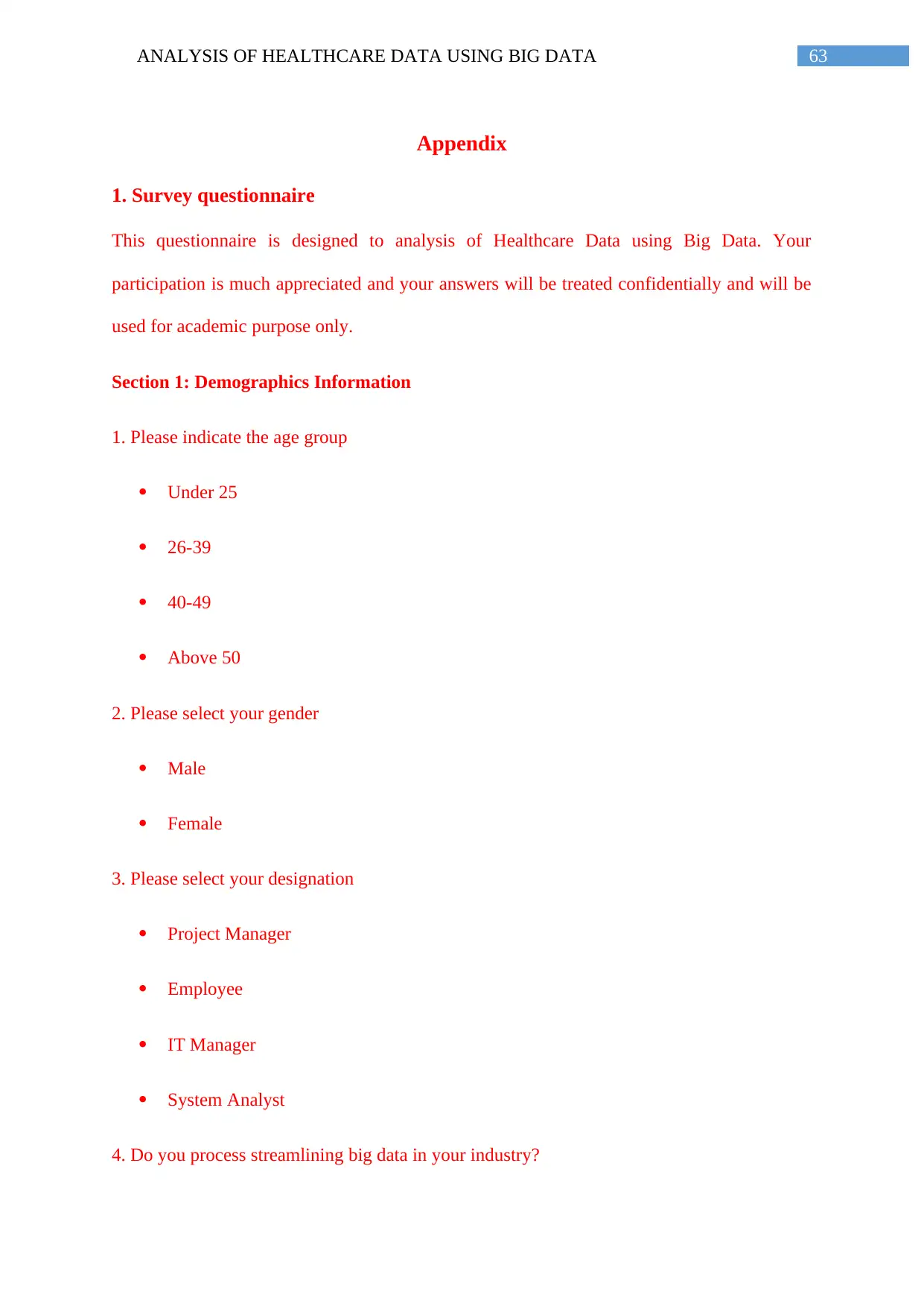
63ANALYSIS OF HEALTHCARE DATA USING BIG DATA
Appendix
1. Survey questionnaire
This questionnaire is designed to analysis of Healthcare Data using Big Data. Your
participation is much appreciated and your answers will be treated confidentially and will be
used for academic purpose only.
Section 1: Demographics Information
1. Please indicate the age group
Under 25
26-39
40-49
Above 50
2. Please select your gender
Male
Female
3. Please select your designation
Project Manager
Employee
IT Manager
System Analyst
4. Do you process streamlining big data in your industry?
Appendix
1. Survey questionnaire
This questionnaire is designed to analysis of Healthcare Data using Big Data. Your
participation is much appreciated and your answers will be treated confidentially and will be
used for academic purpose only.
Section 1: Demographics Information
1. Please indicate the age group
Under 25
26-39
40-49
Above 50
2. Please select your gender
Male
Female
3. Please select your designation
Project Manager
Employee
IT Manager
System Analyst
4. Do you process streamlining big data in your industry?
Secure Best Marks with AI Grader
Need help grading? Try our AI Grader for instant feedback on your assignments.
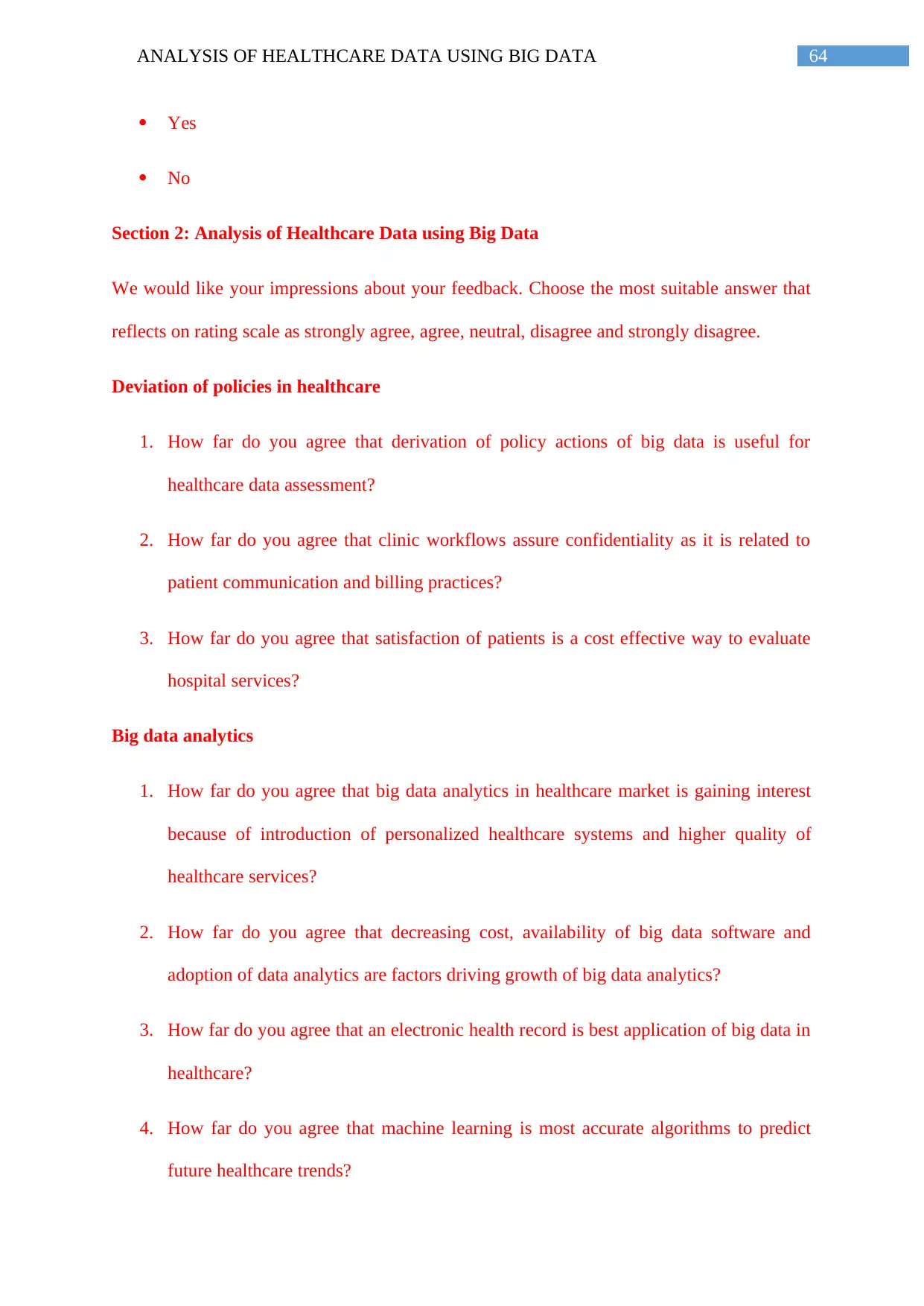
64ANALYSIS OF HEALTHCARE DATA USING BIG DATA
Yes
No
Section 2: Analysis of Healthcare Data using Big Data
We would like your impressions about your feedback. Choose the most suitable answer that
reflects on rating scale as strongly agree, agree, neutral, disagree and strongly disagree.
Deviation of policies in healthcare
1. How far do you agree that derivation of policy actions of big data is useful for
healthcare data assessment?
2. How far do you agree that clinic workflows assure confidentiality as it is related to
patient communication and billing practices?
3. How far do you agree that satisfaction of patients is a cost effective way to evaluate
hospital services?
Big data analytics
1. How far do you agree that big data analytics in healthcare market is gaining interest
because of introduction of personalized healthcare systems and higher quality of
healthcare services?
2. How far do you agree that decreasing cost, availability of big data software and
adoption of data analytics are factors driving growth of big data analytics?
3. How far do you agree that an electronic health record is best application of big data in
healthcare?
4. How far do you agree that machine learning is most accurate algorithms to predict
future healthcare trends?
Yes
No
Section 2: Analysis of Healthcare Data using Big Data
We would like your impressions about your feedback. Choose the most suitable answer that
reflects on rating scale as strongly agree, agree, neutral, disagree and strongly disagree.
Deviation of policies in healthcare
1. How far do you agree that derivation of policy actions of big data is useful for
healthcare data assessment?
2. How far do you agree that clinic workflows assure confidentiality as it is related to
patient communication and billing practices?
3. How far do you agree that satisfaction of patients is a cost effective way to evaluate
hospital services?
Big data analytics
1. How far do you agree that big data analytics in healthcare market is gaining interest
because of introduction of personalized healthcare systems and higher quality of
healthcare services?
2. How far do you agree that decreasing cost, availability of big data software and
adoption of data analytics are factors driving growth of big data analytics?
3. How far do you agree that an electronic health record is best application of big data in
healthcare?
4. How far do you agree that machine learning is most accurate algorithms to predict
future healthcare trends?
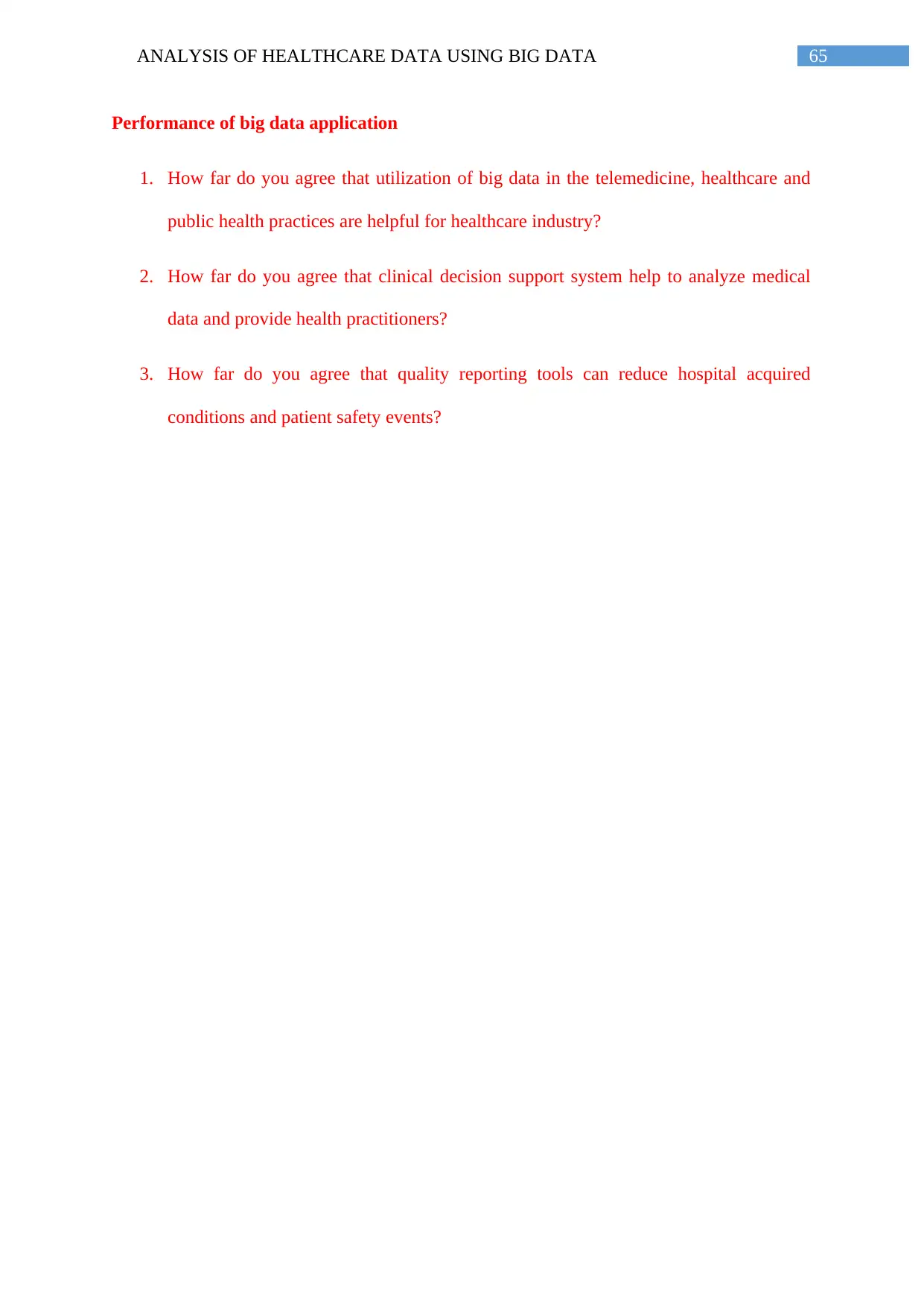
65ANALYSIS OF HEALTHCARE DATA USING BIG DATA
Performance of big data application
1. How far do you agree that utilization of big data in the telemedicine, healthcare and
public health practices are helpful for healthcare industry?
2. How far do you agree that clinical decision support system help to analyze medical
data and provide health practitioners?
3. How far do you agree that quality reporting tools can reduce hospital acquired
conditions and patient safety events?
Performance of big data application
1. How far do you agree that utilization of big data in the telemedicine, healthcare and
public health practices are helpful for healthcare industry?
2. How far do you agree that clinical decision support system help to analyze medical
data and provide health practitioners?
3. How far do you agree that quality reporting tools can reduce hospital acquired
conditions and patient safety events?
1 out of 66
Related Documents
Your All-in-One AI-Powered Toolkit for Academic Success.
+13062052269
info@desklib.com
Available 24*7 on WhatsApp / Email
![[object Object]](/_next/static/media/star-bottom.7253800d.svg)
Unlock your academic potential
© 2024 | Zucol Services PVT LTD | All rights reserved.





